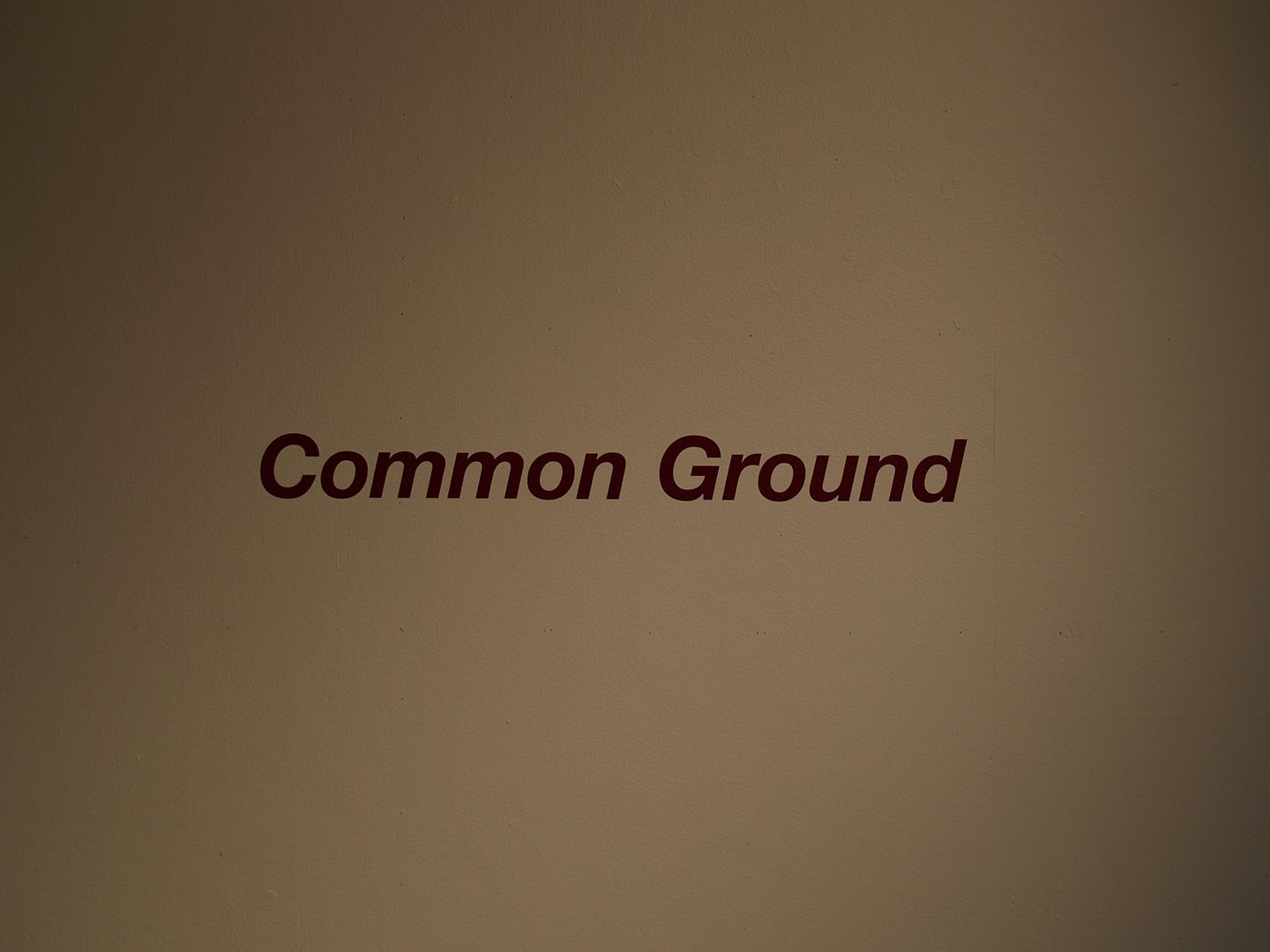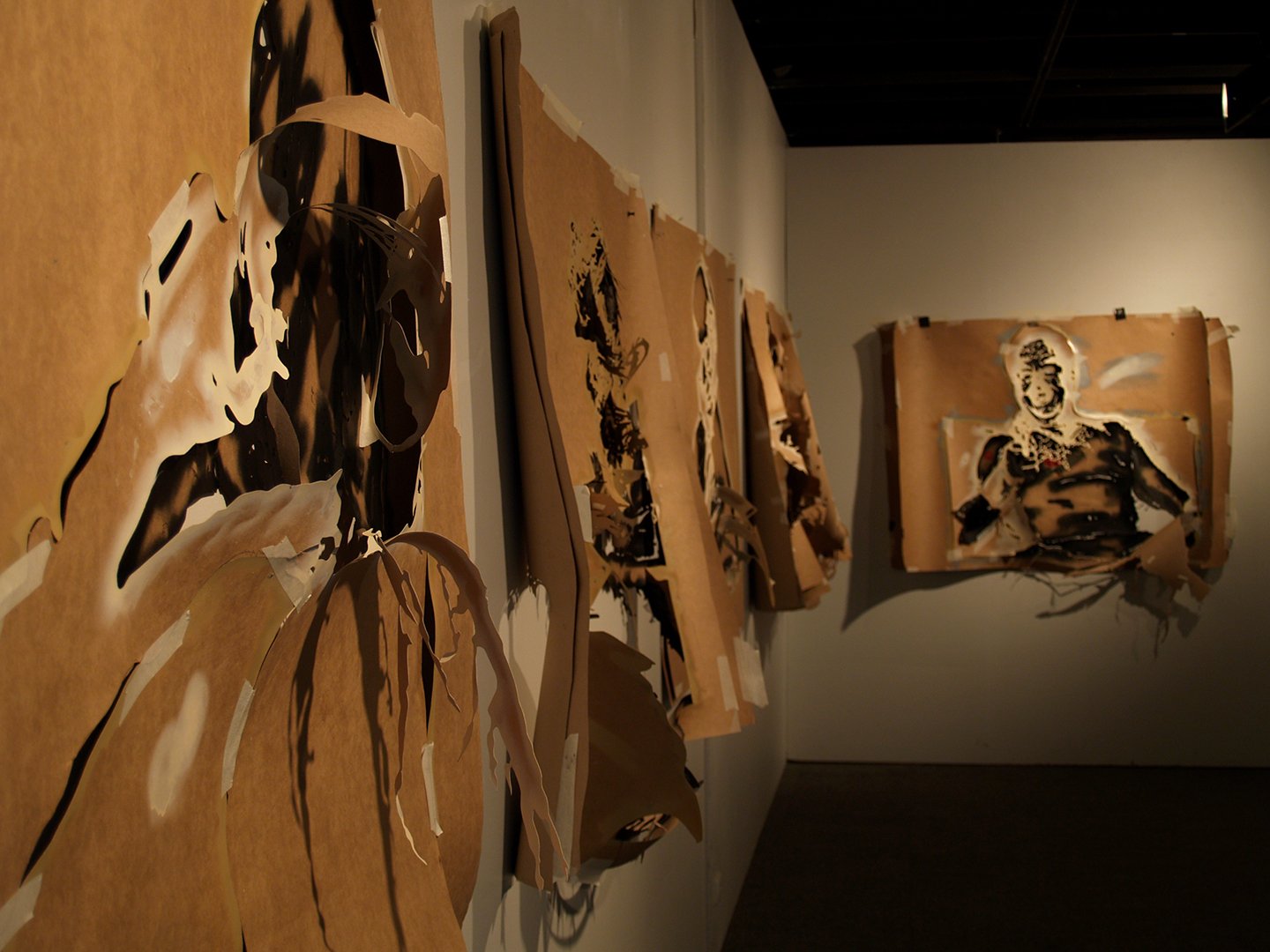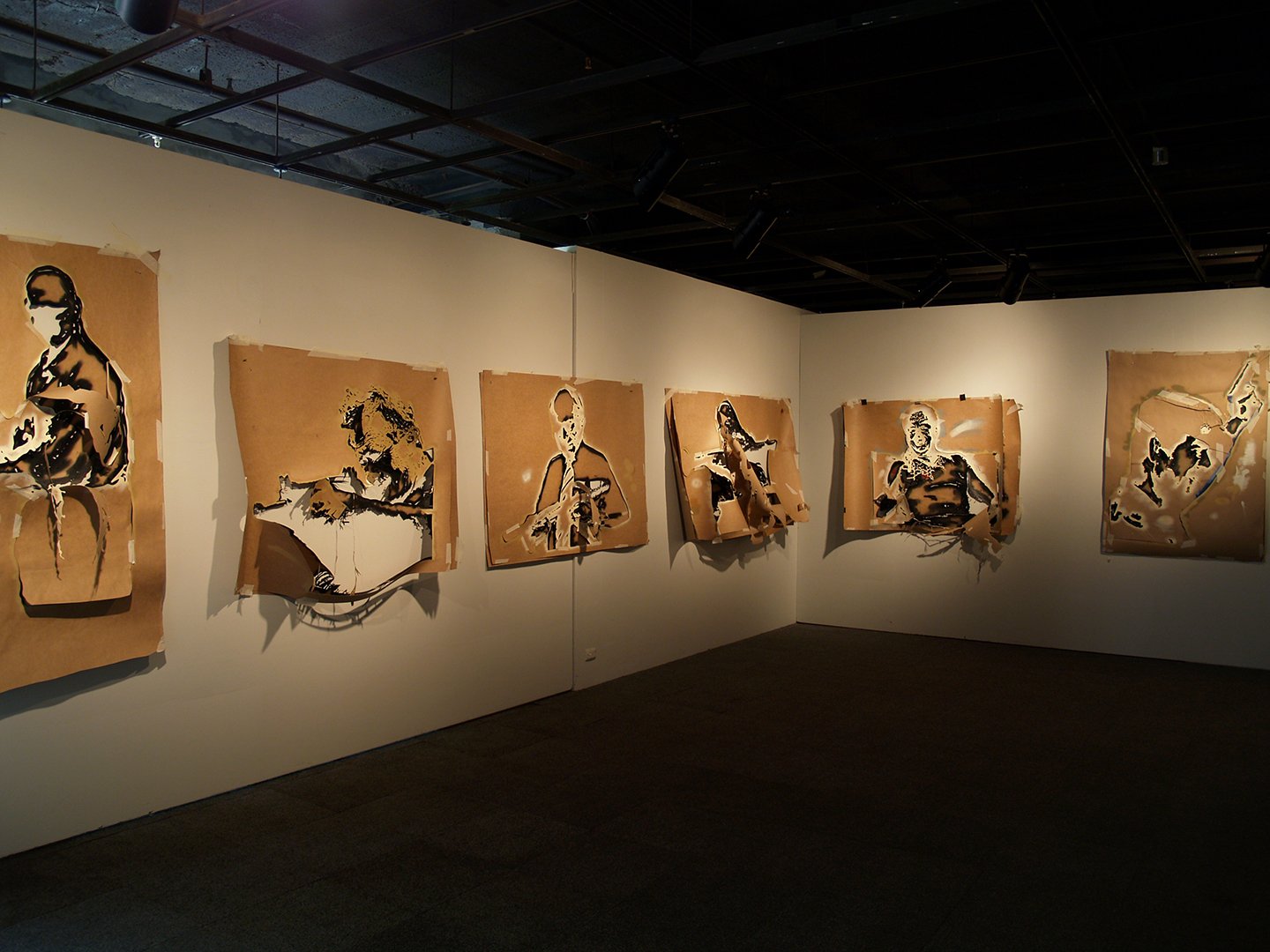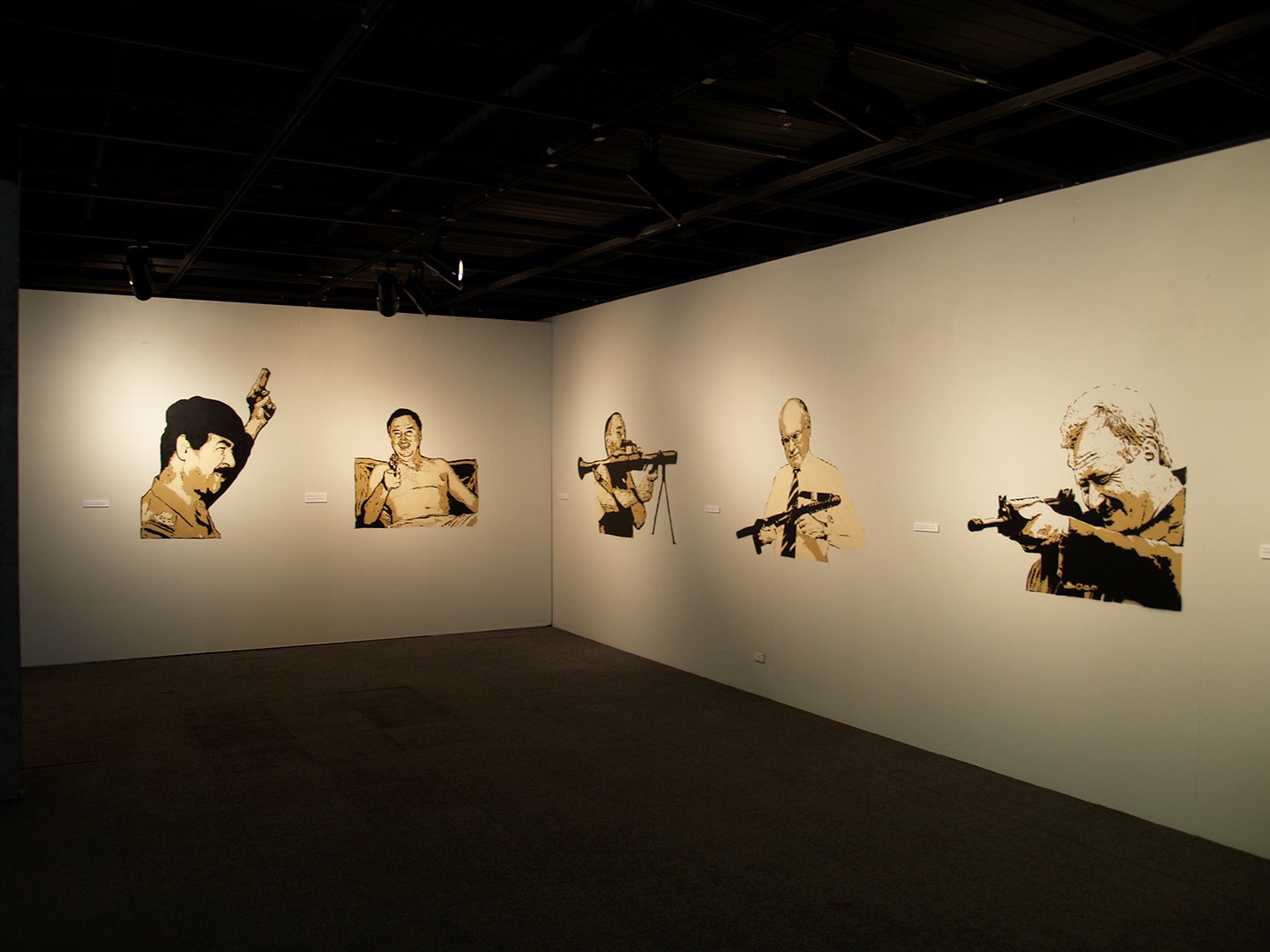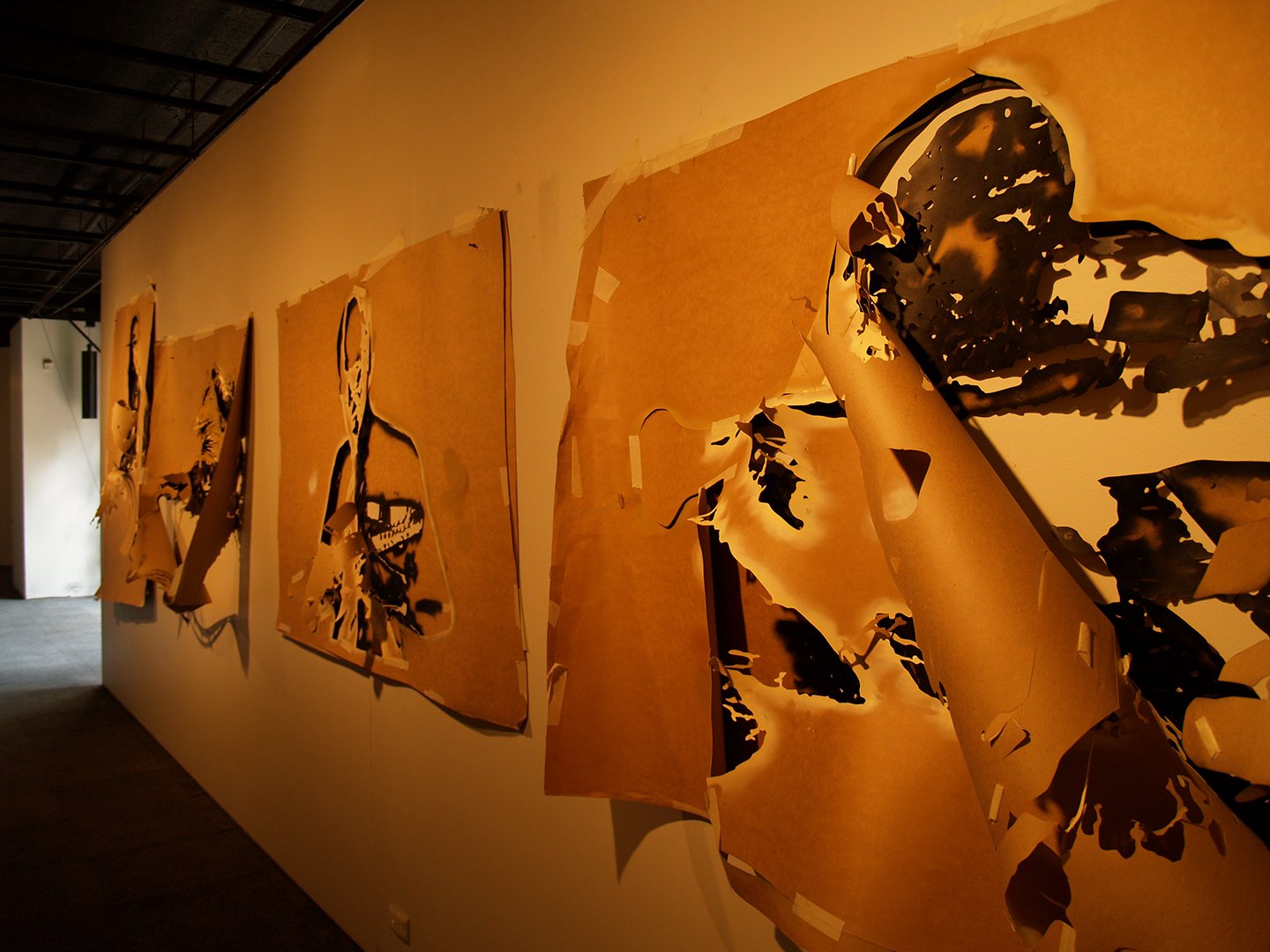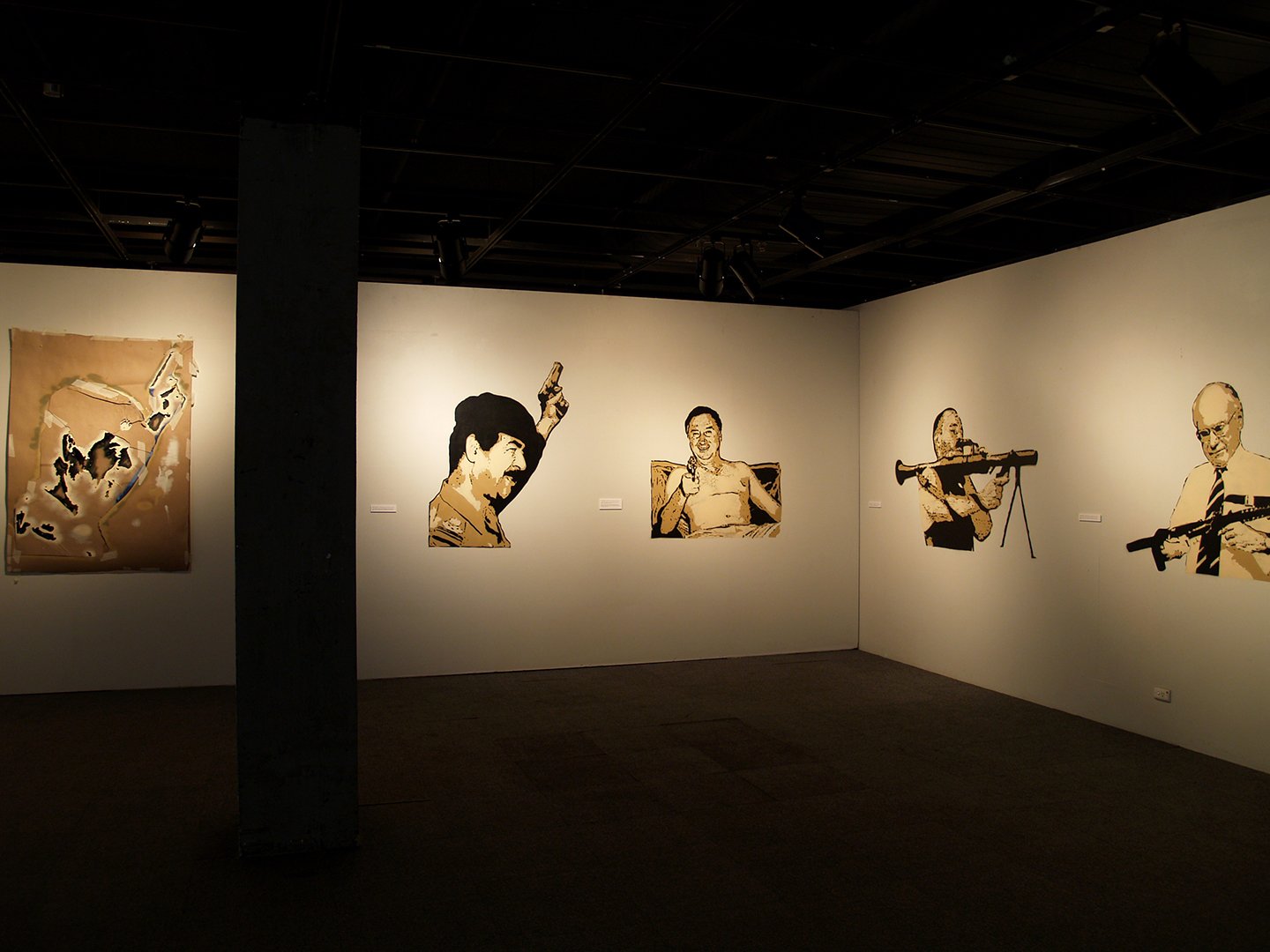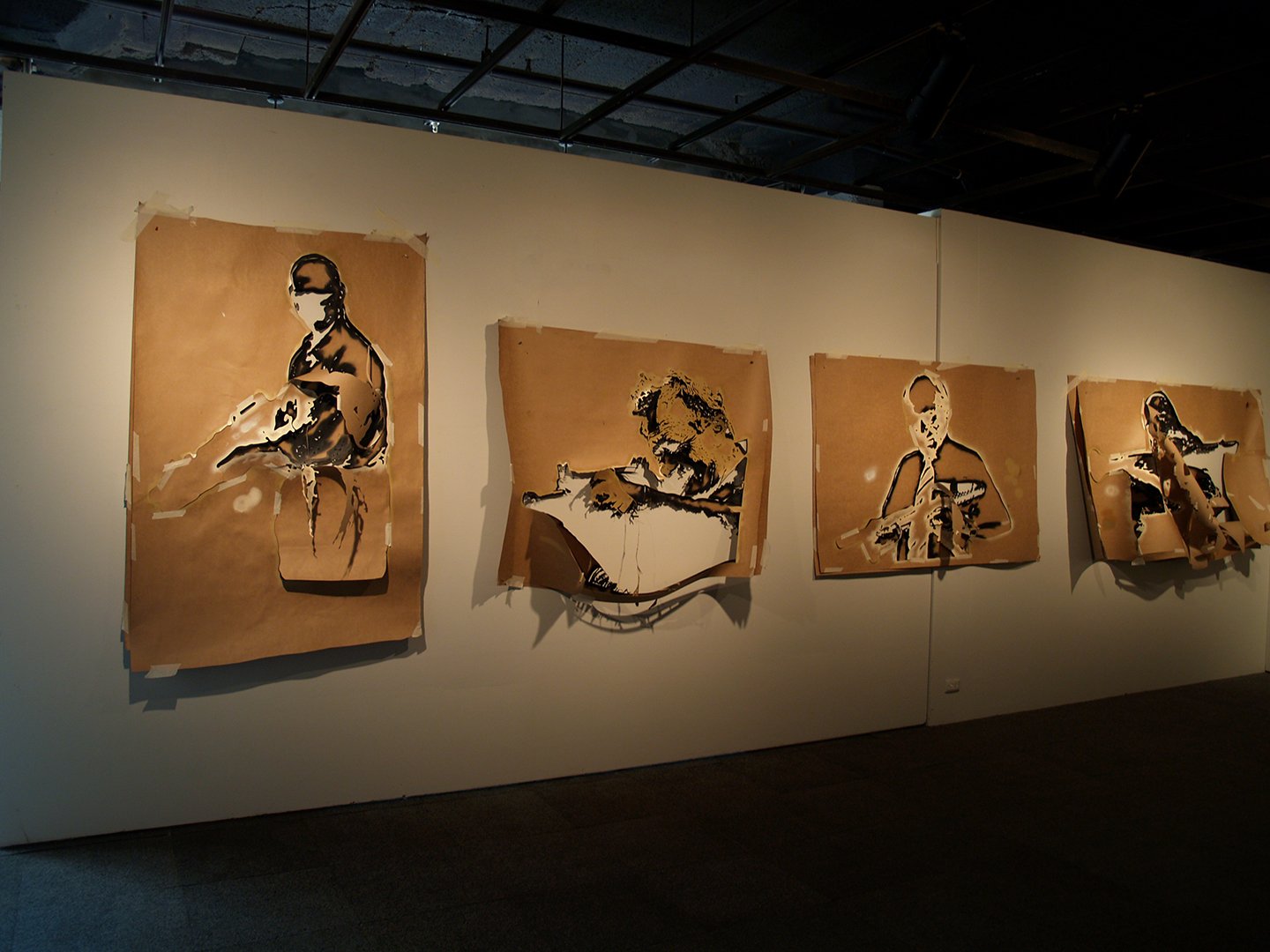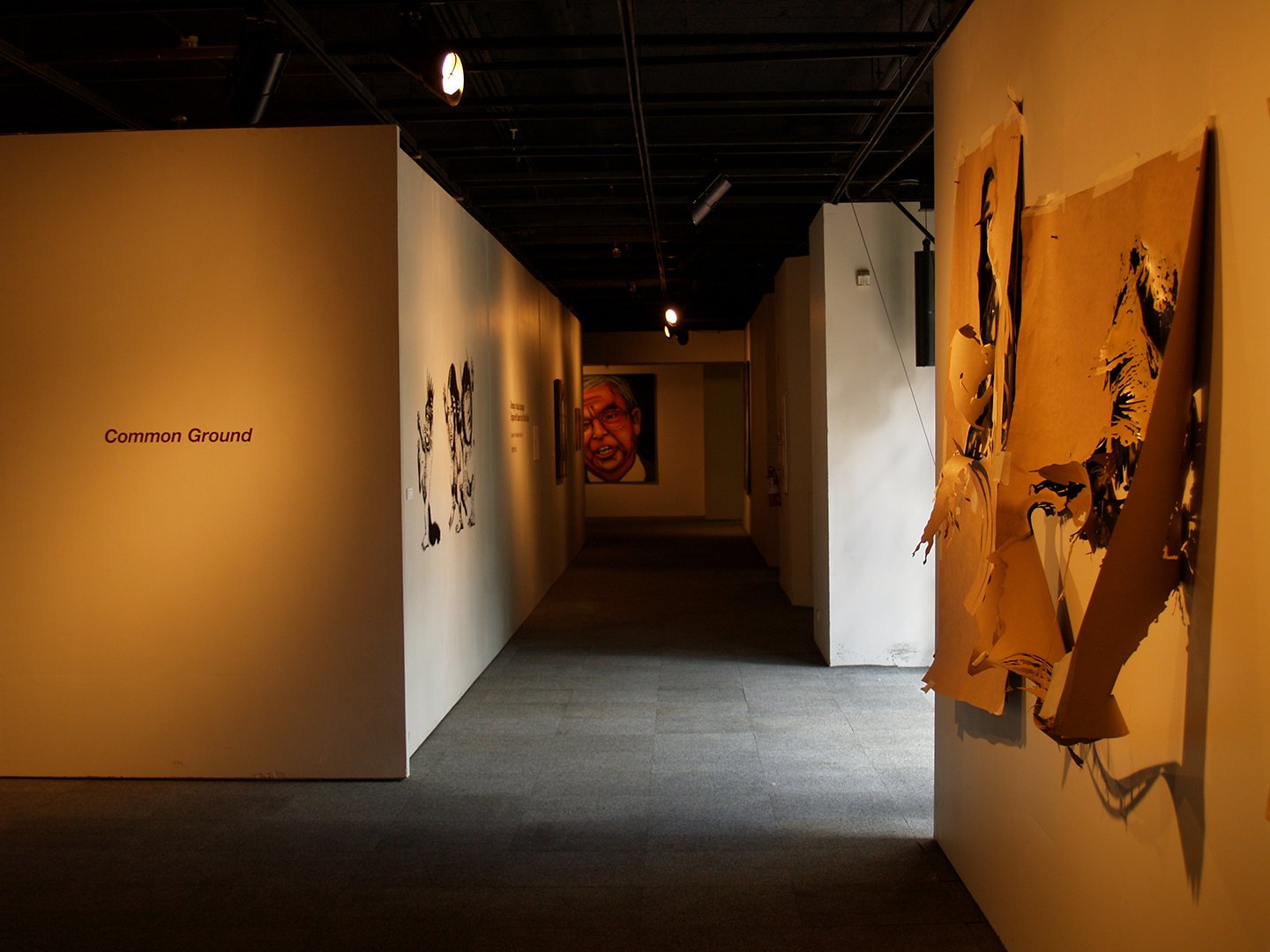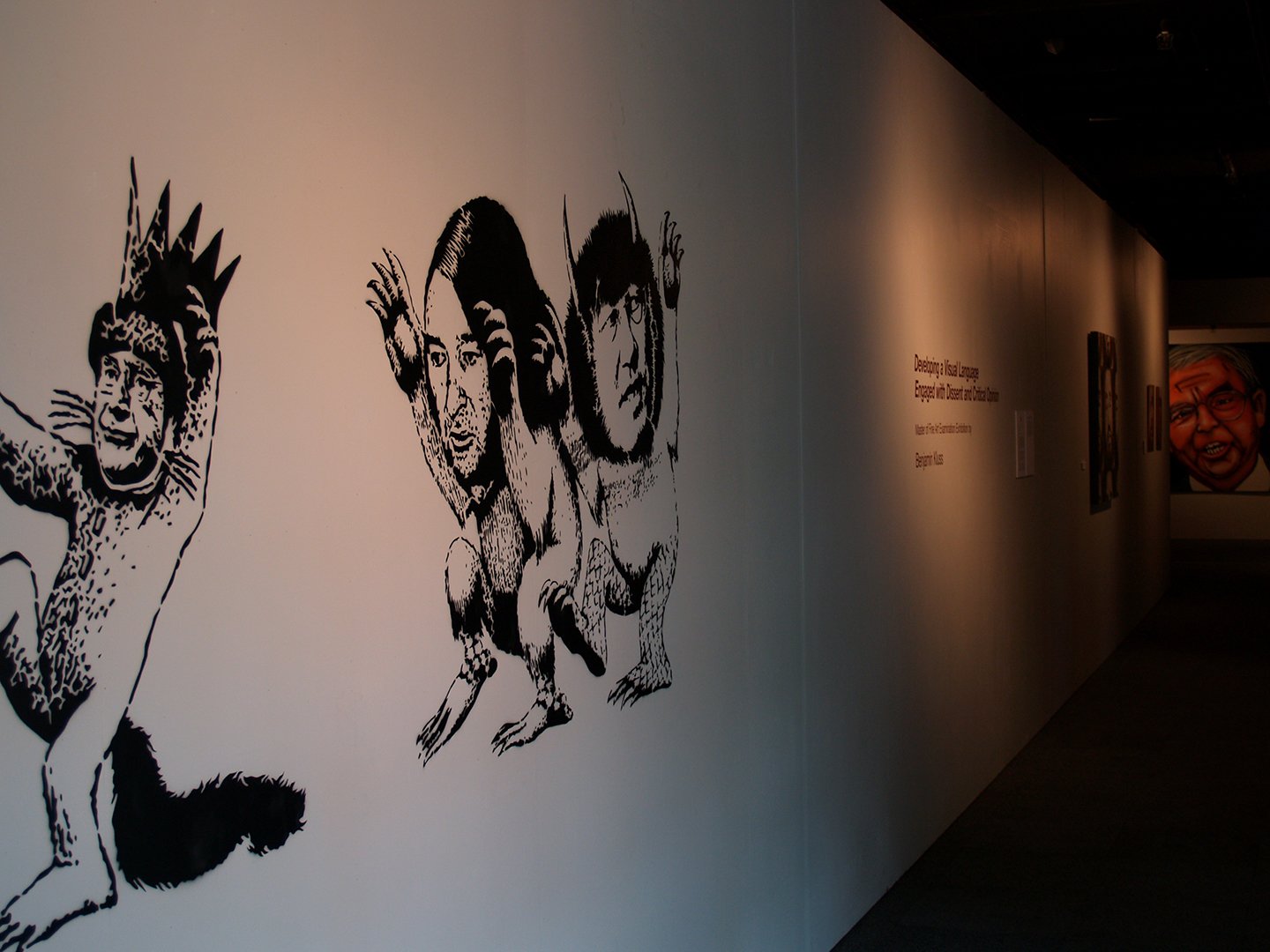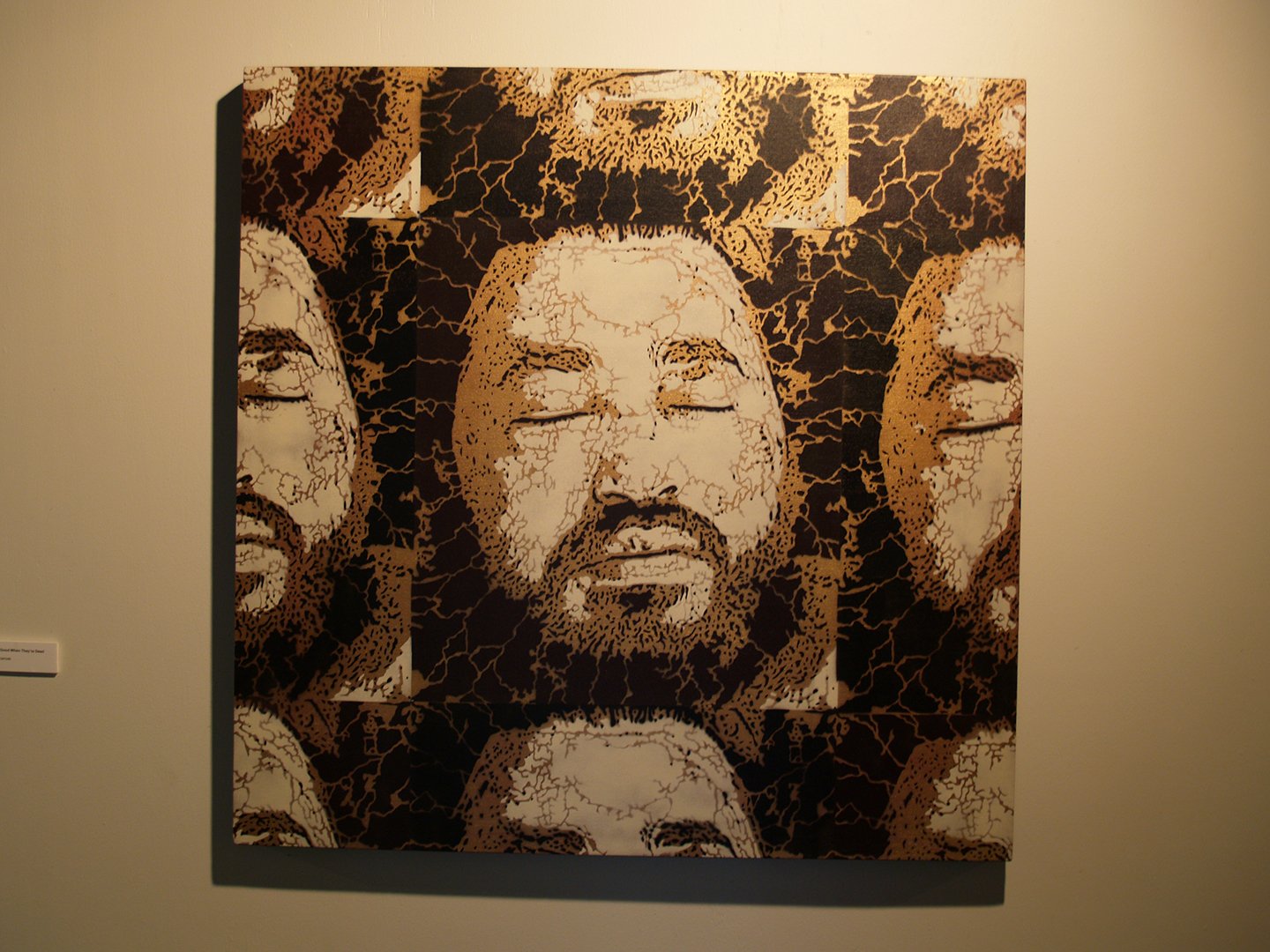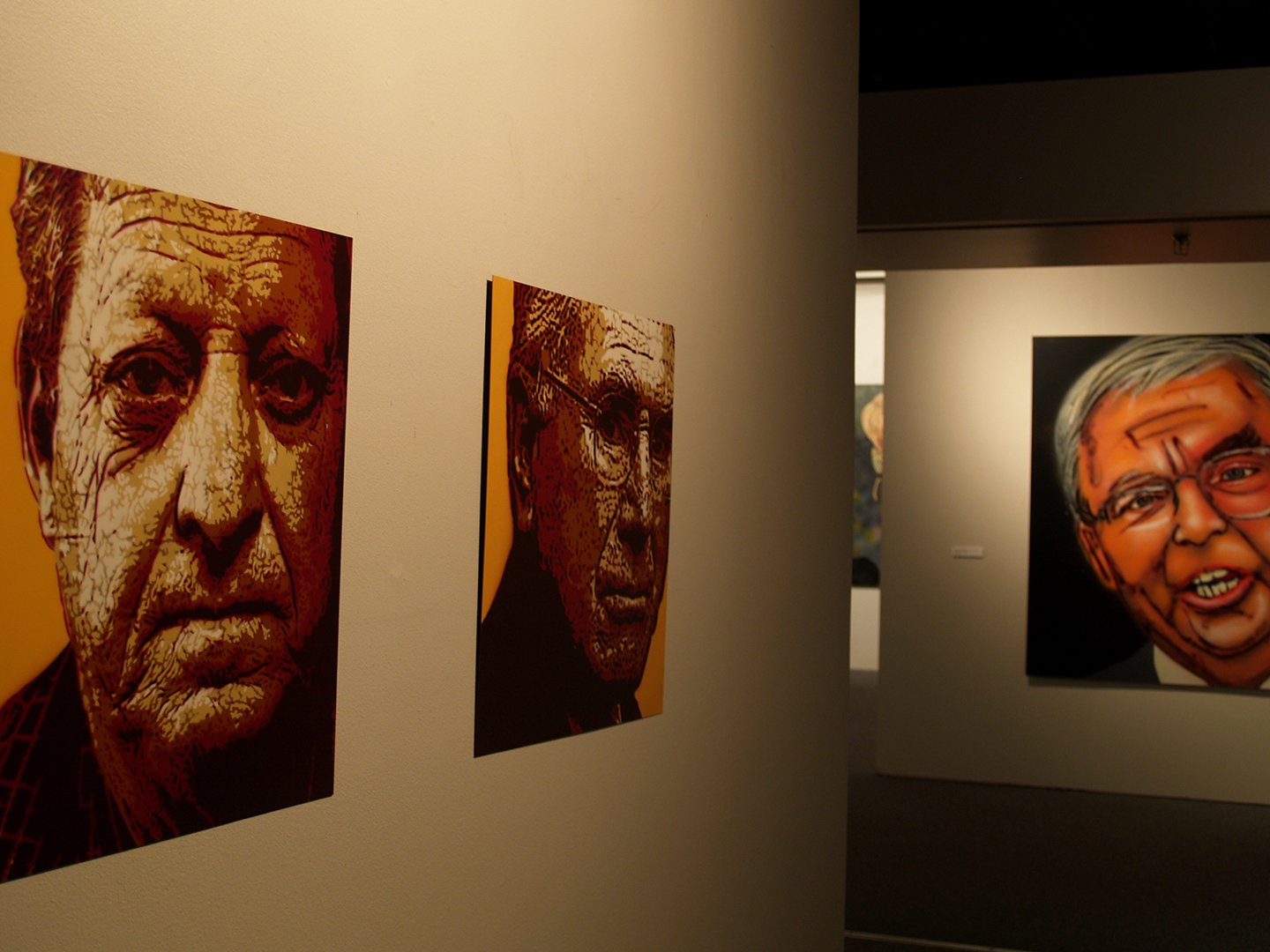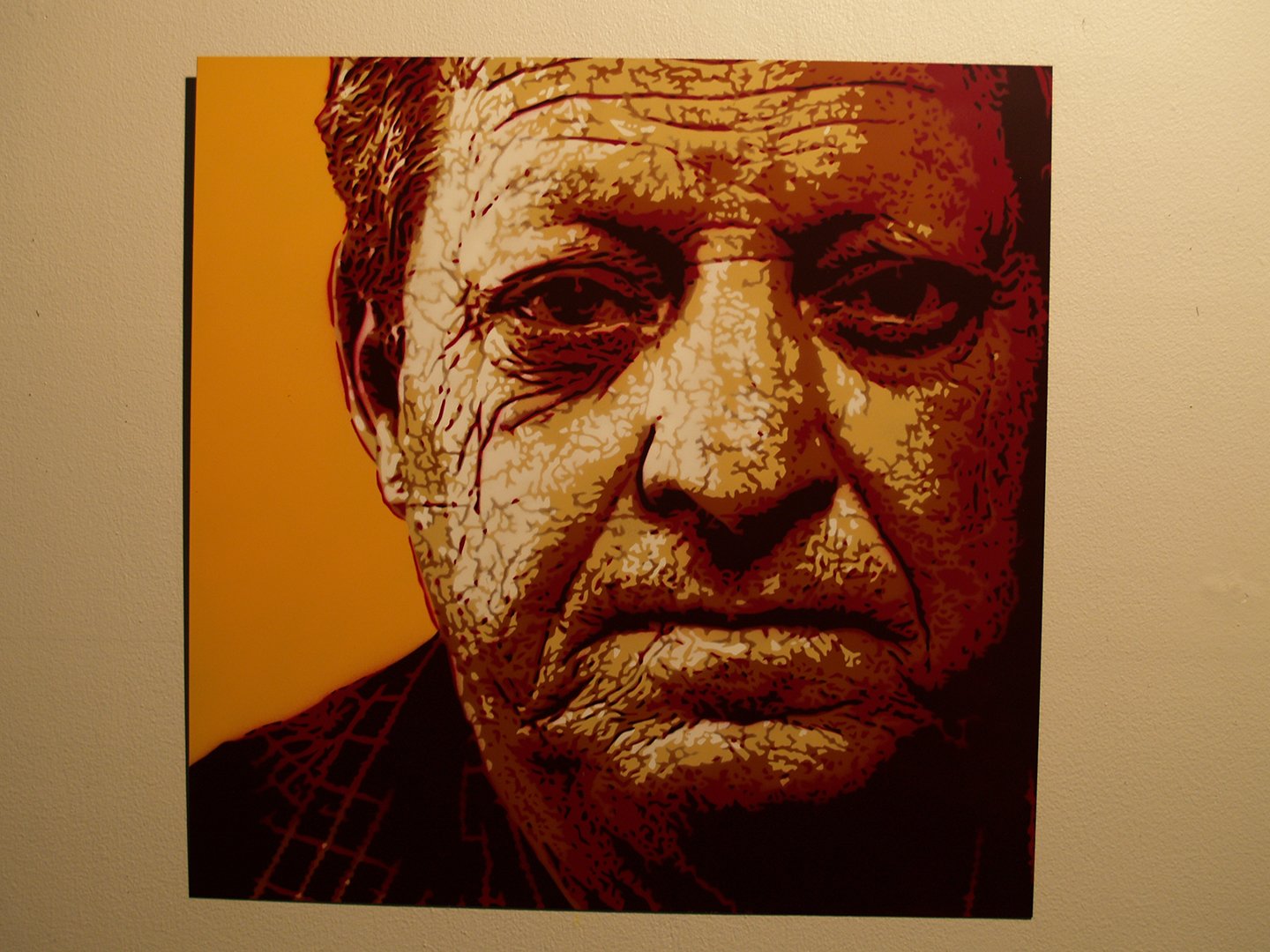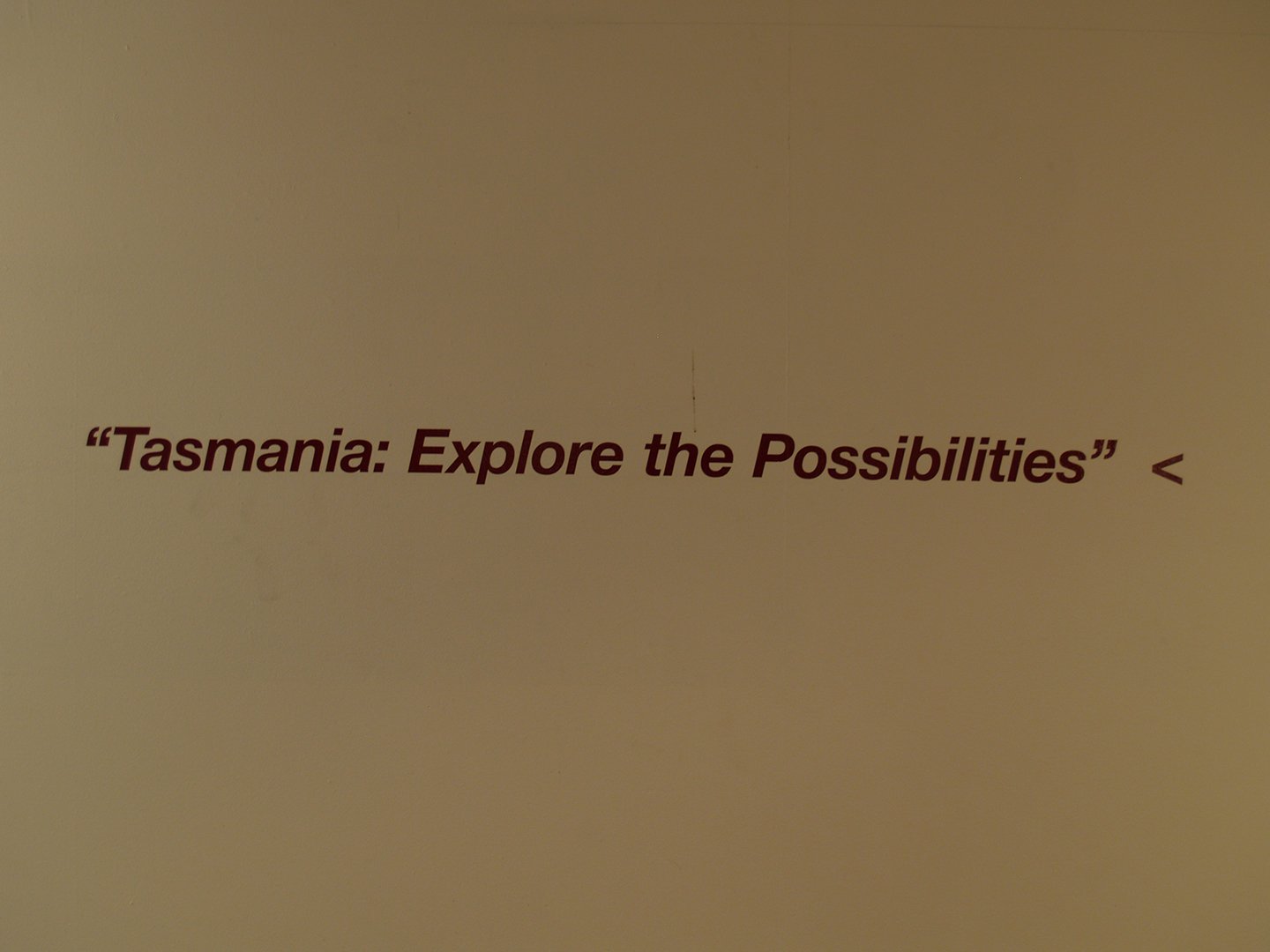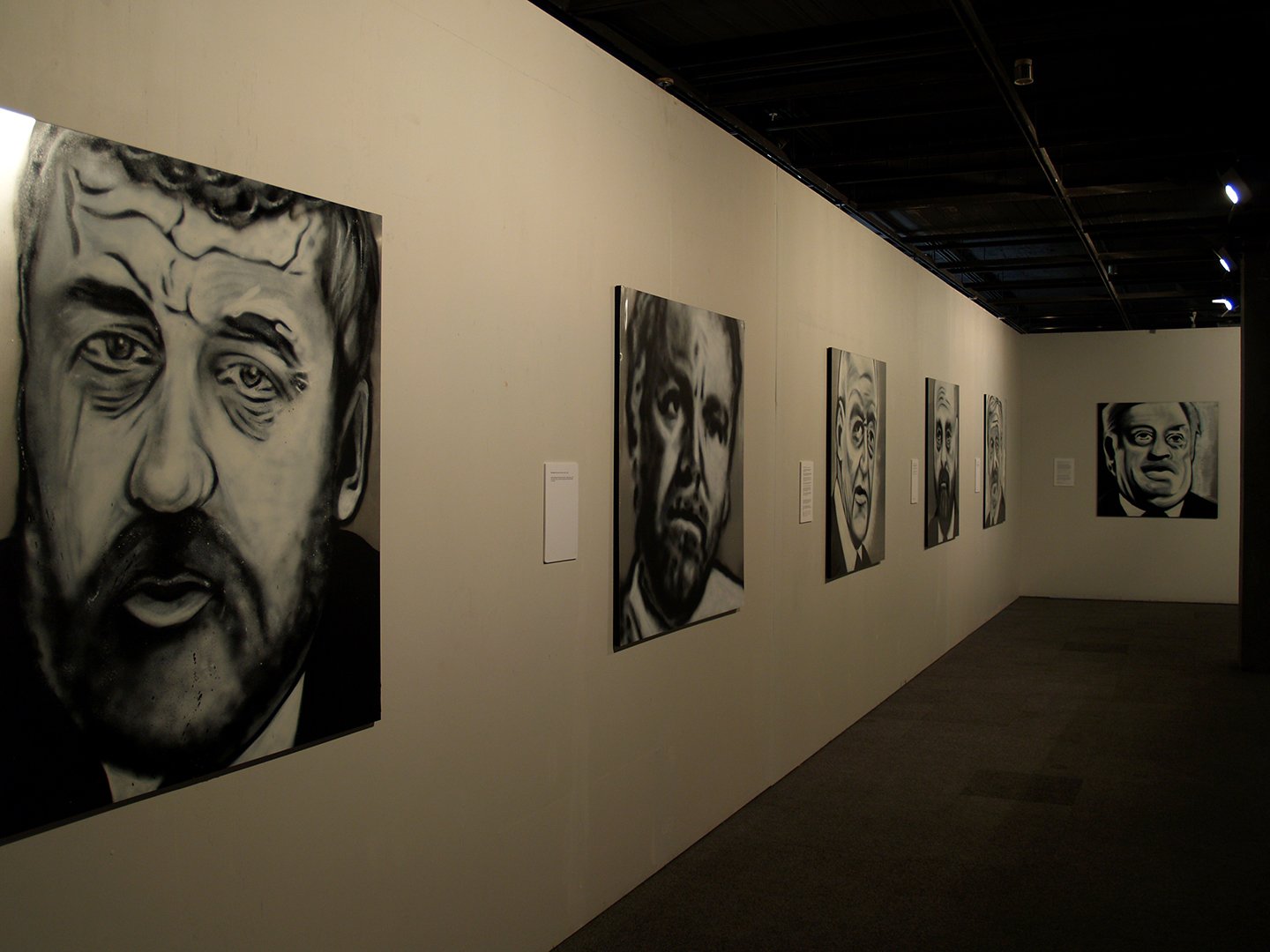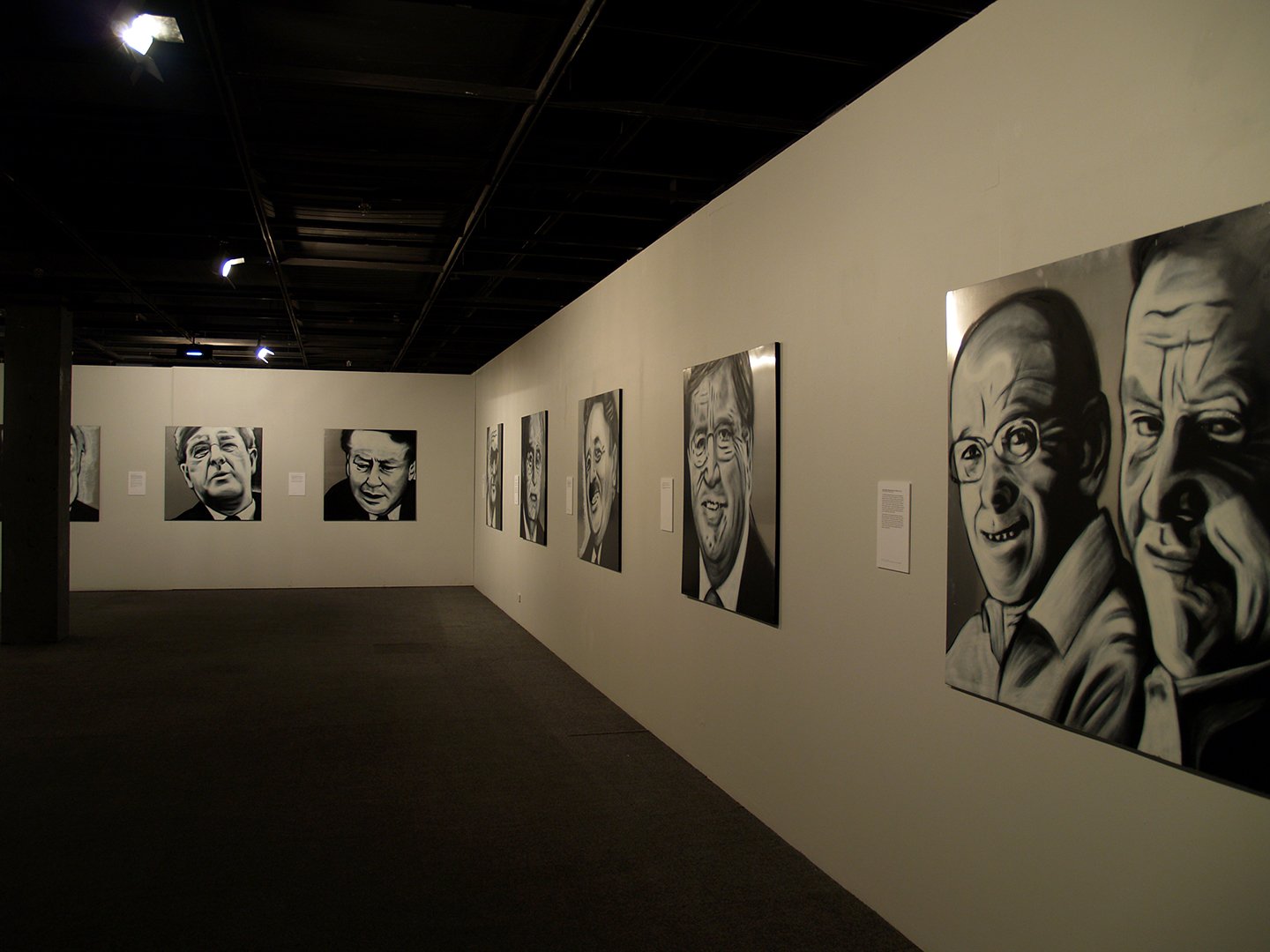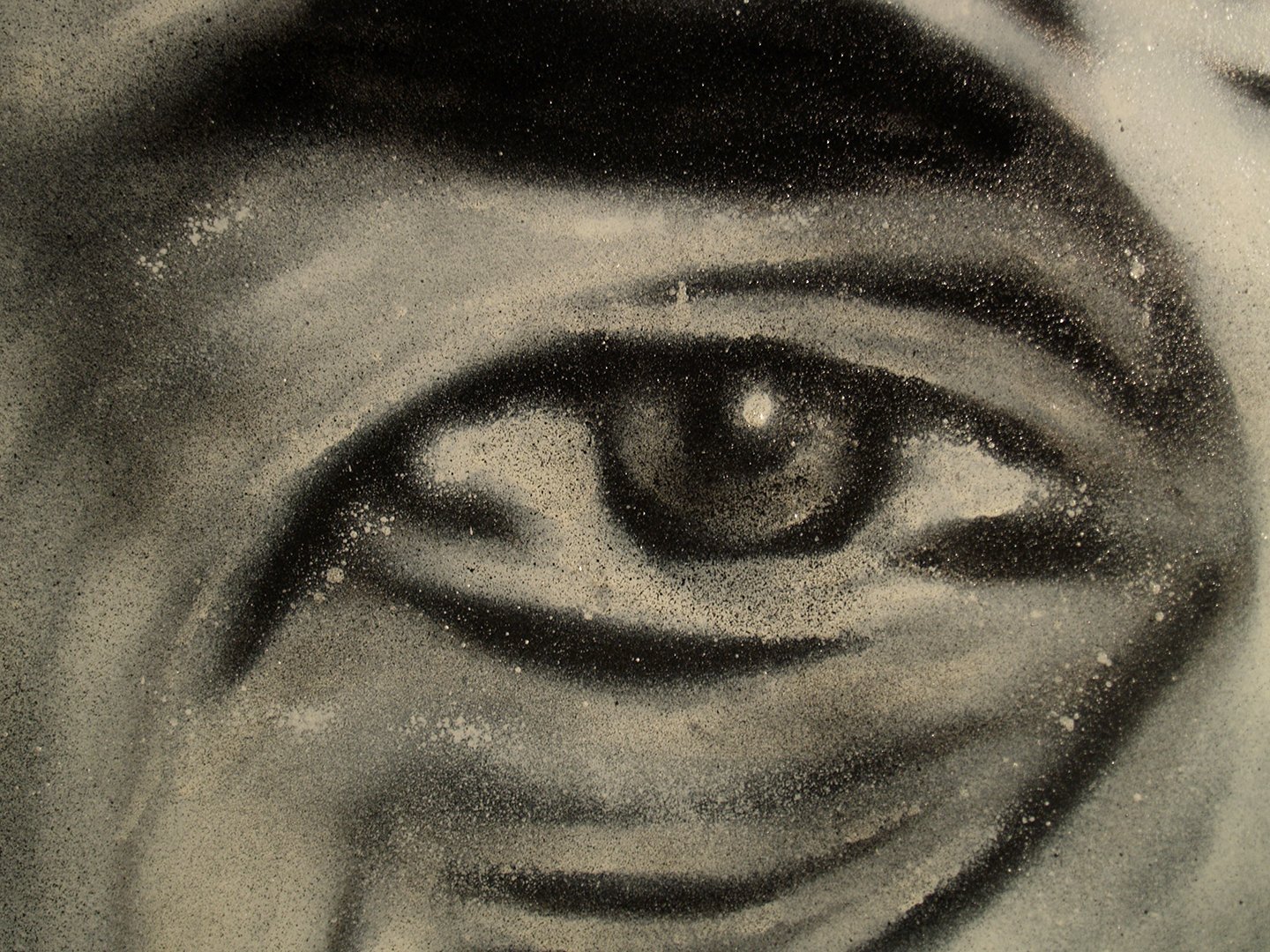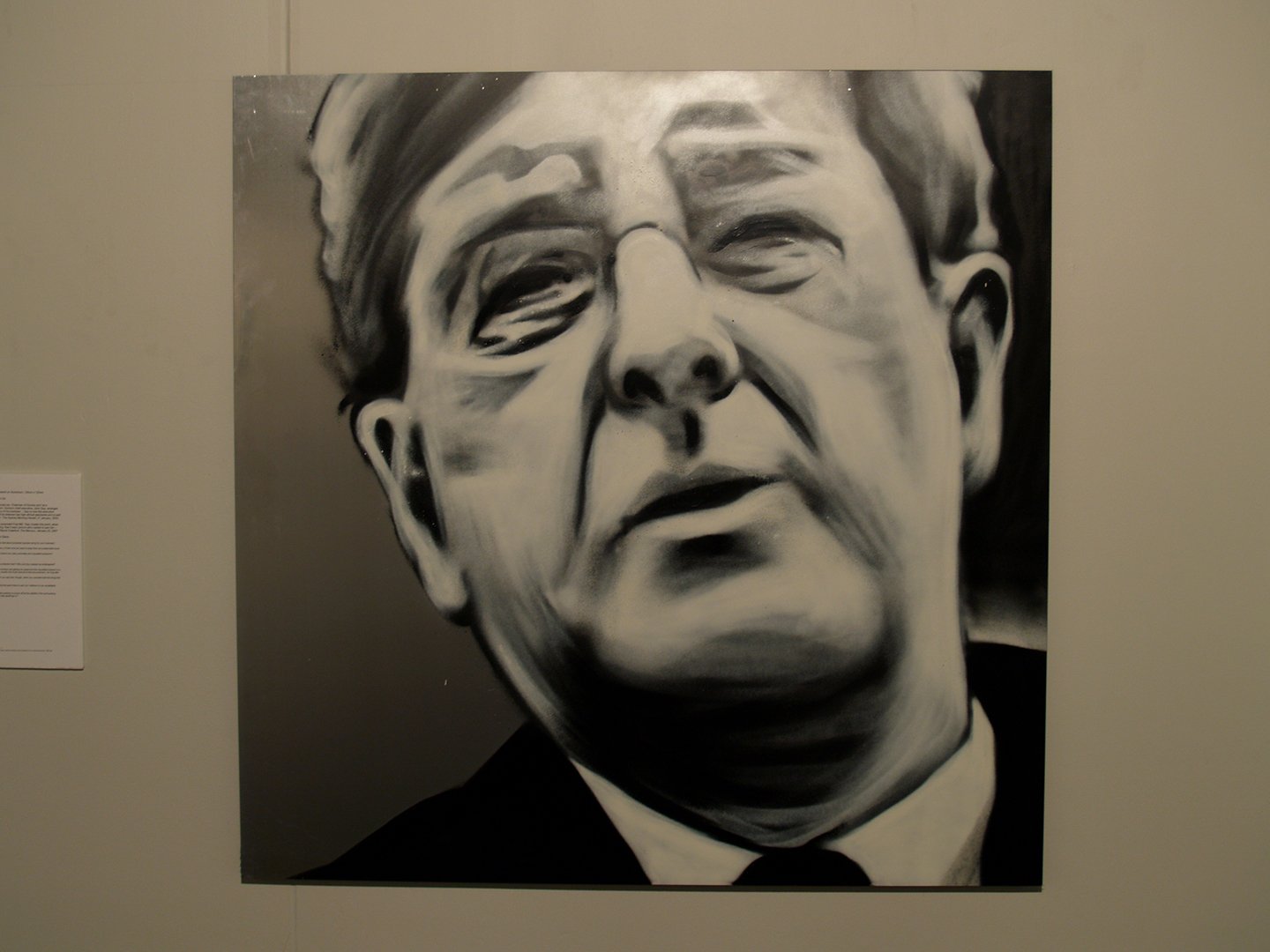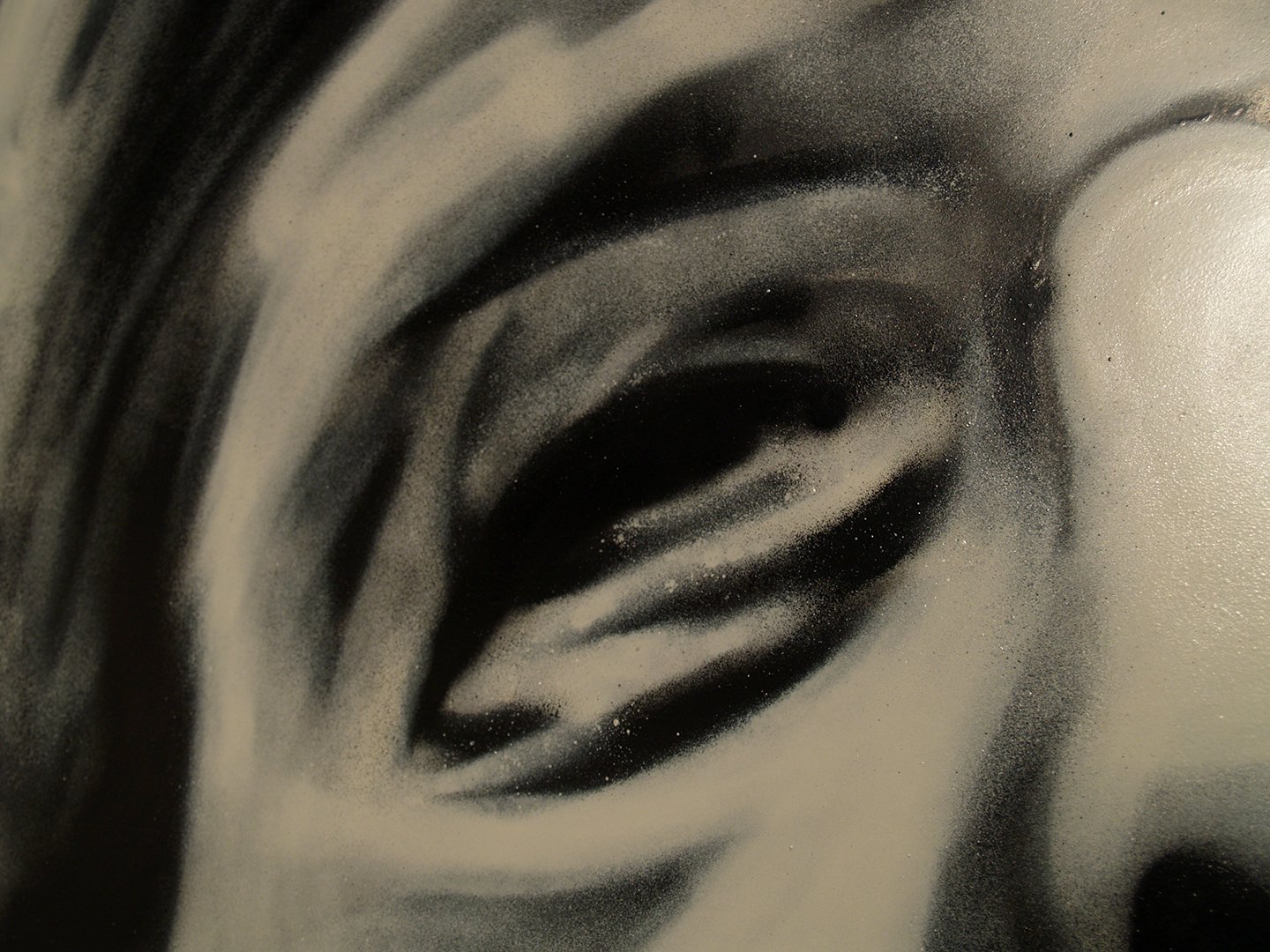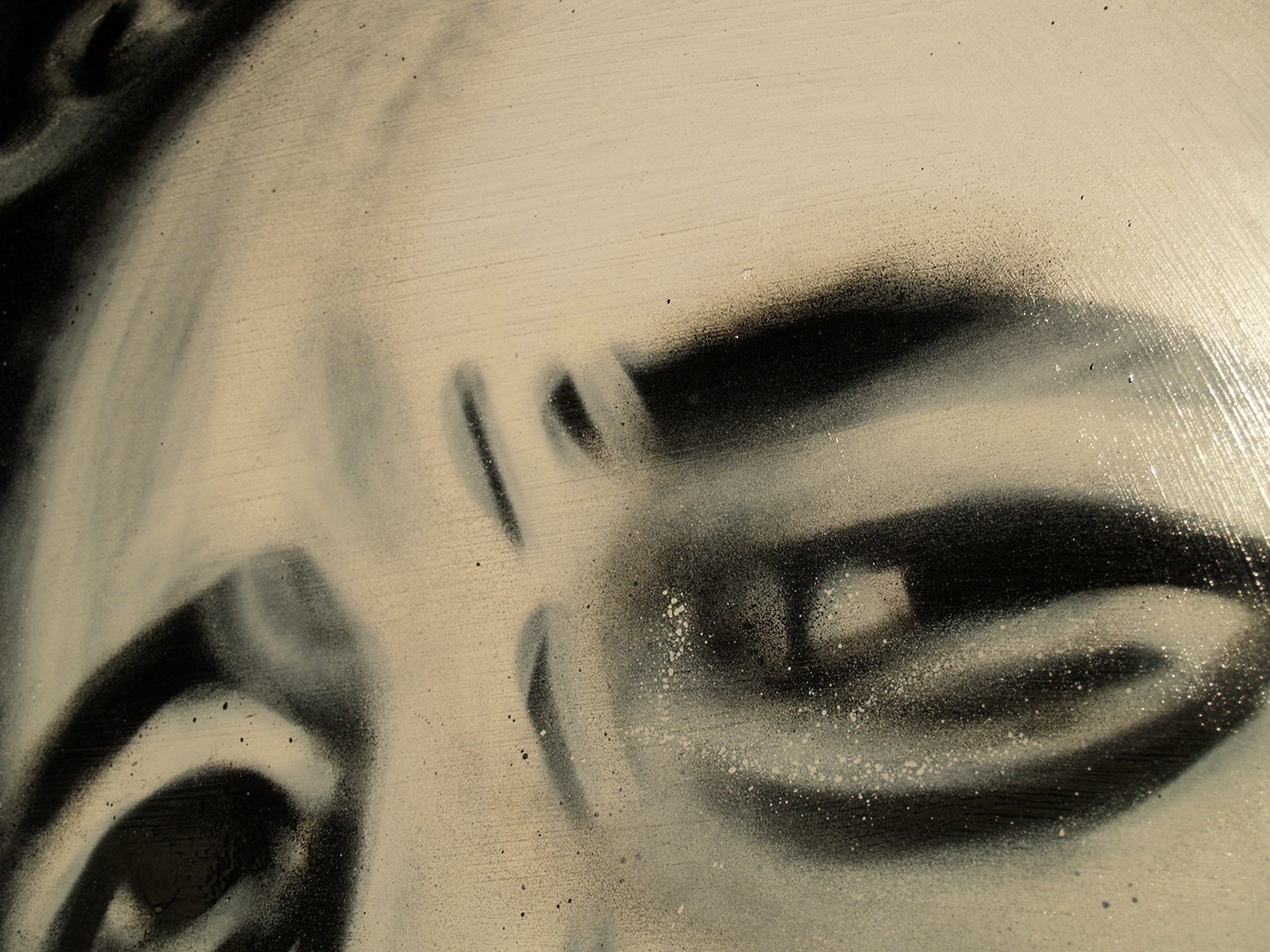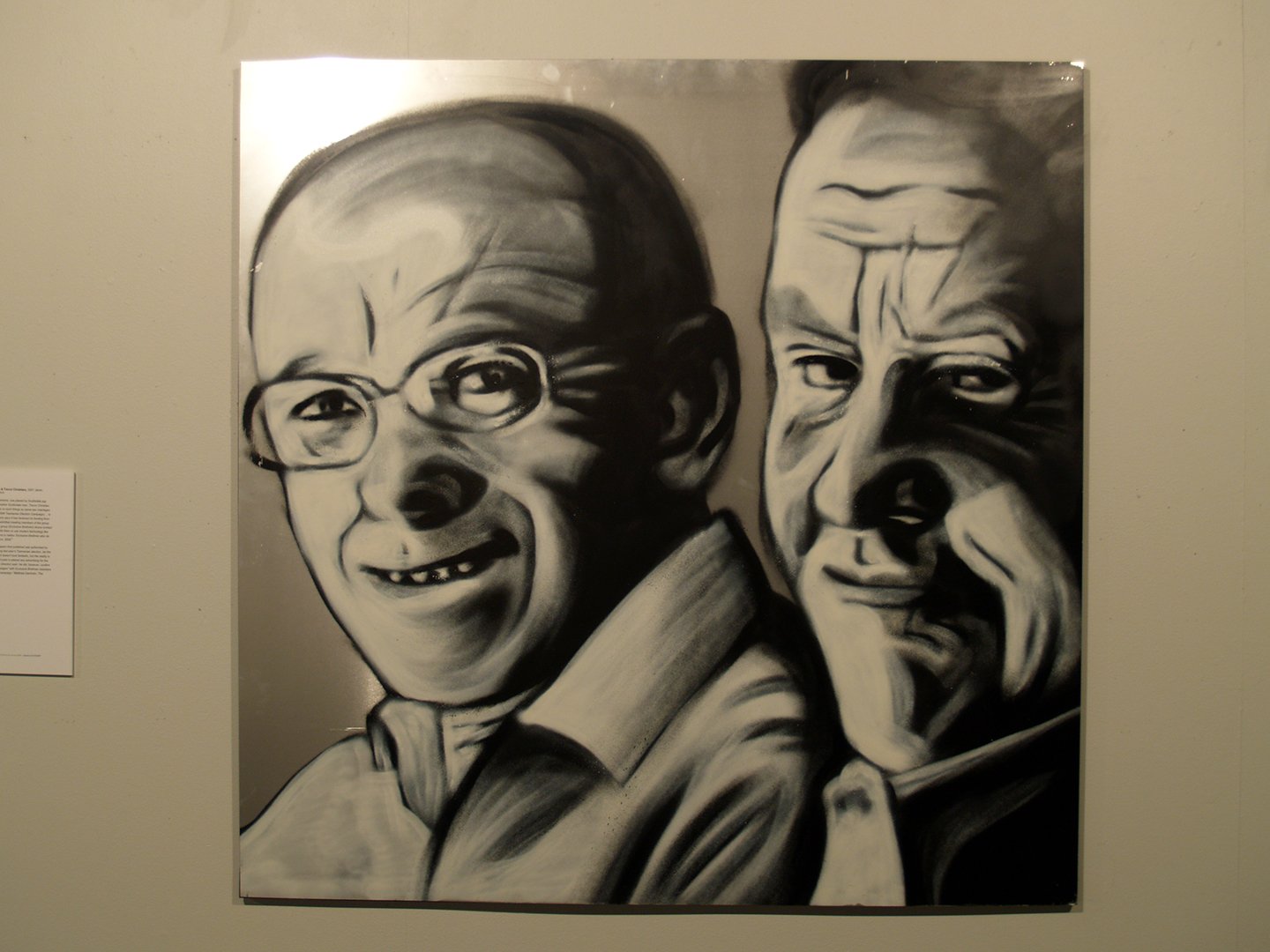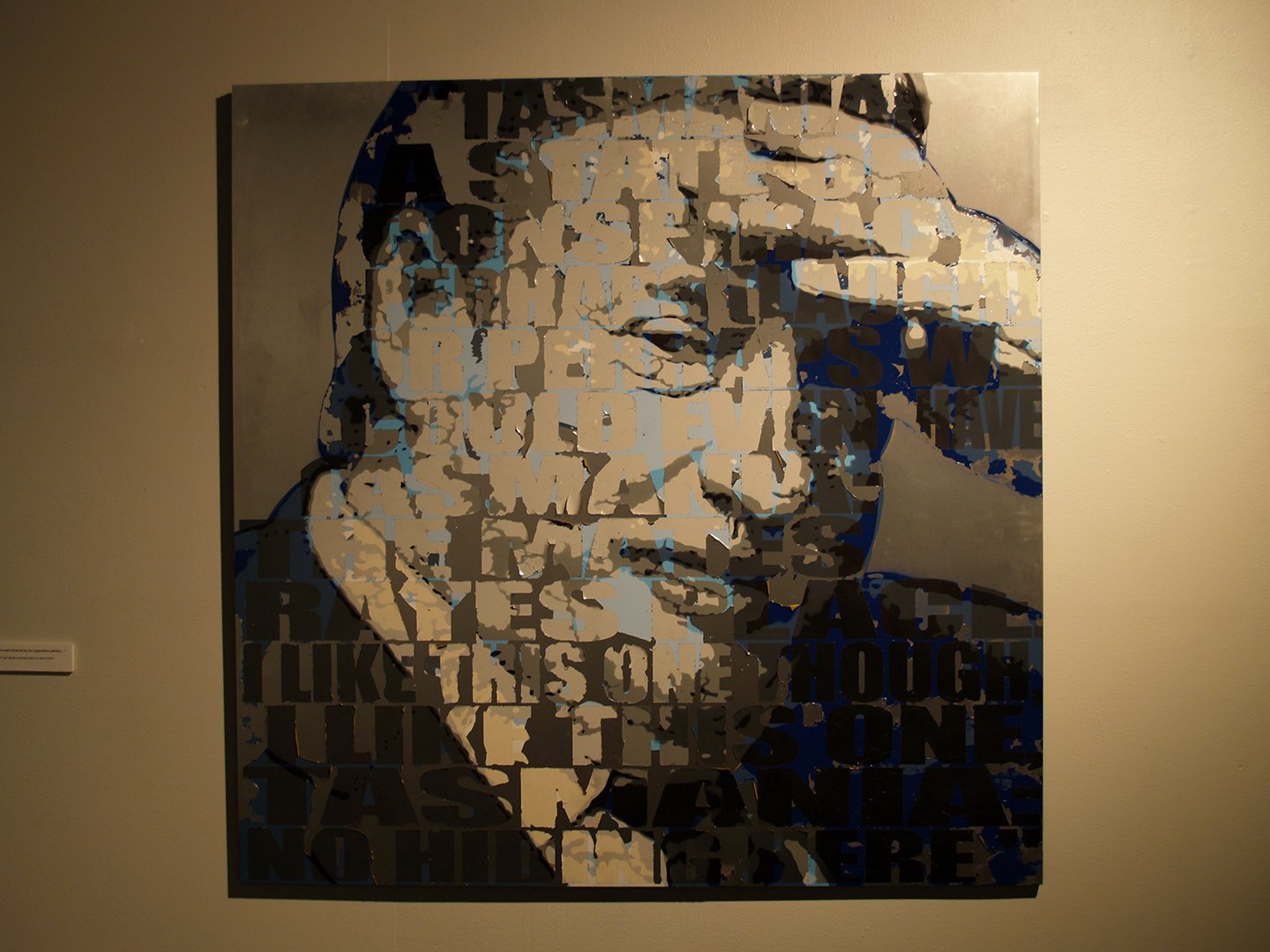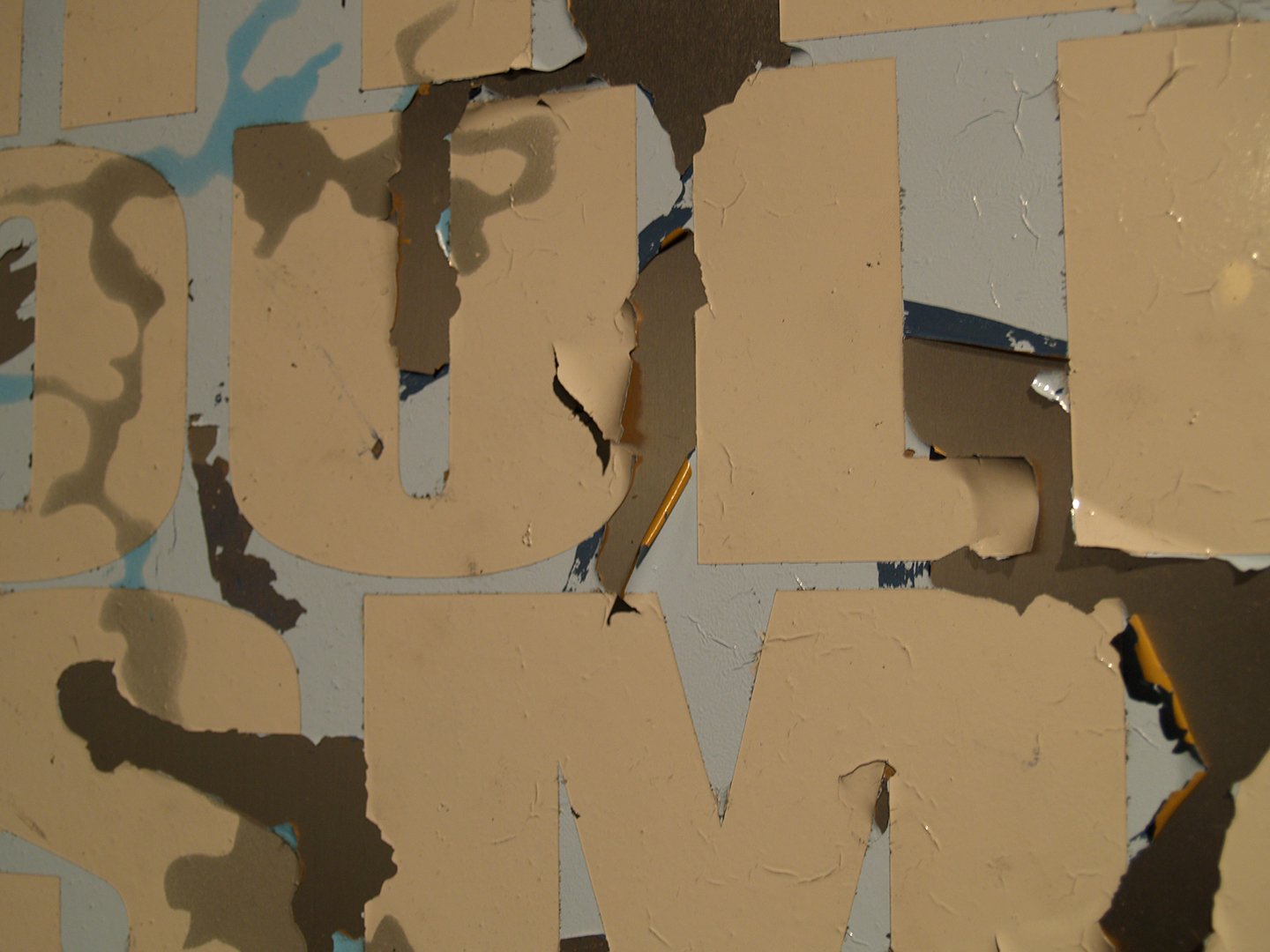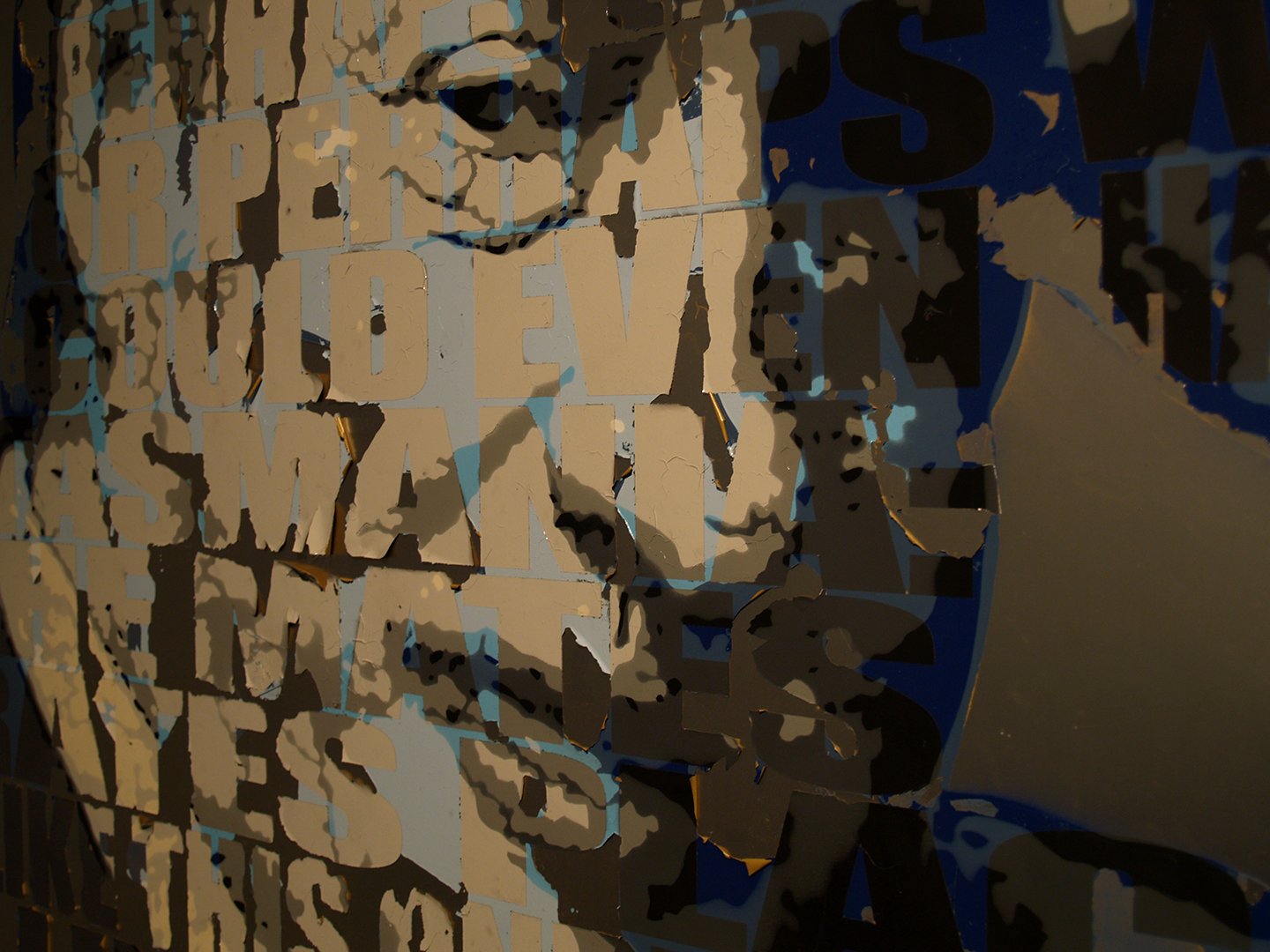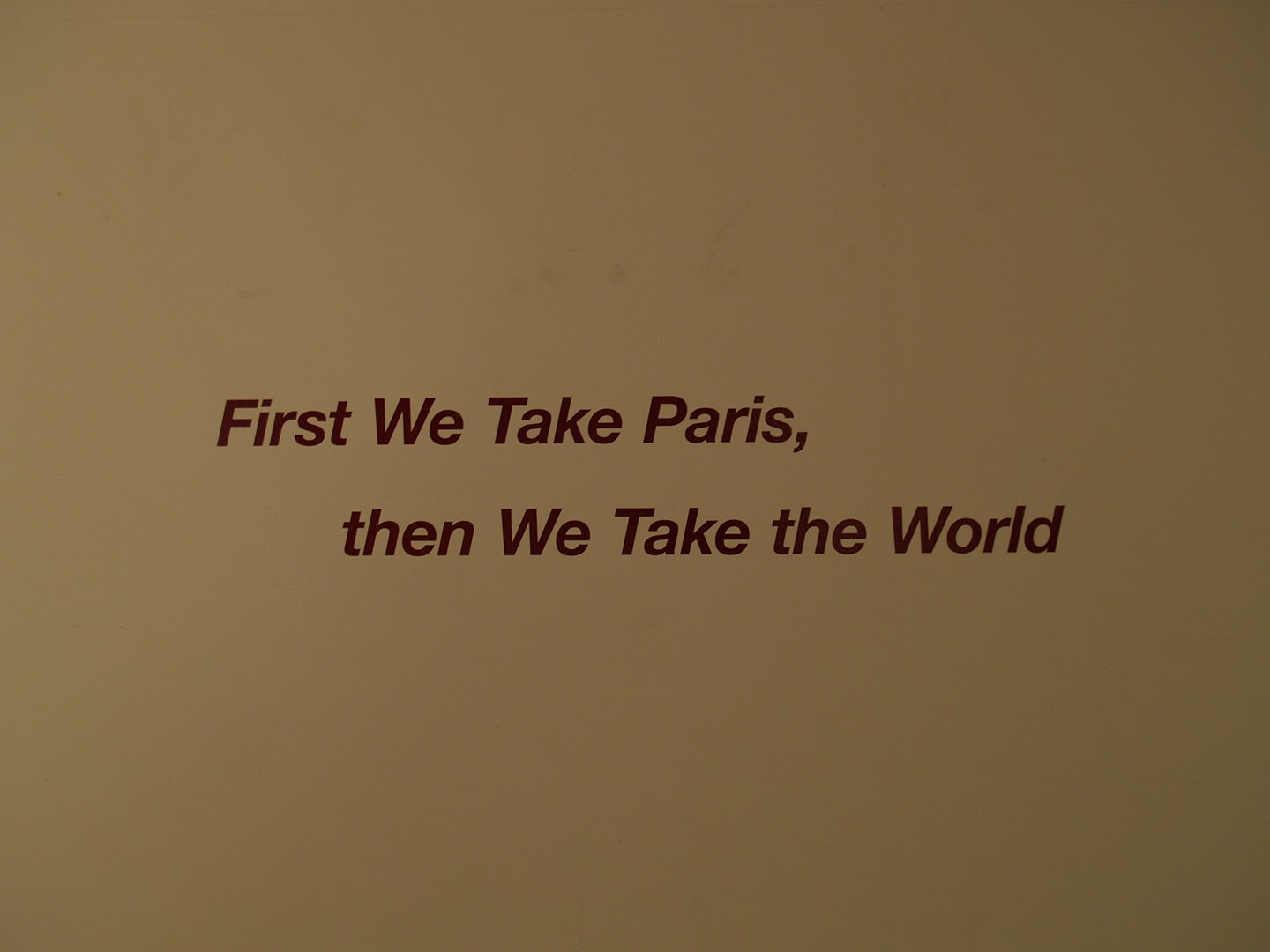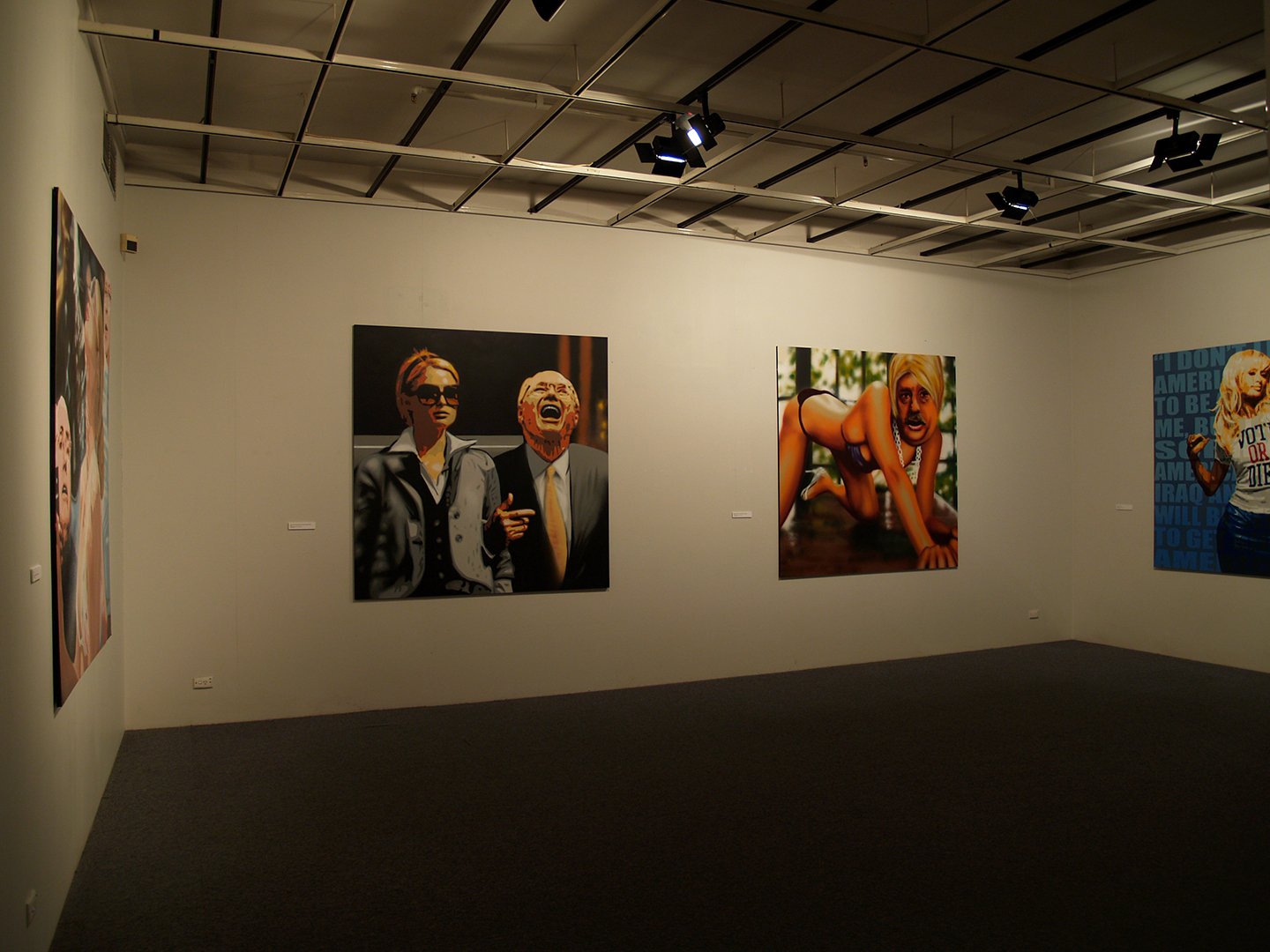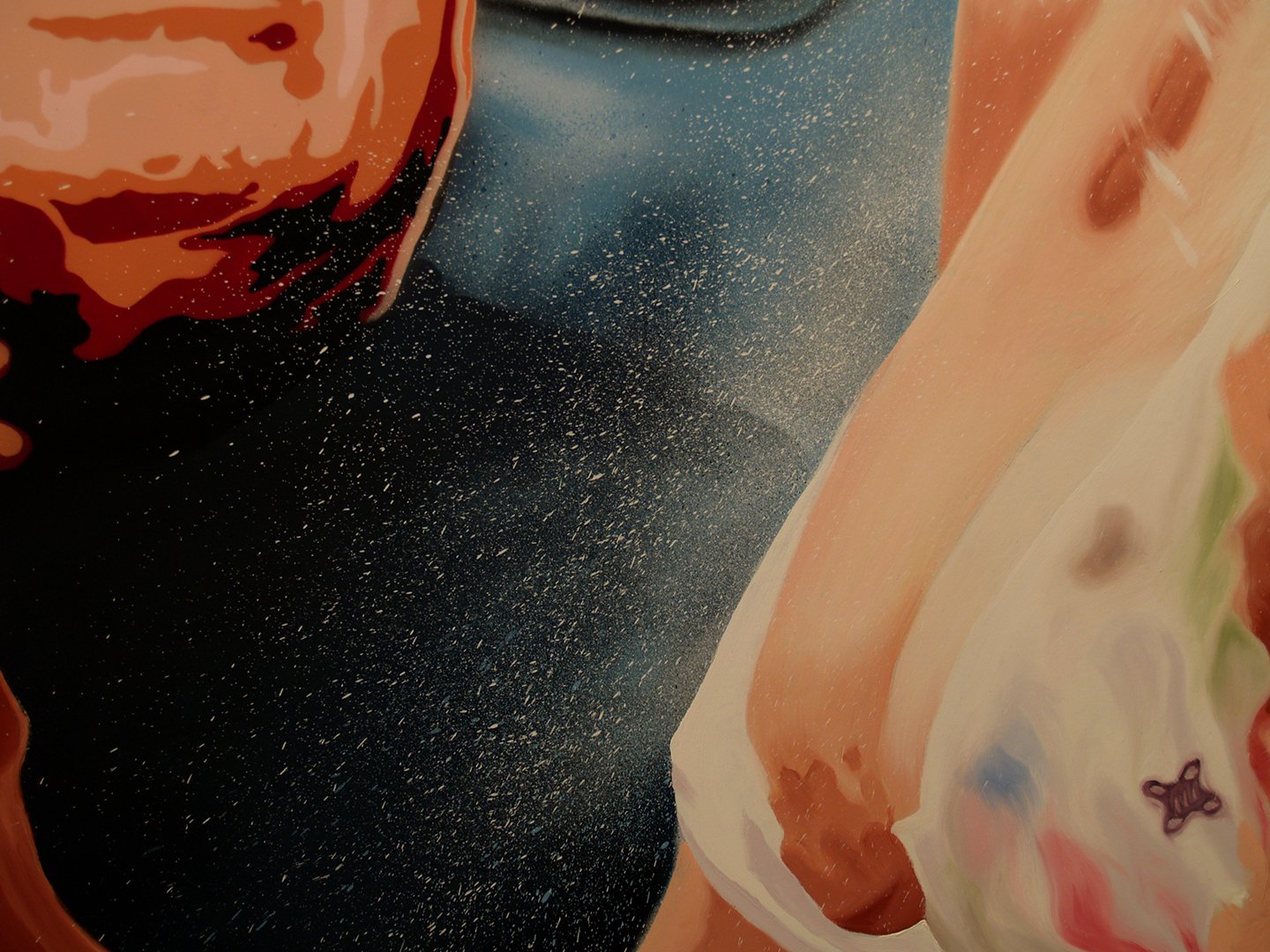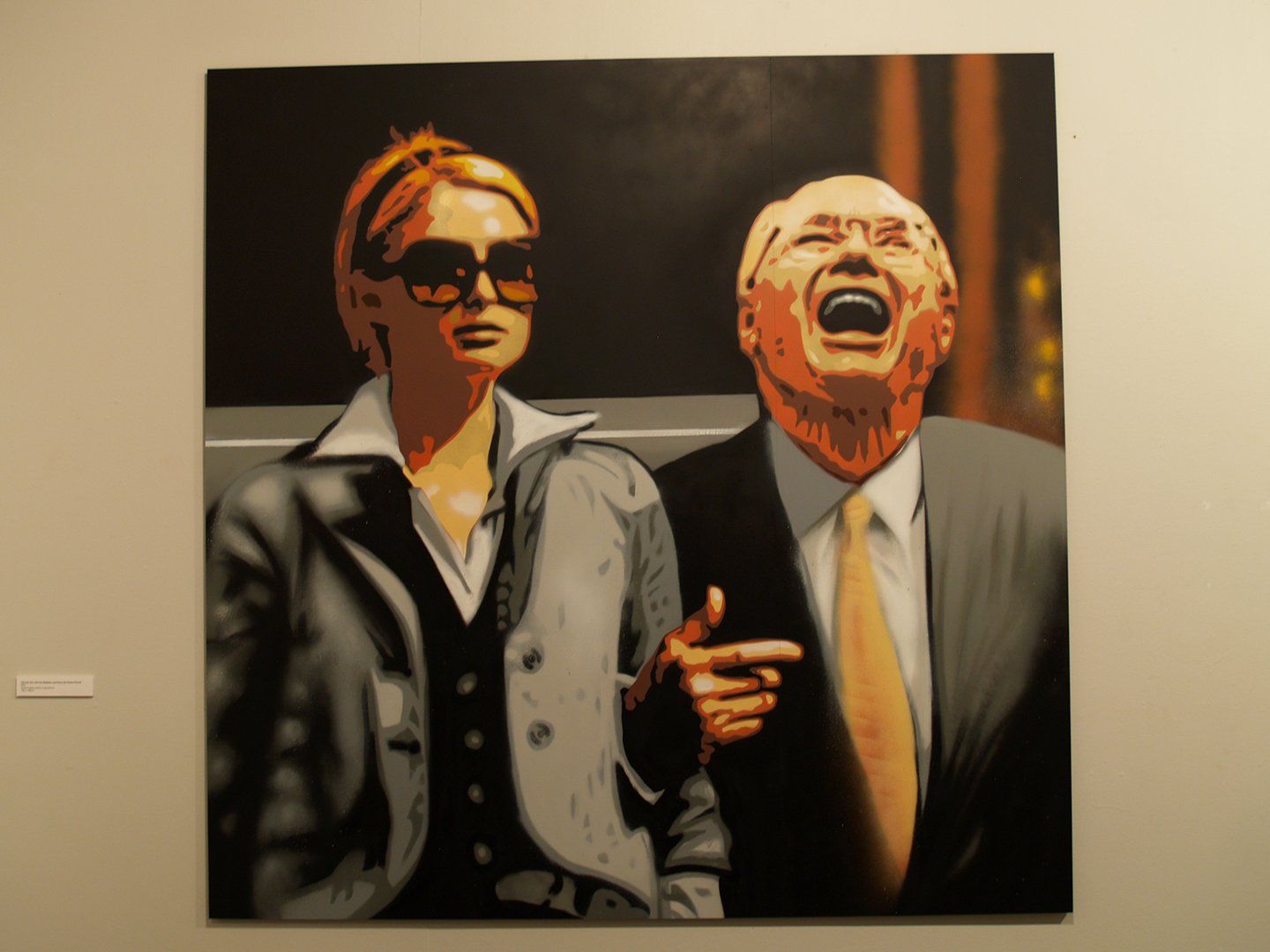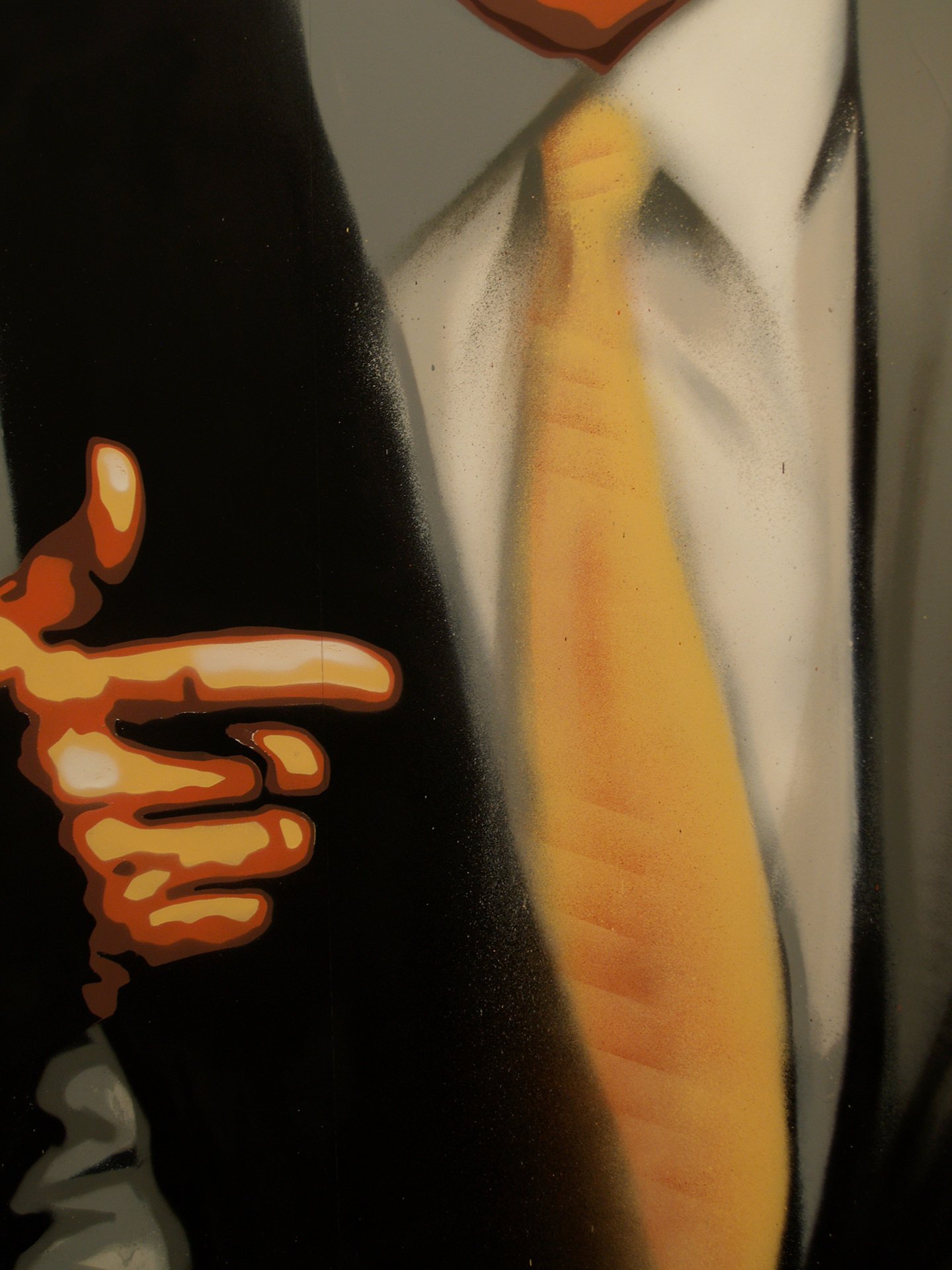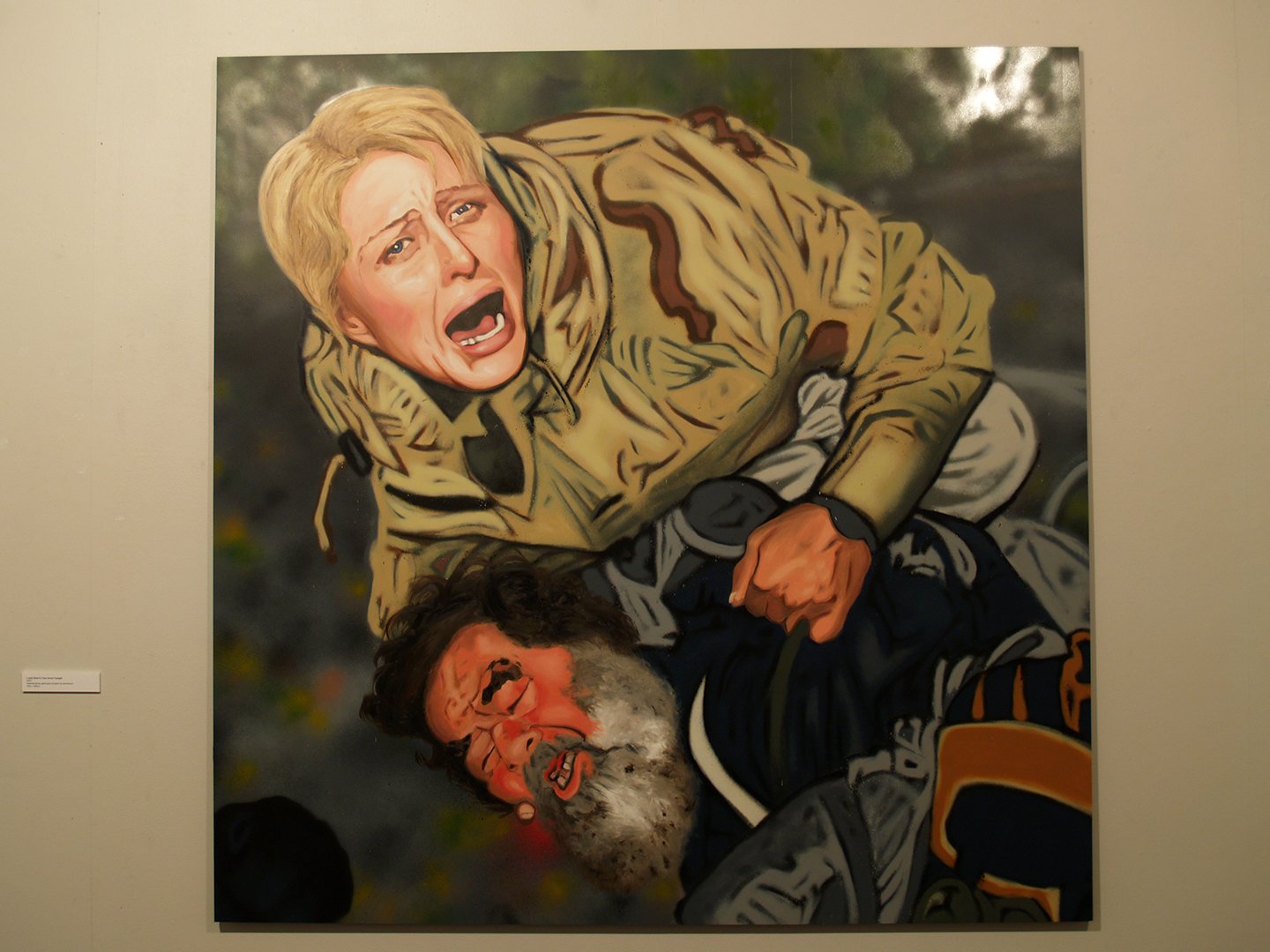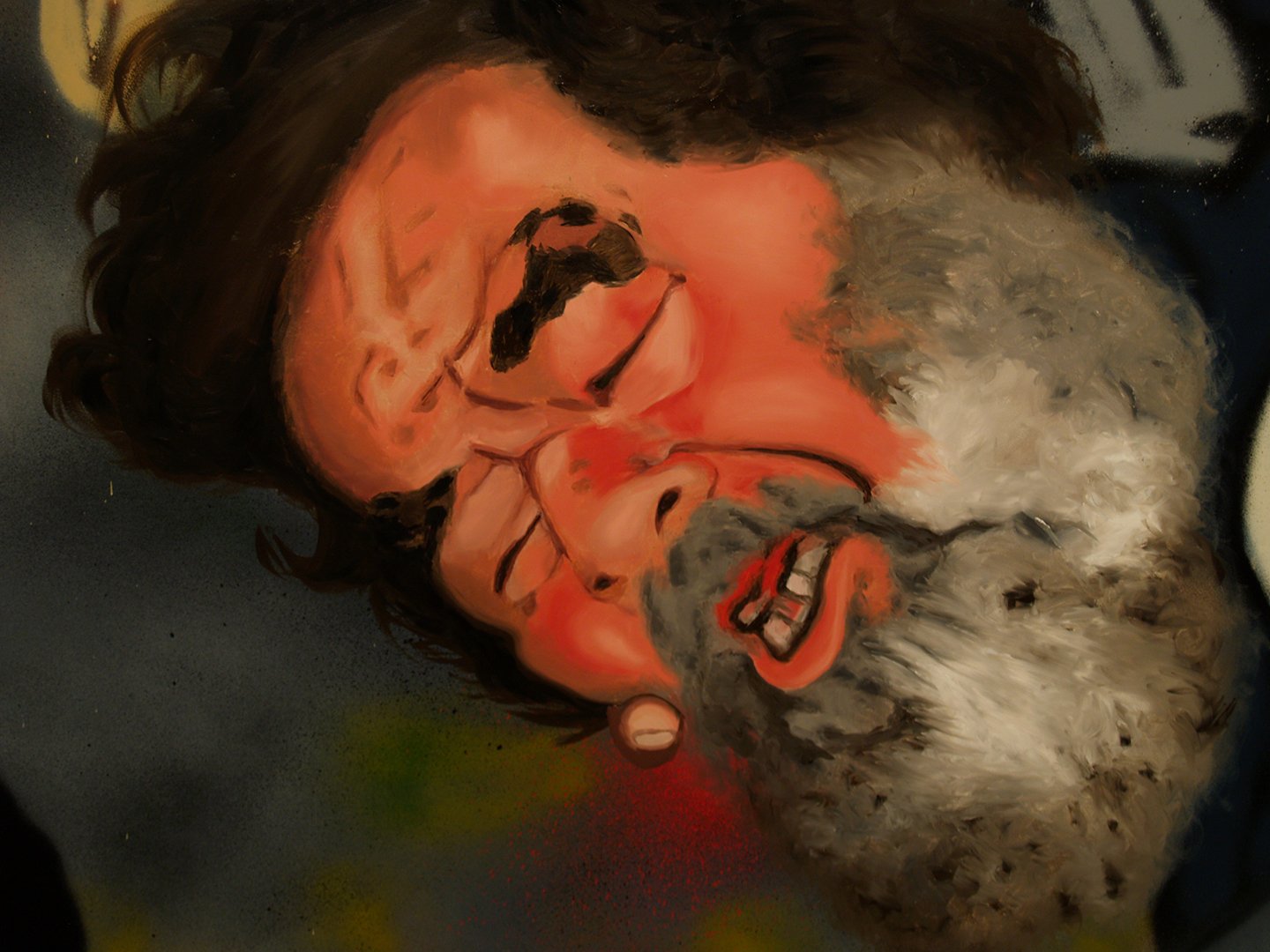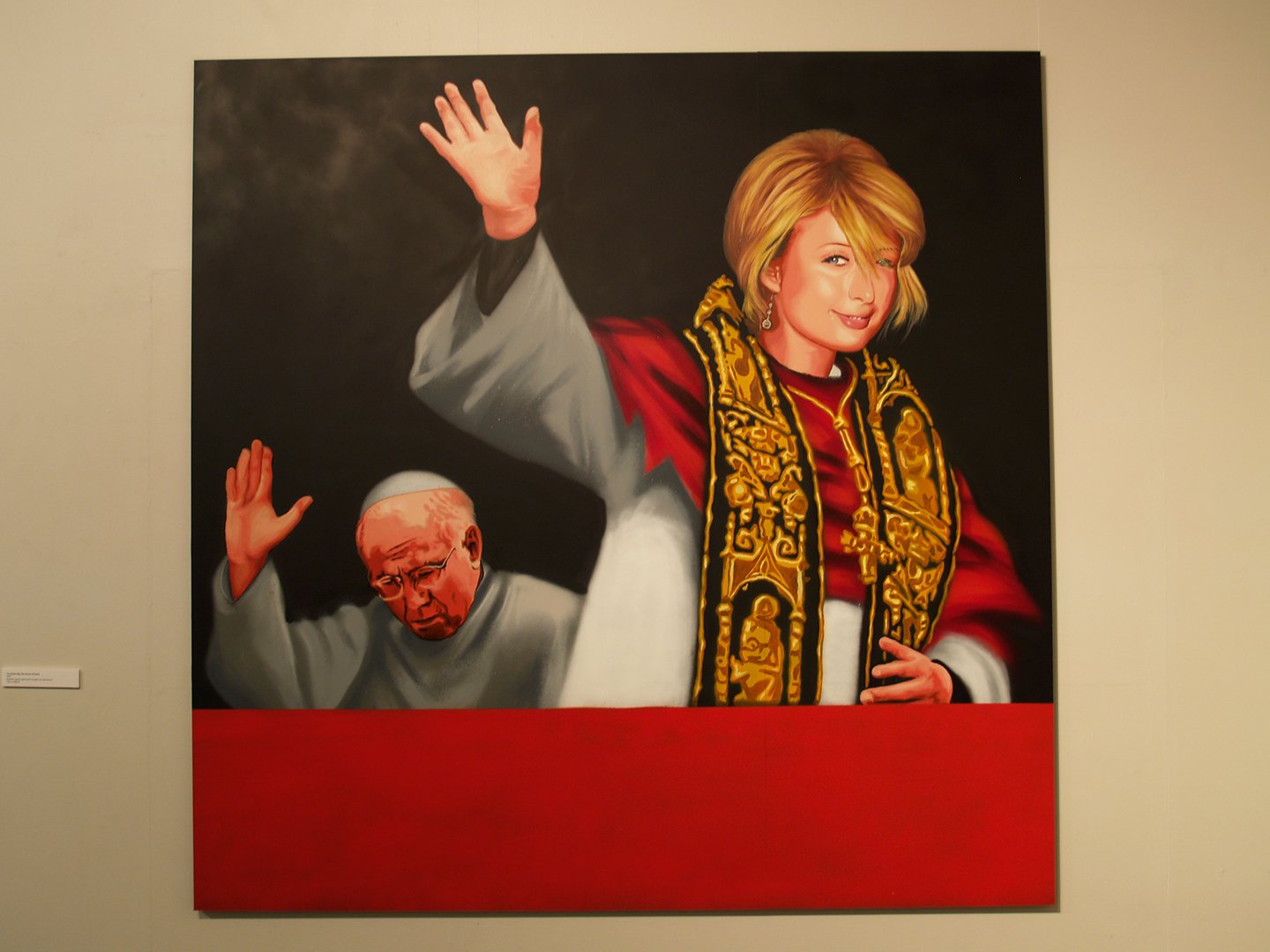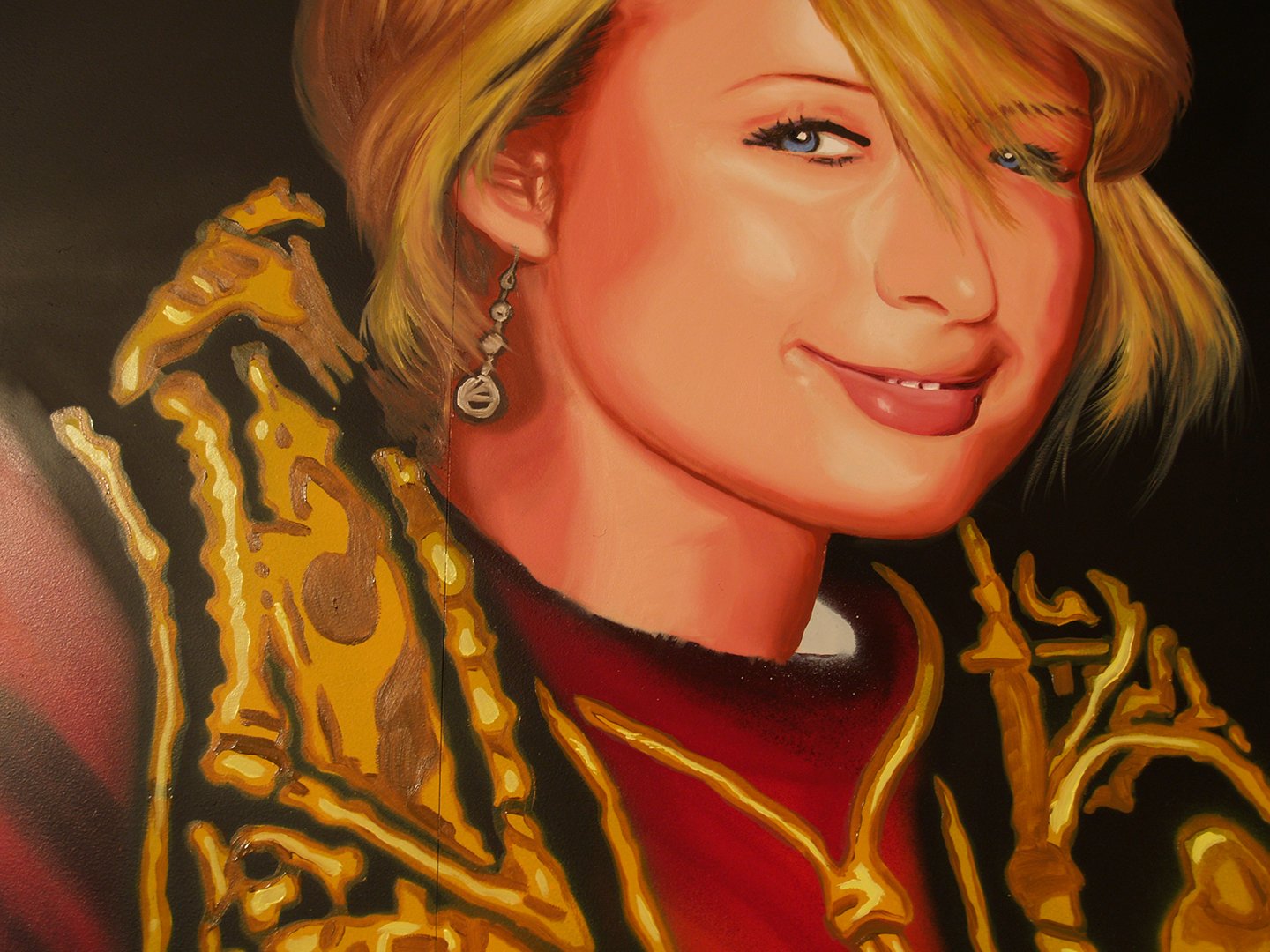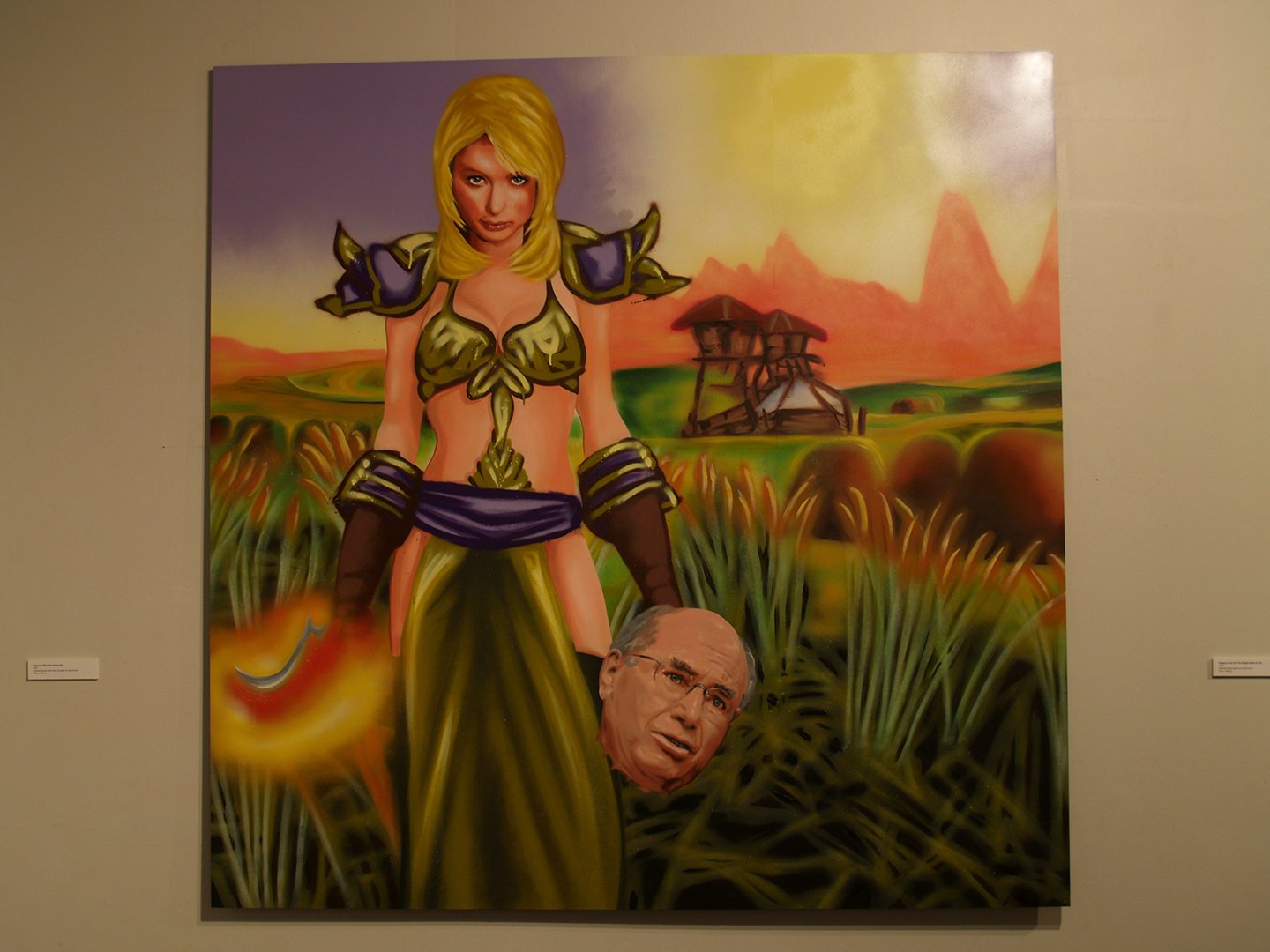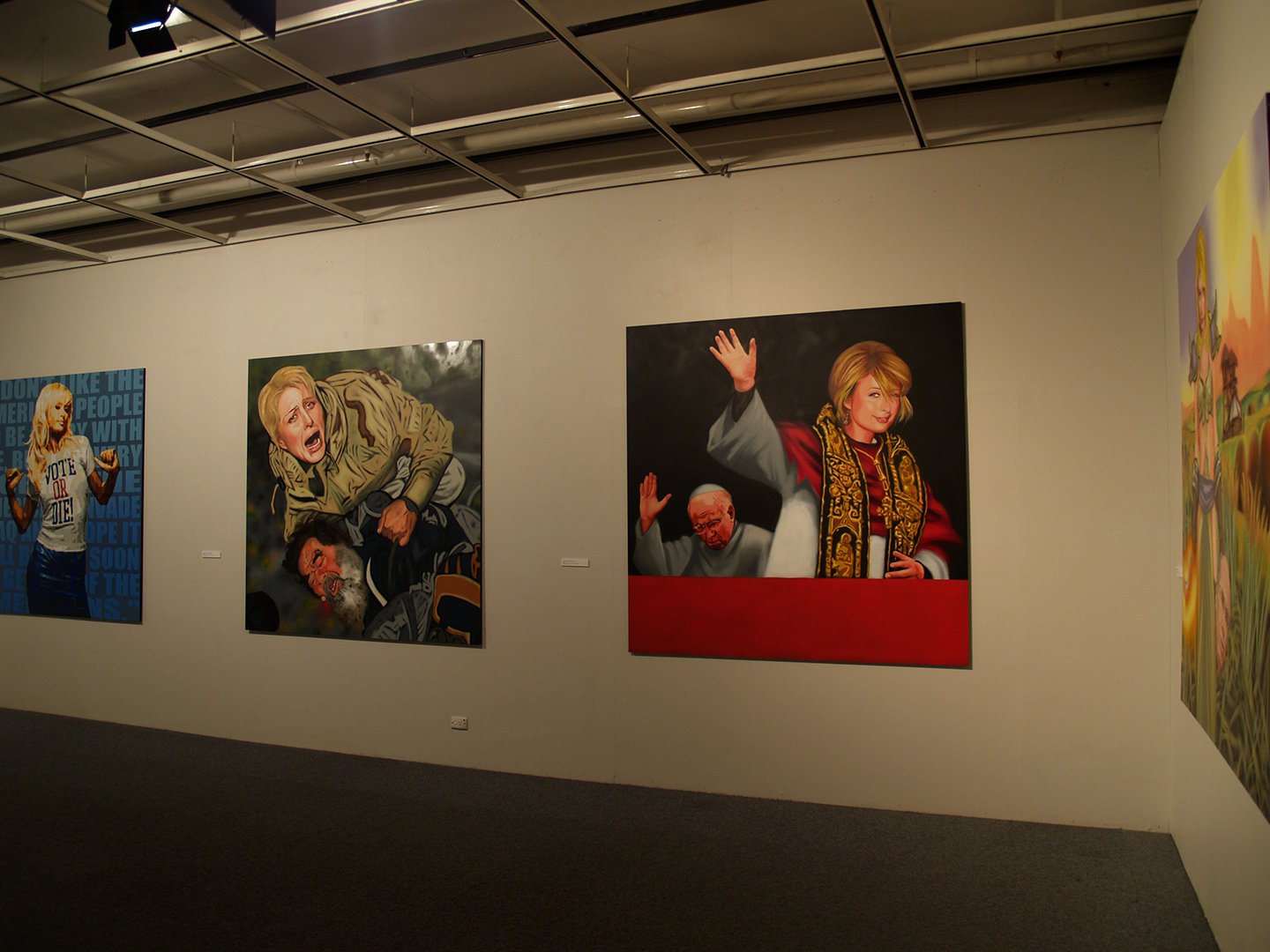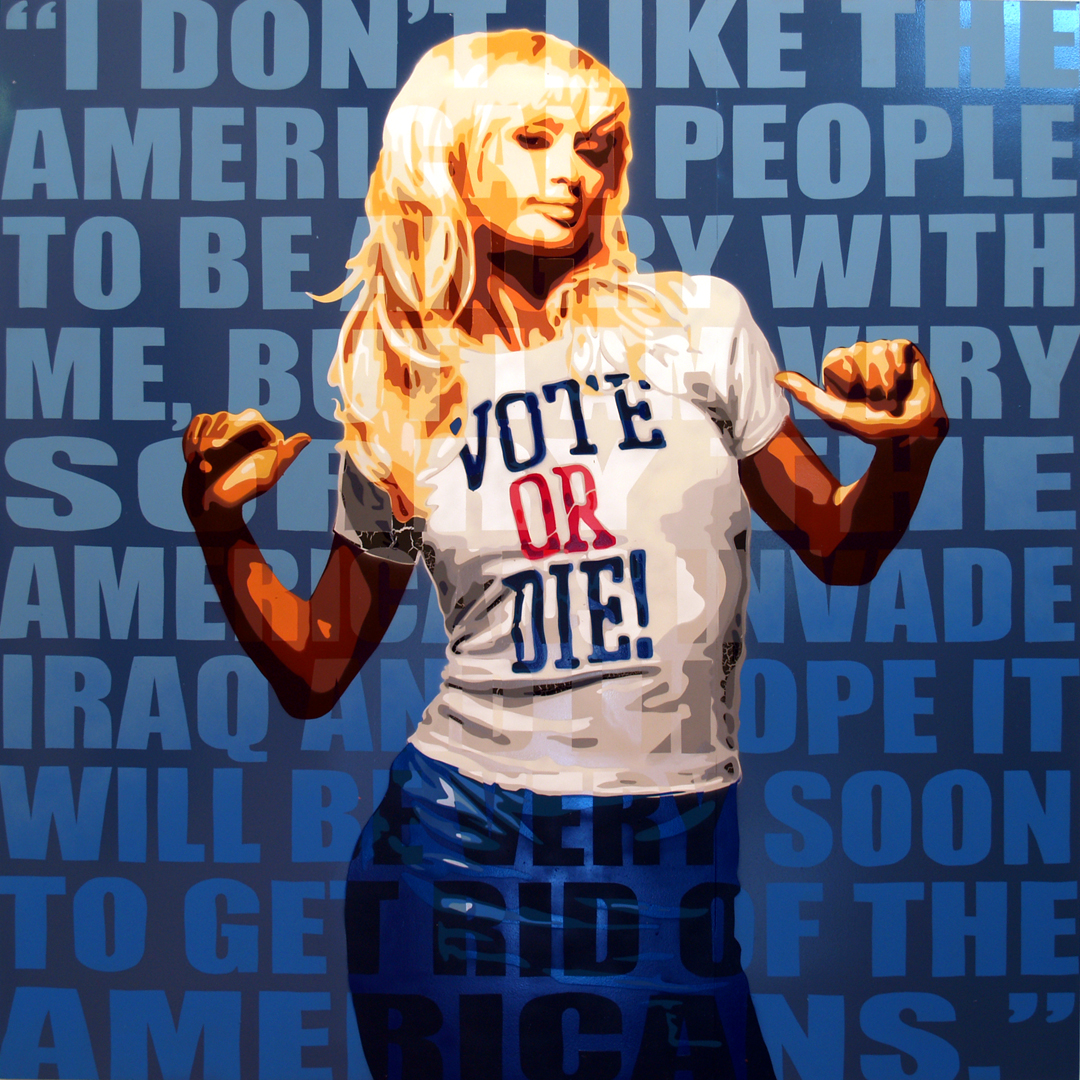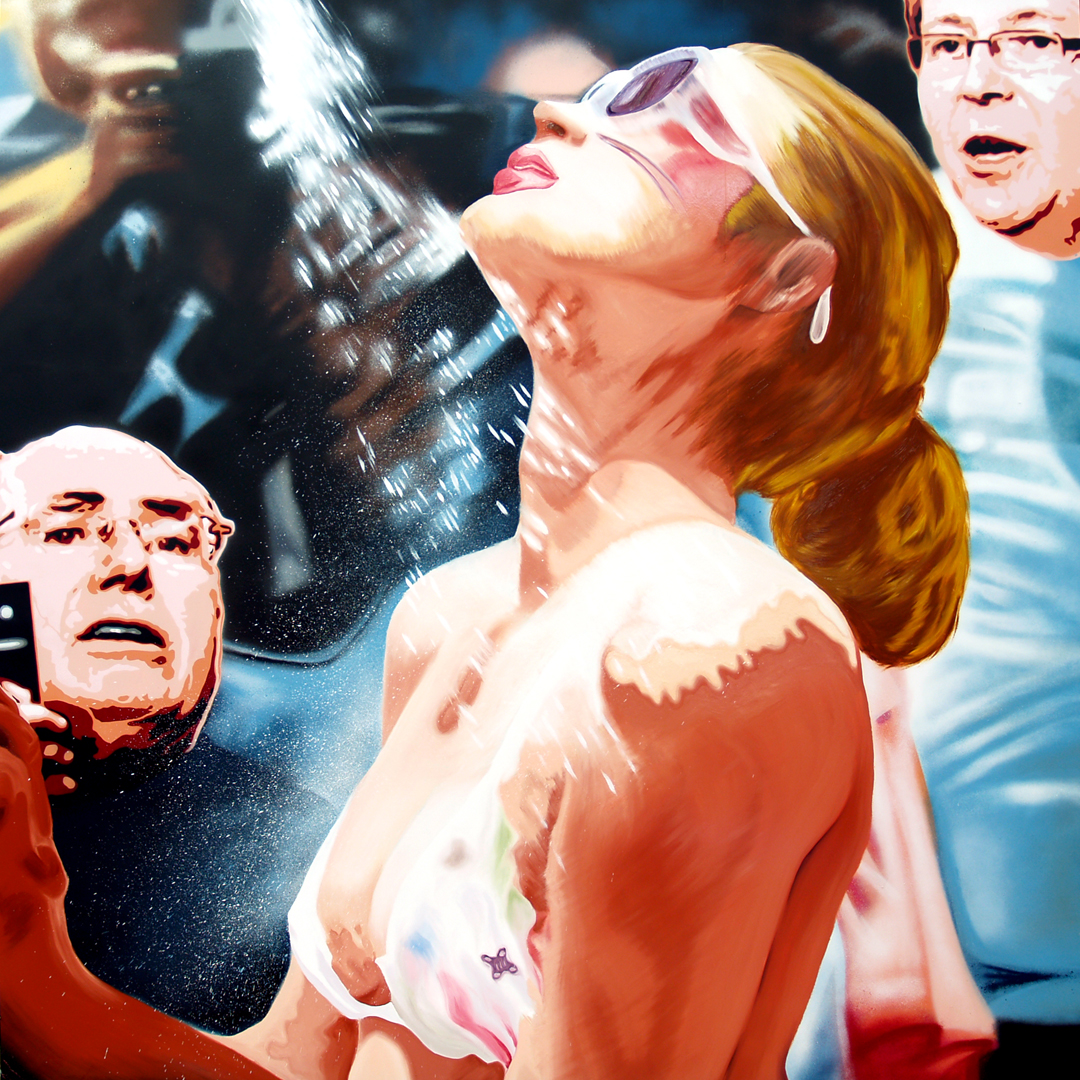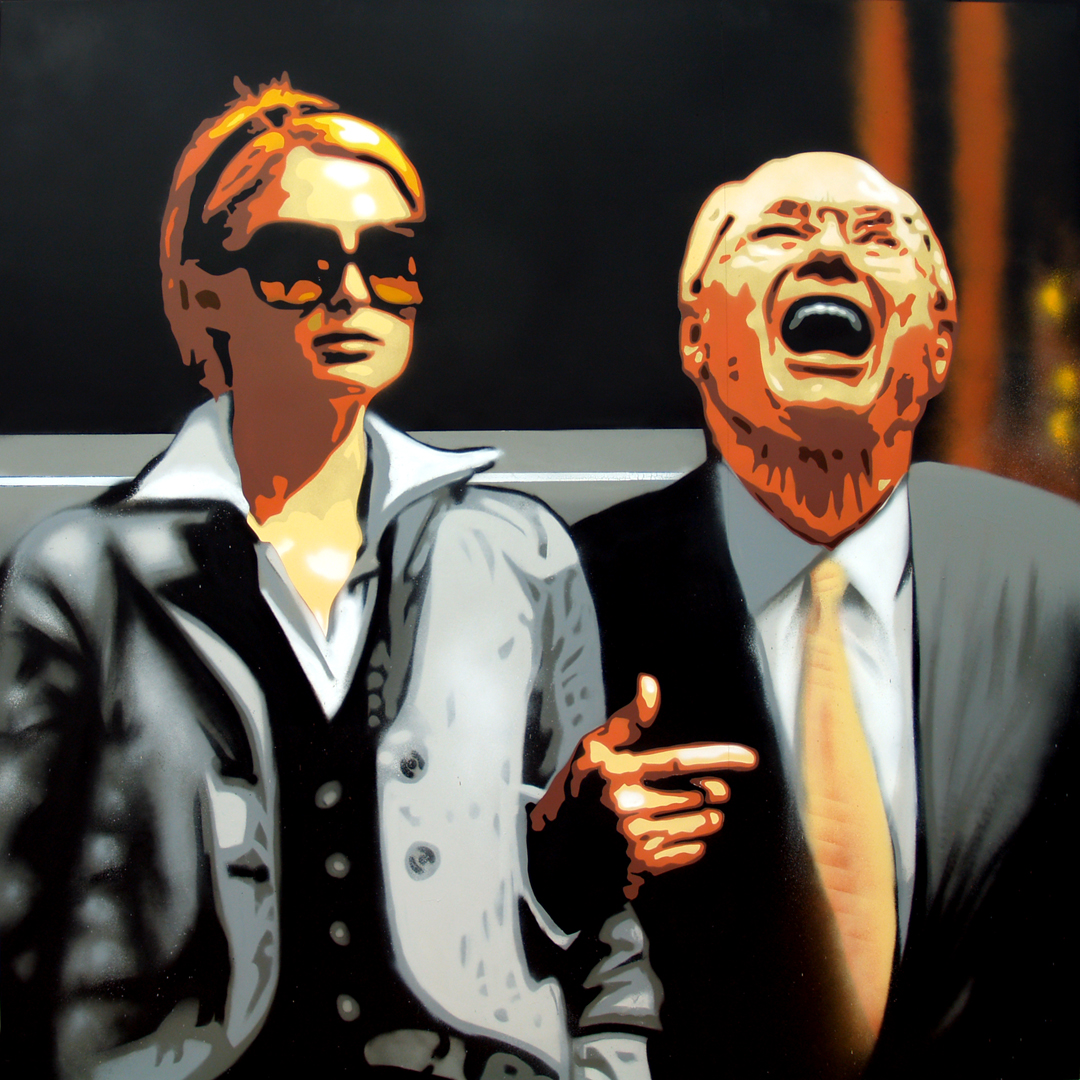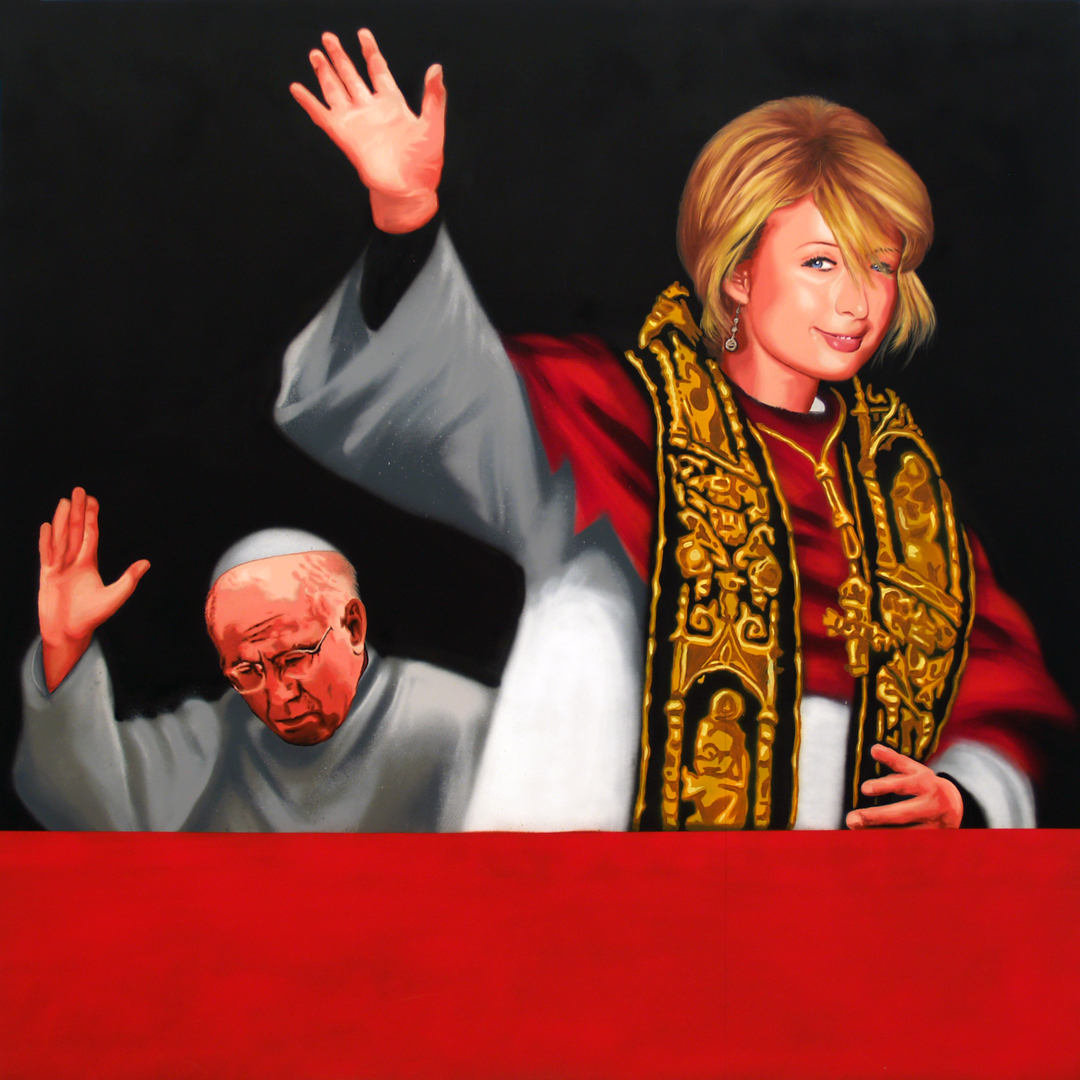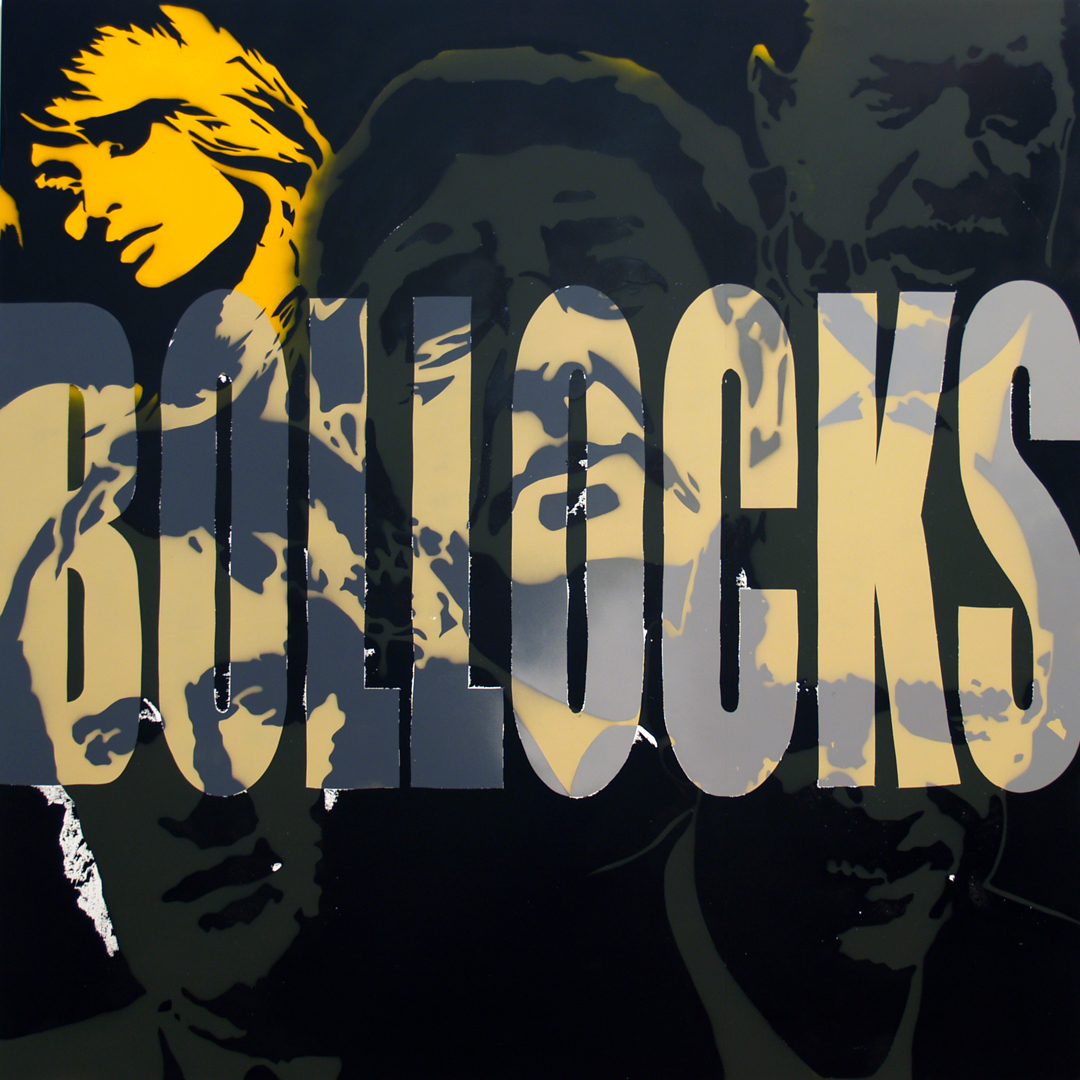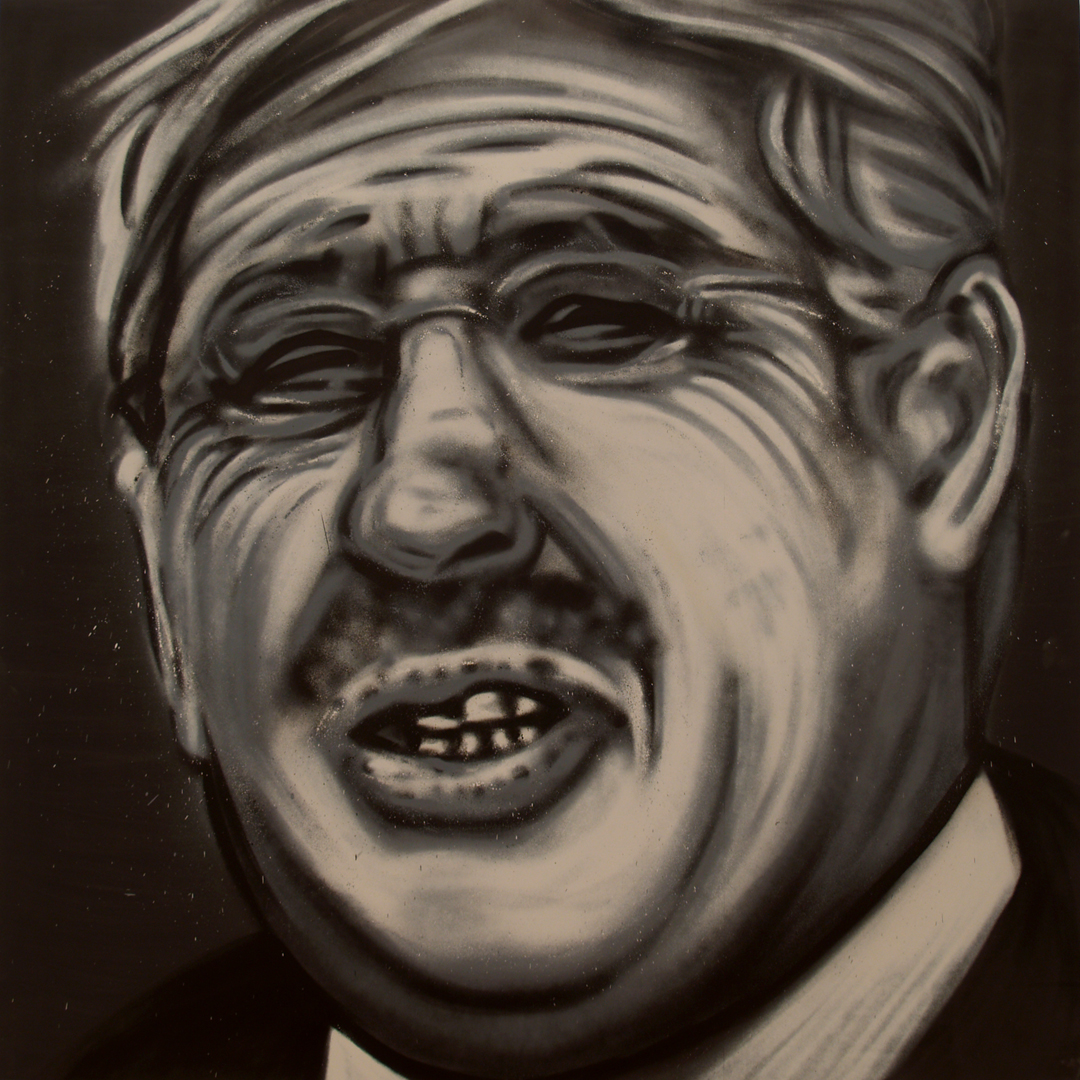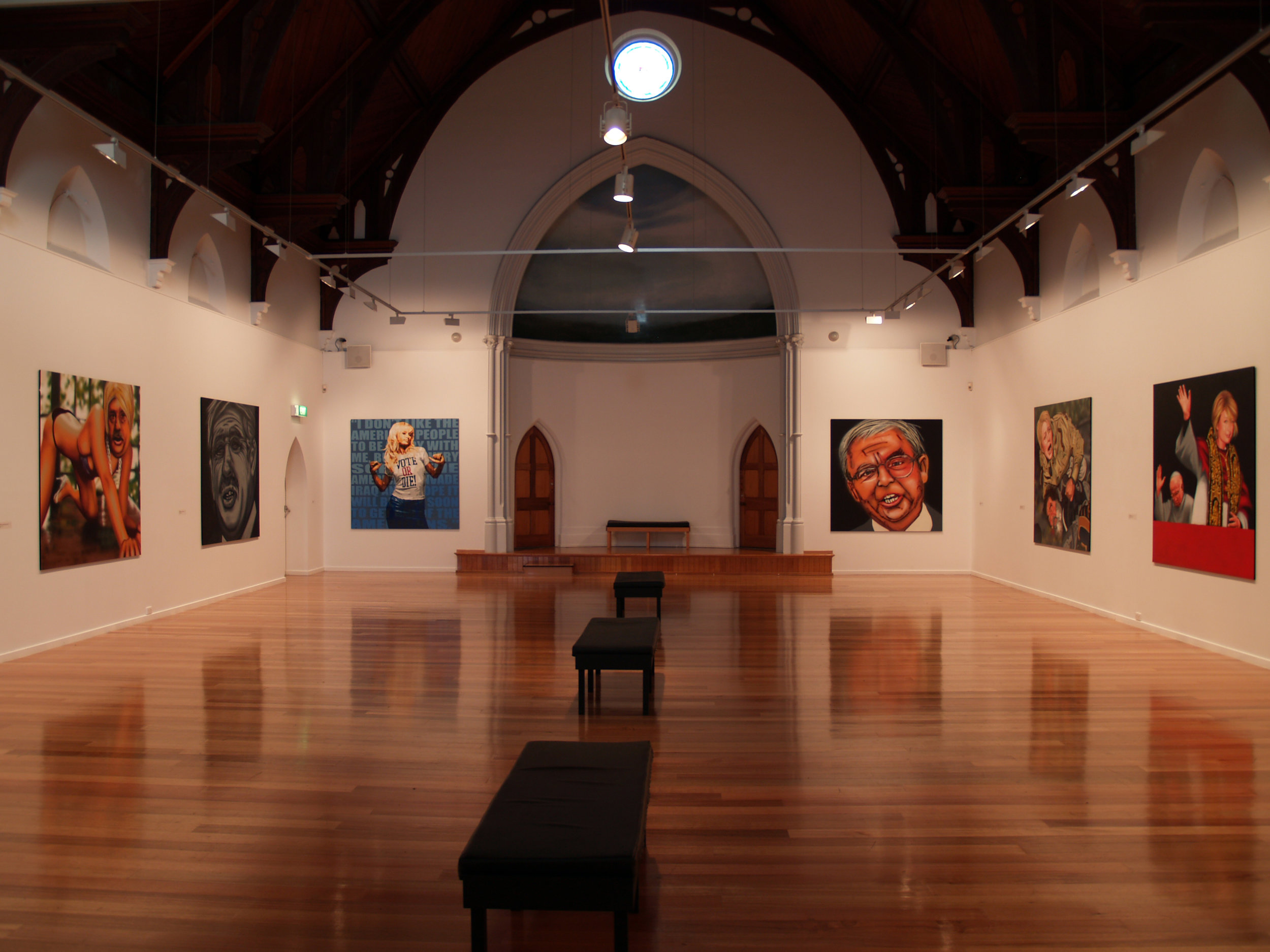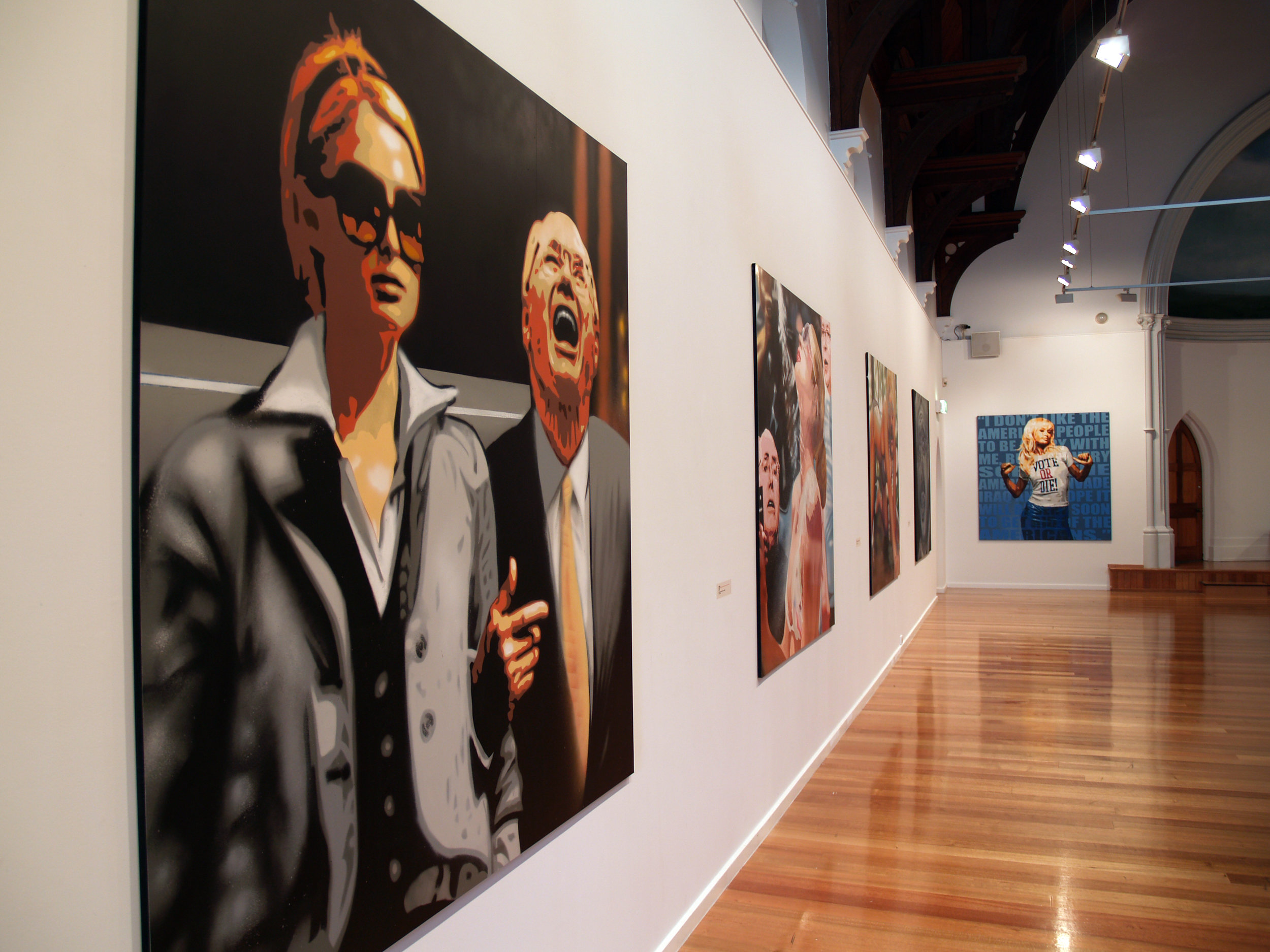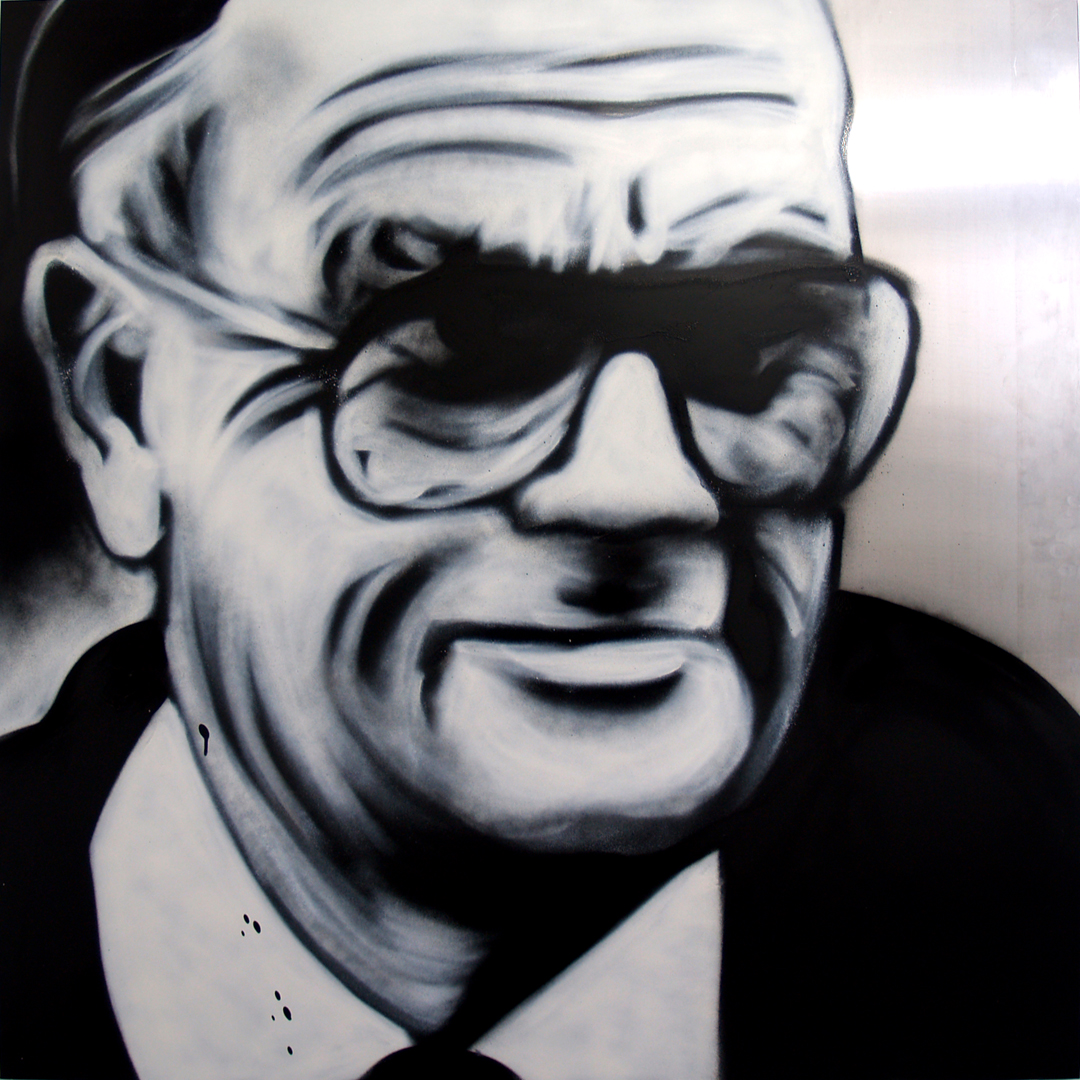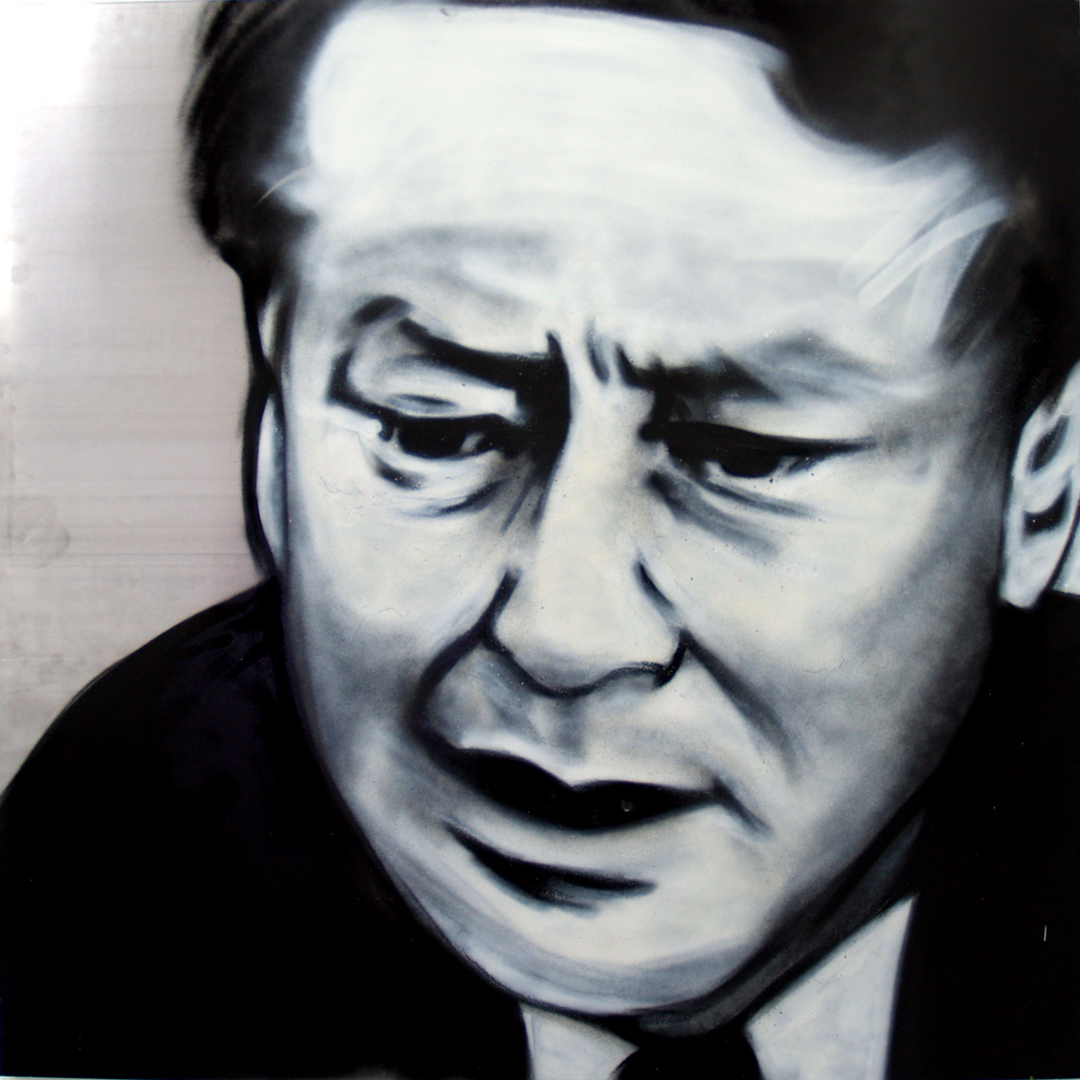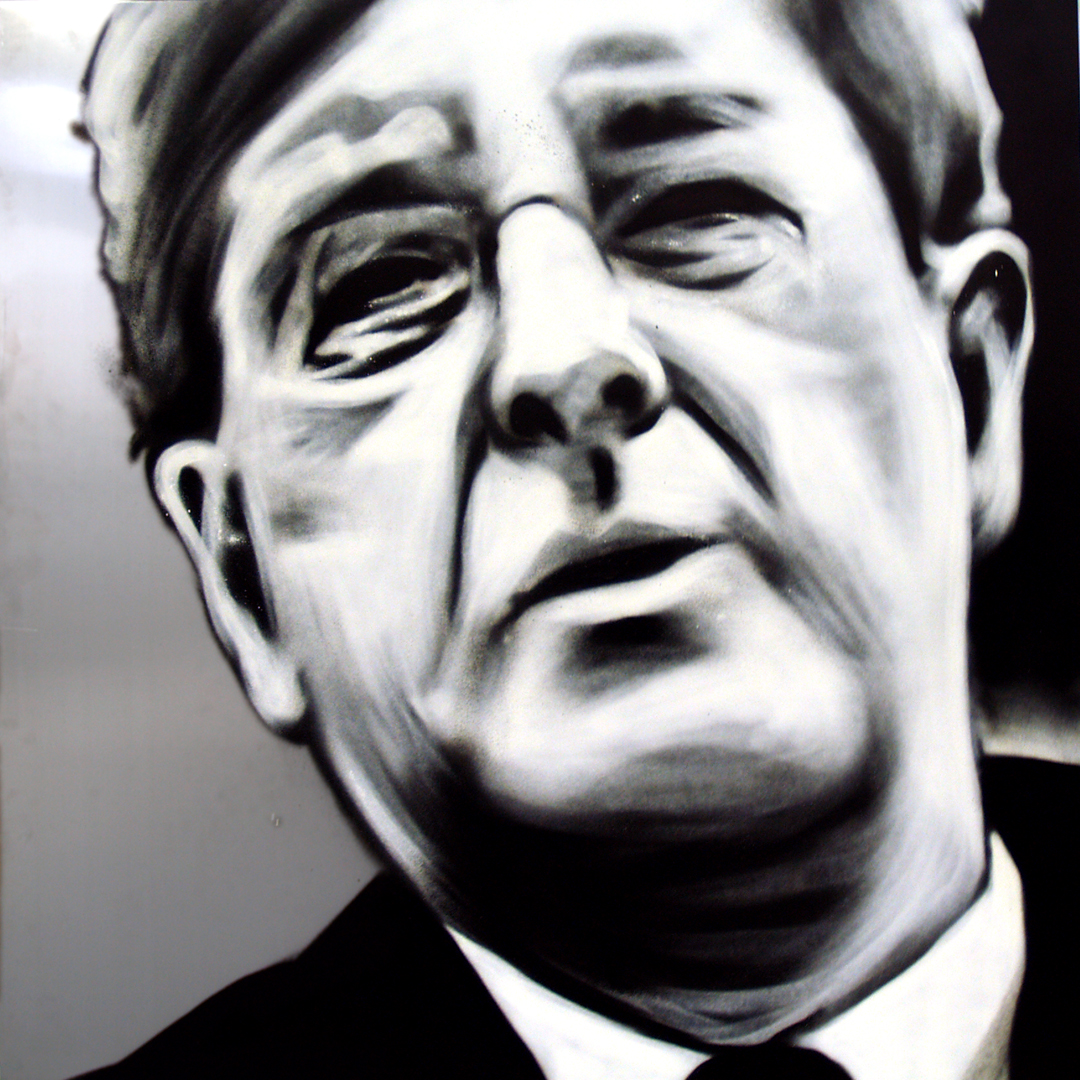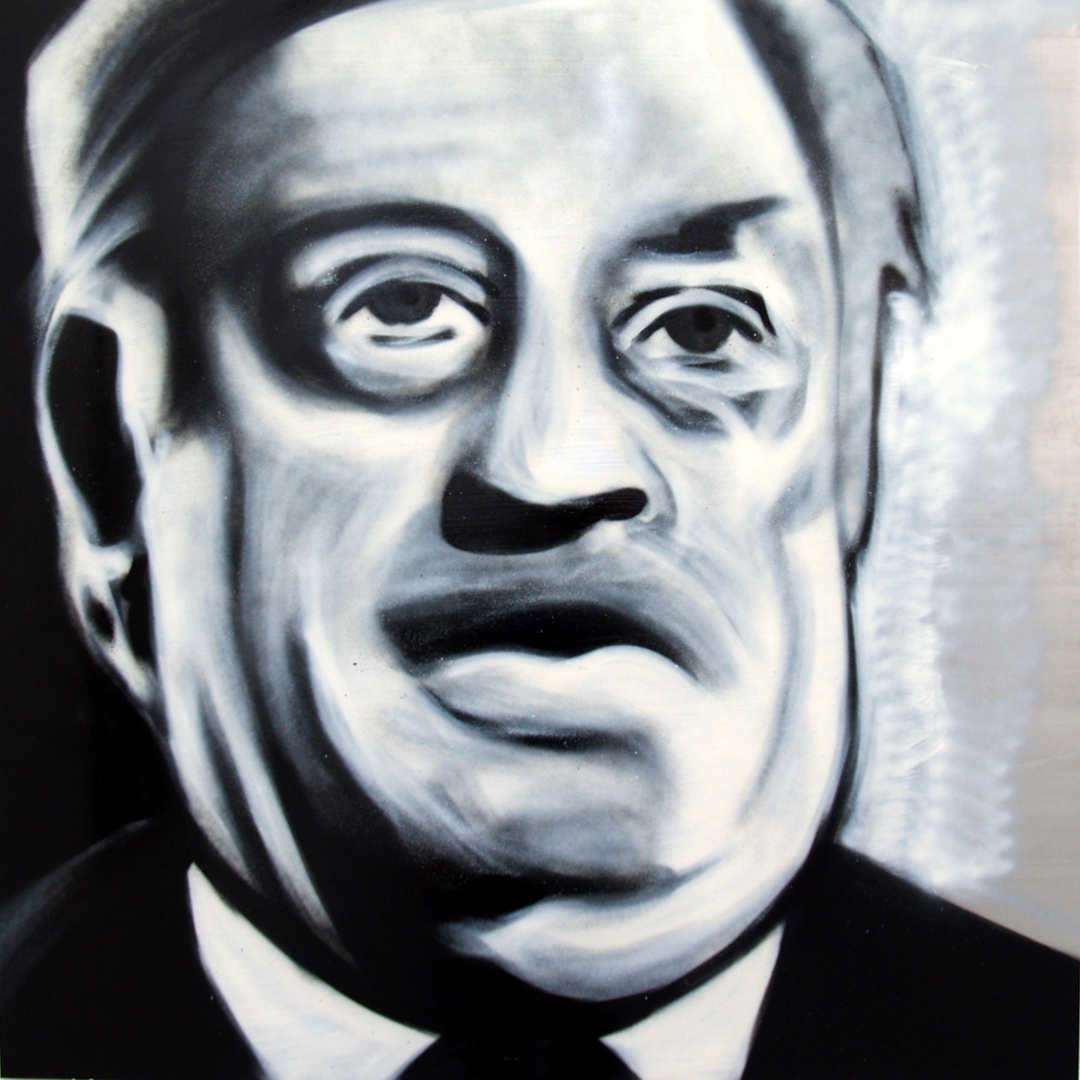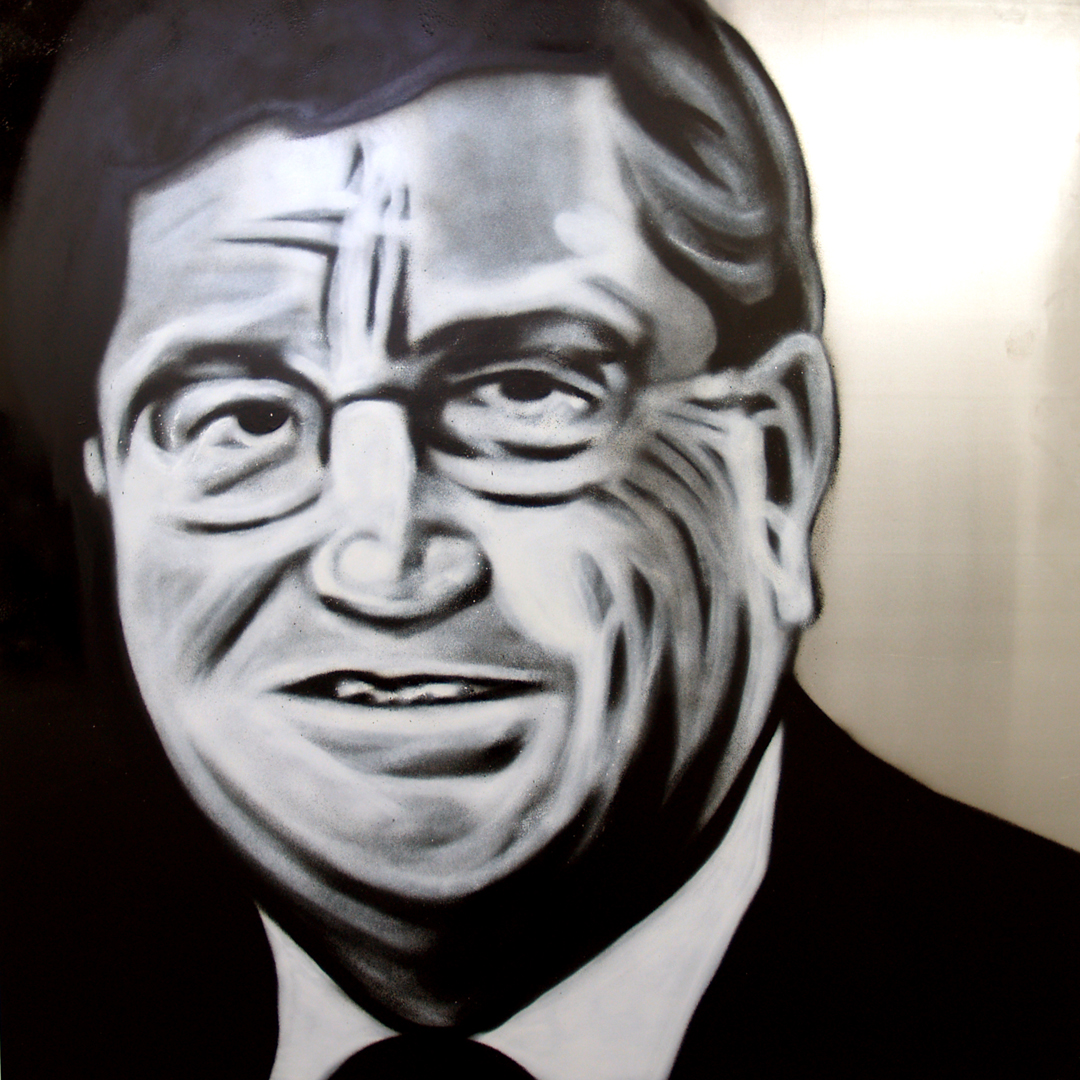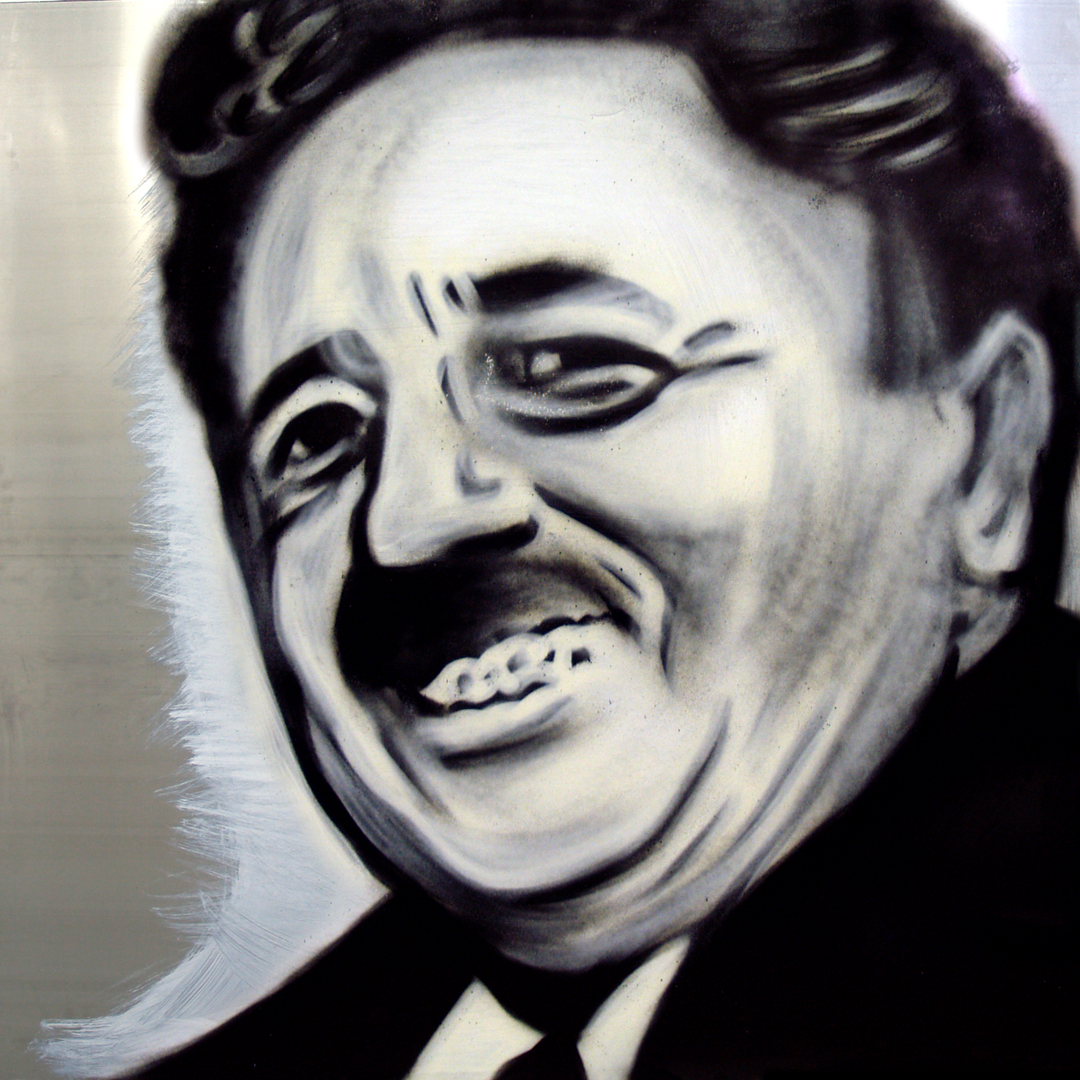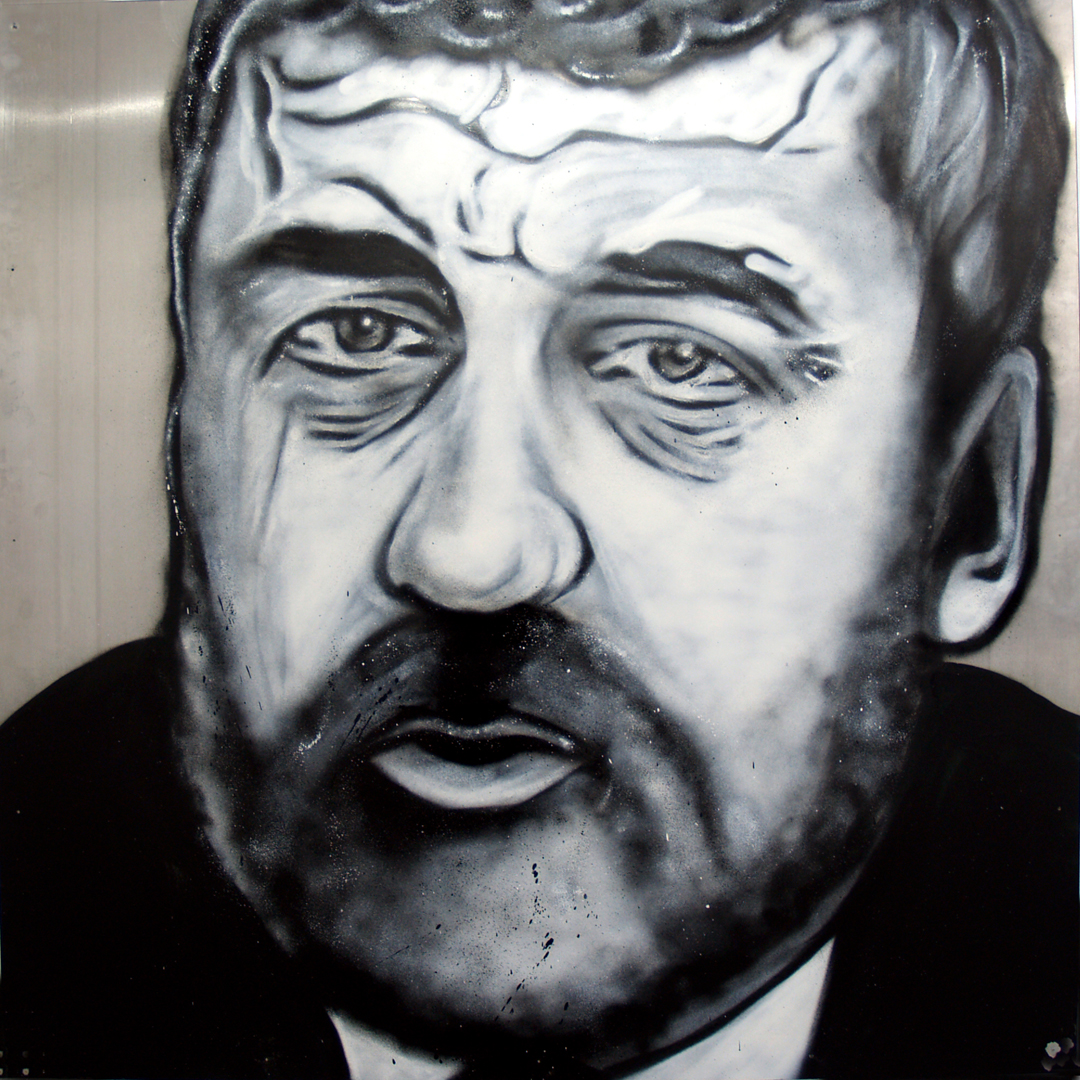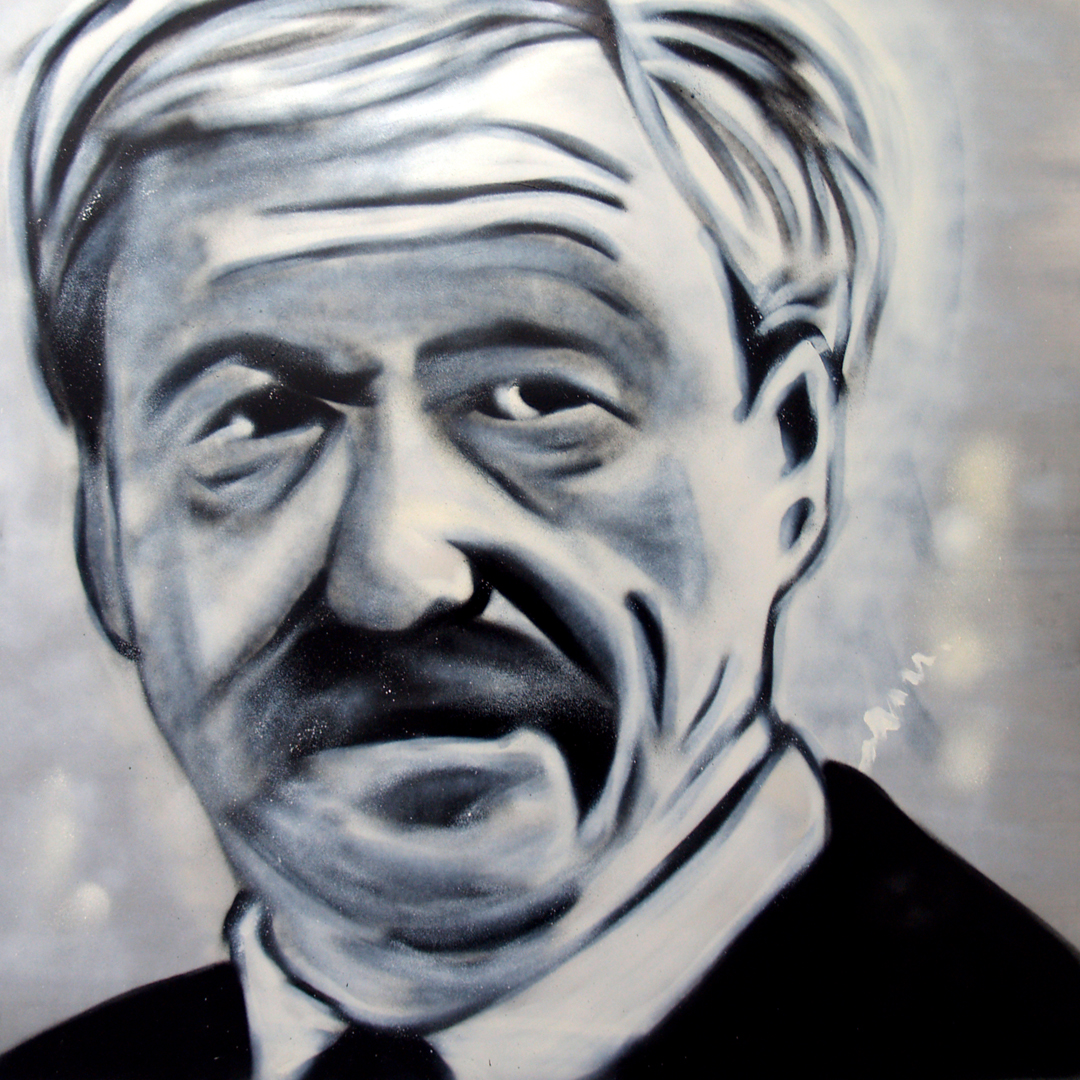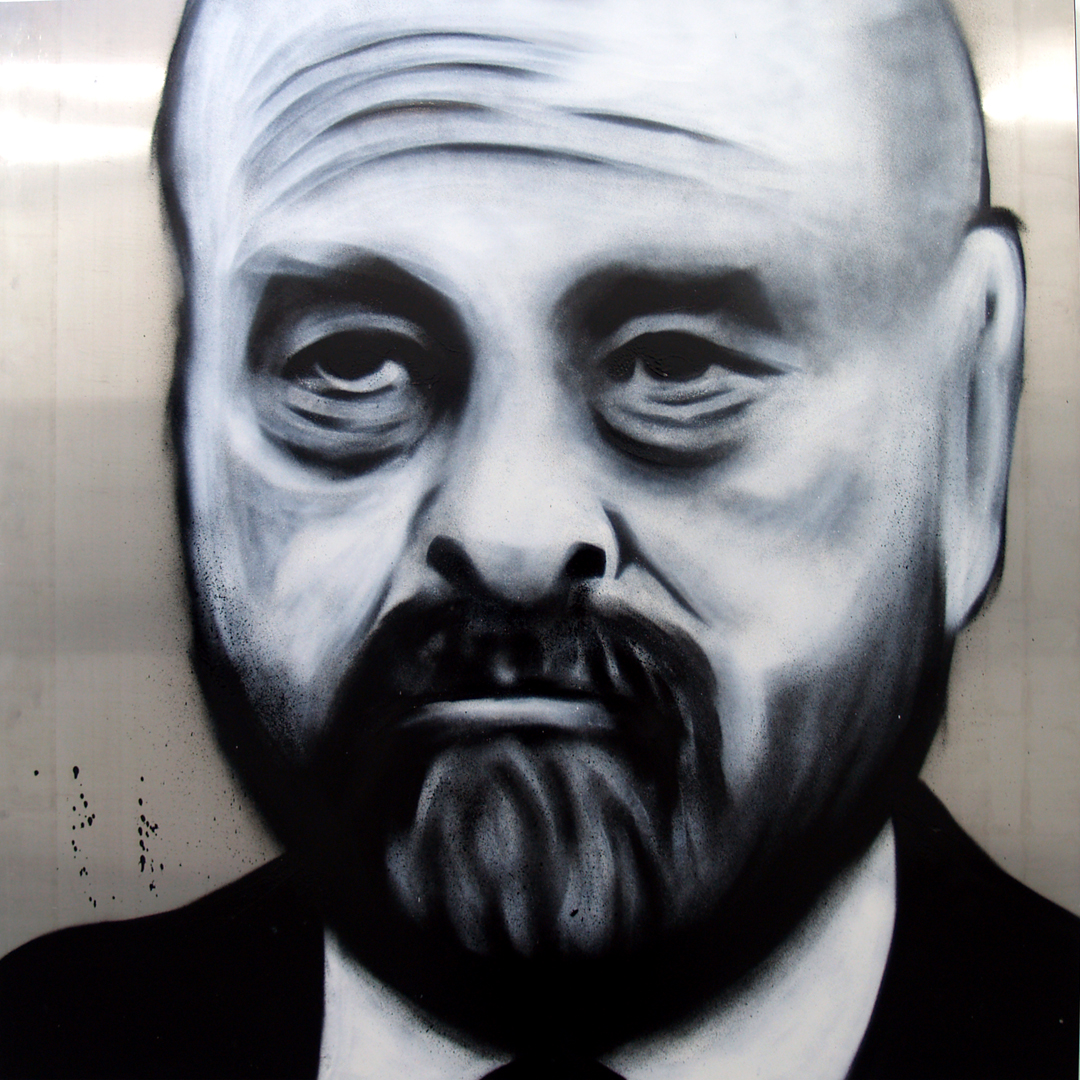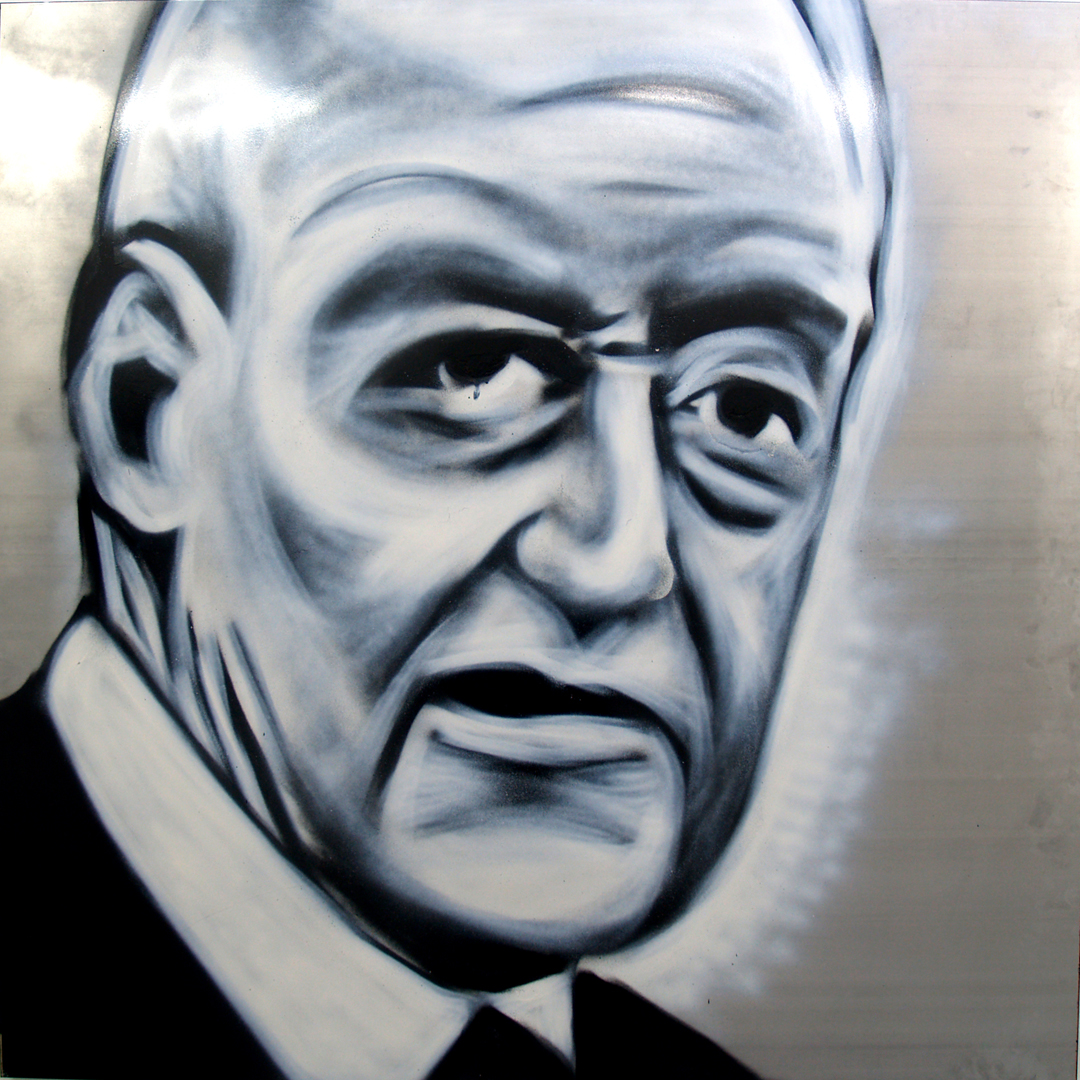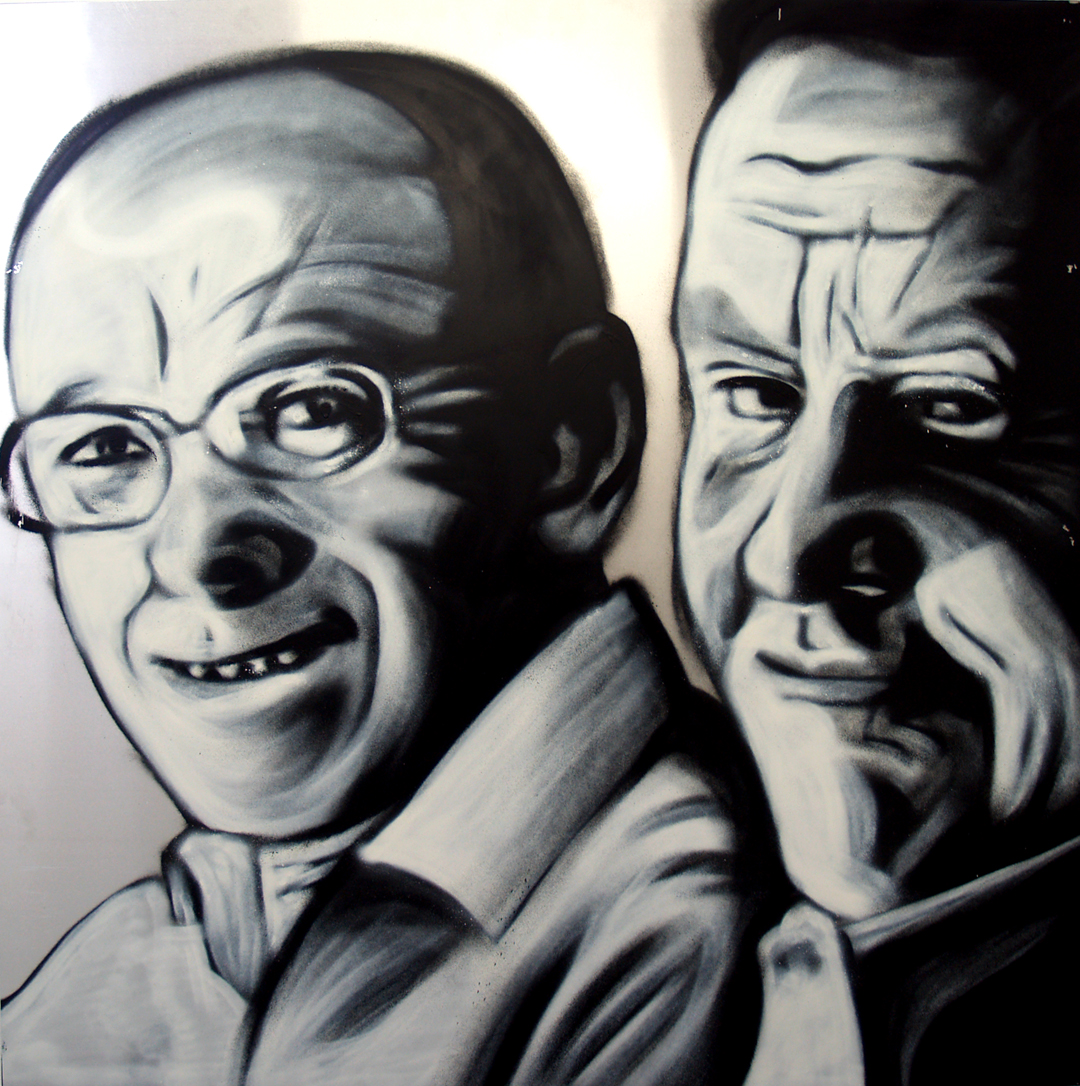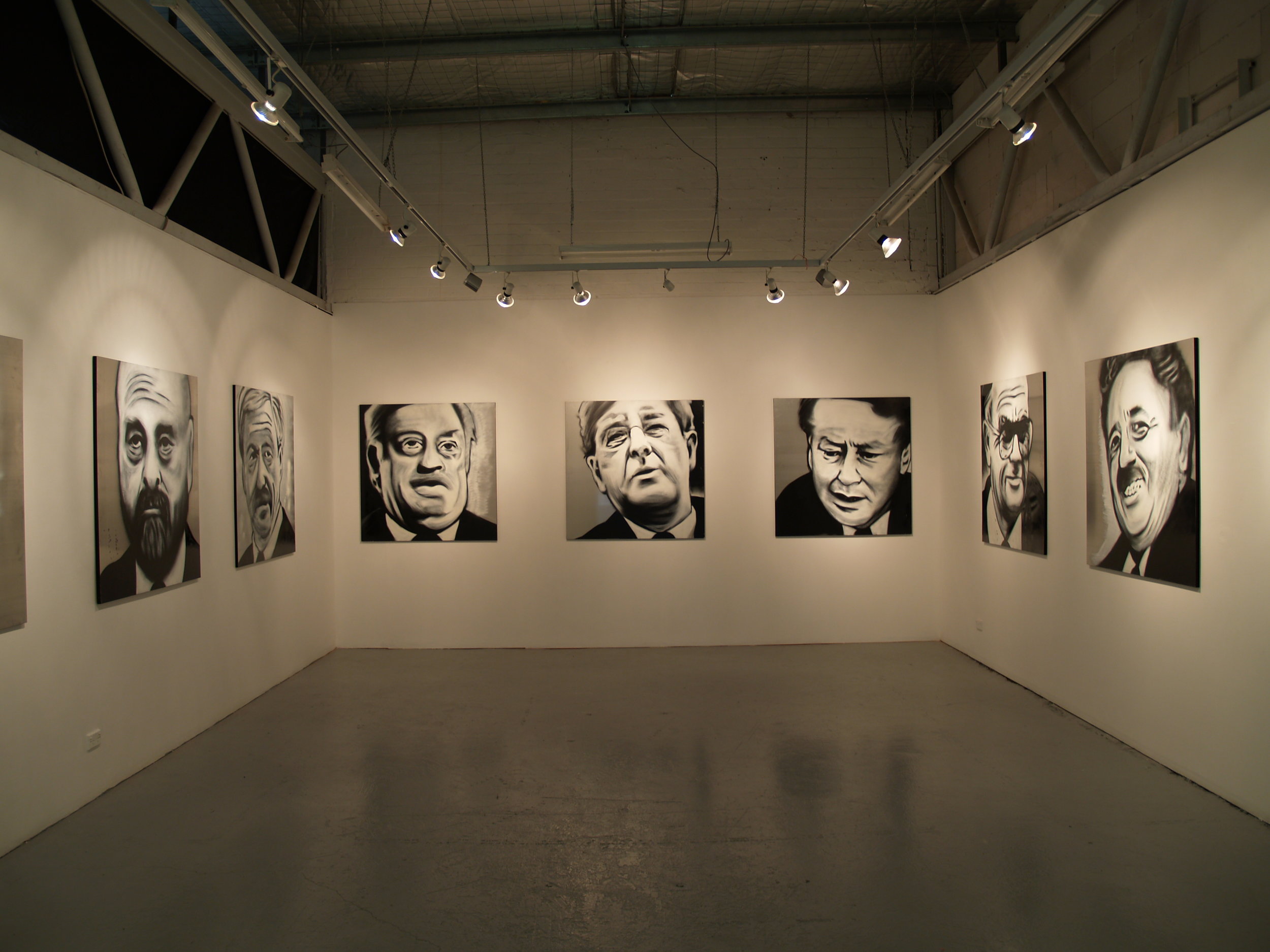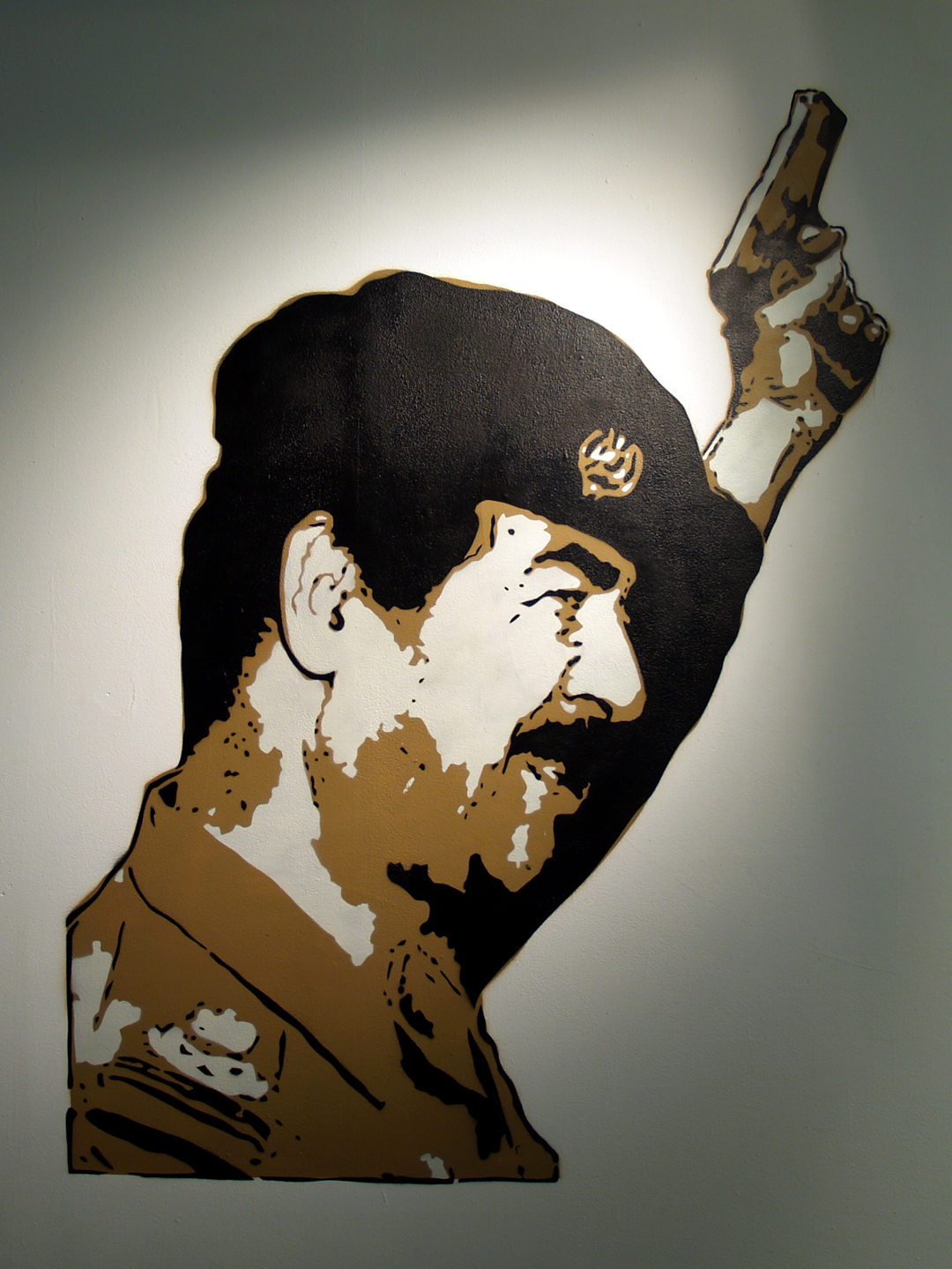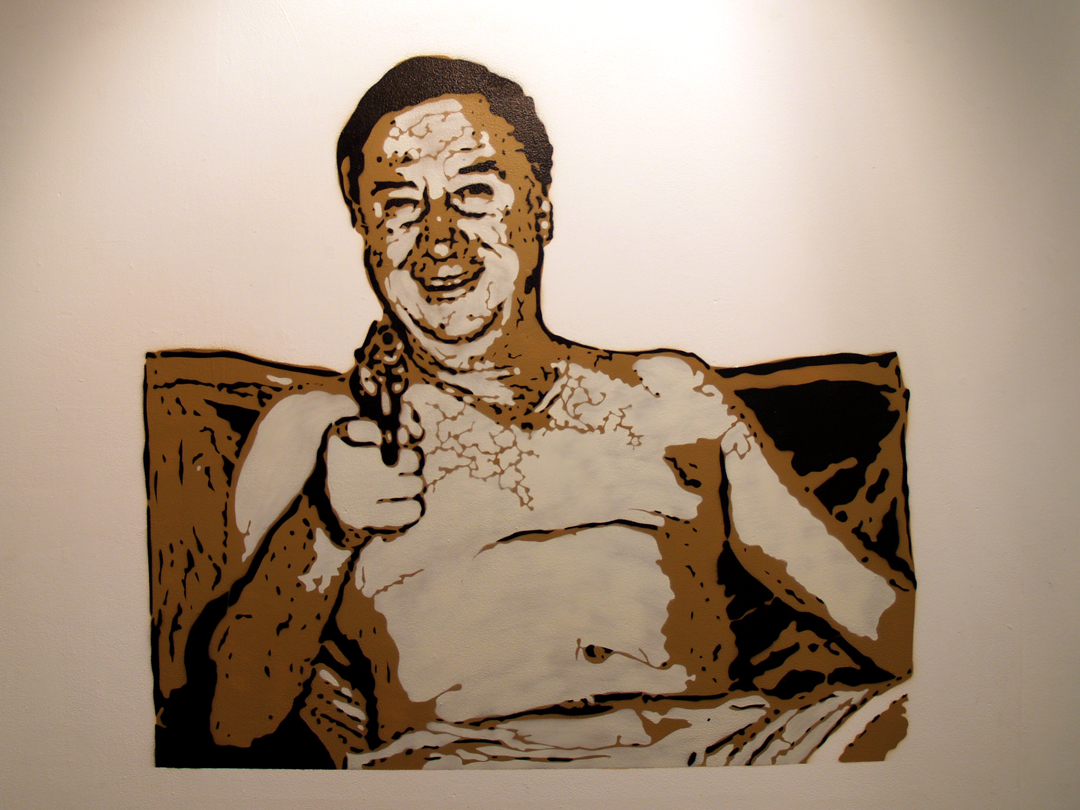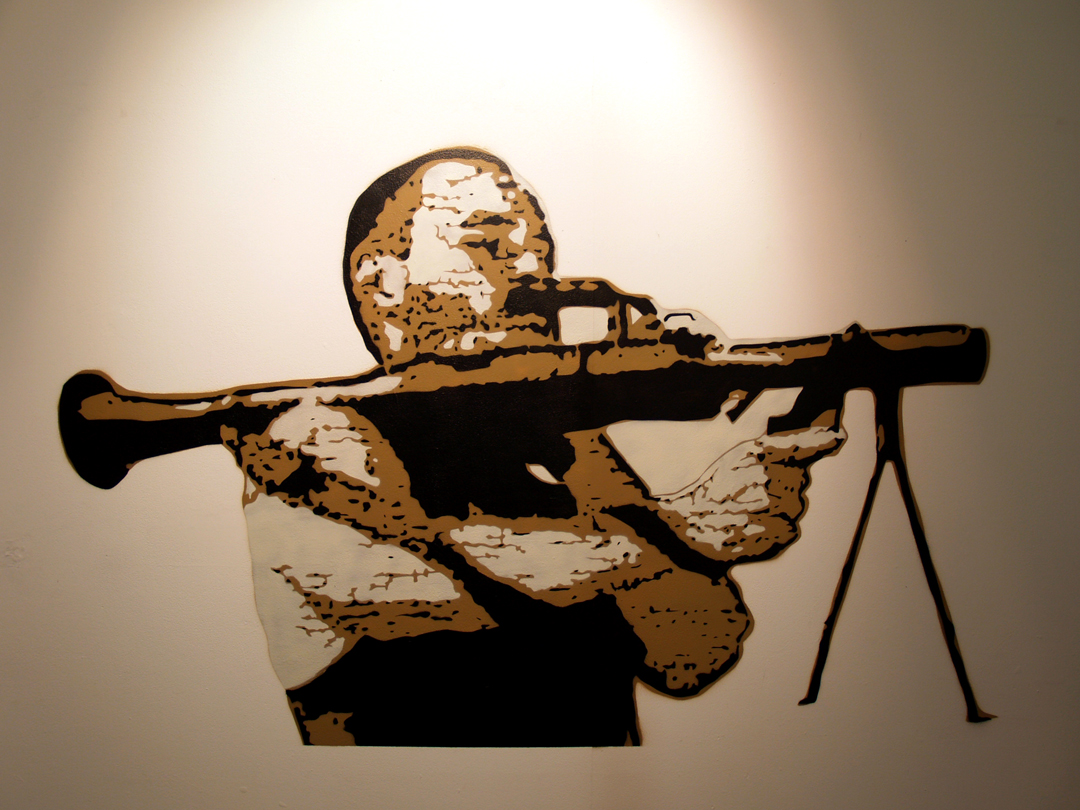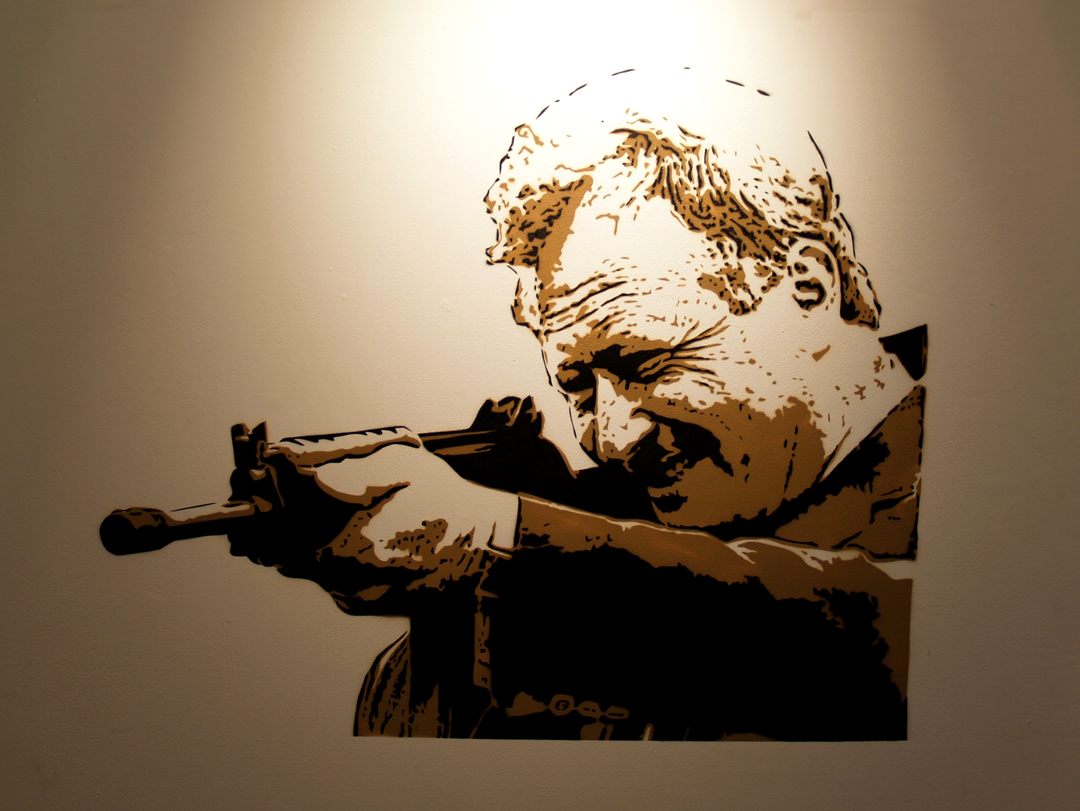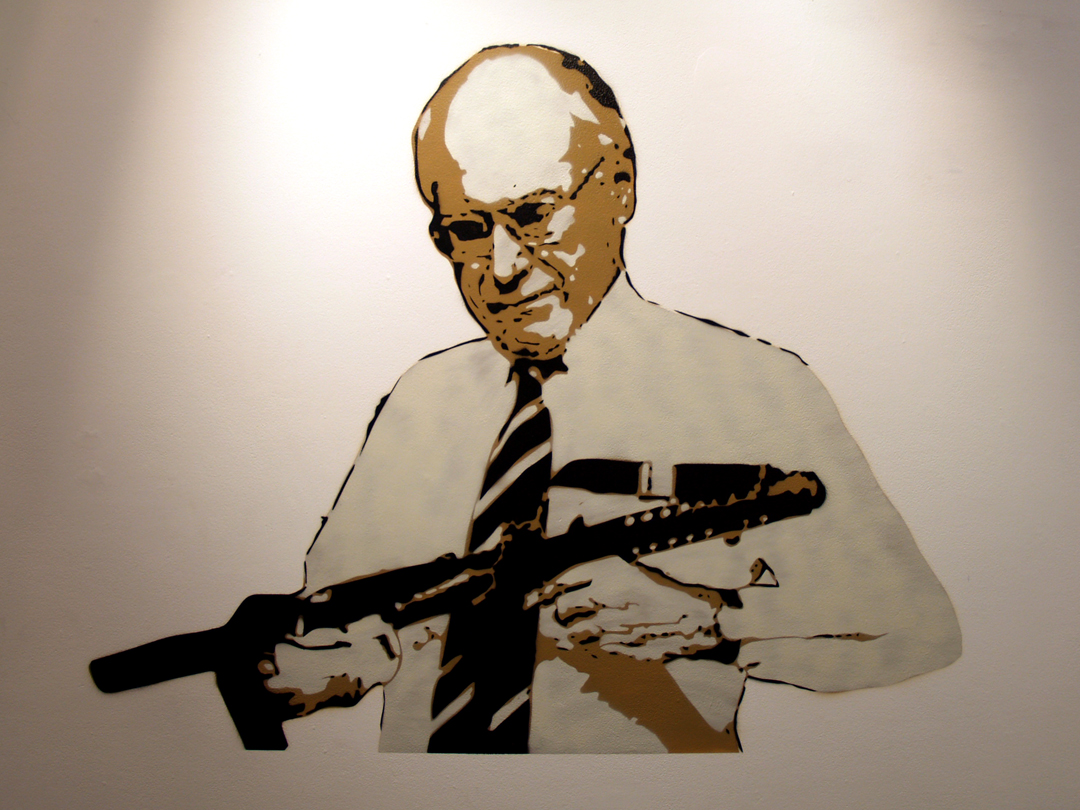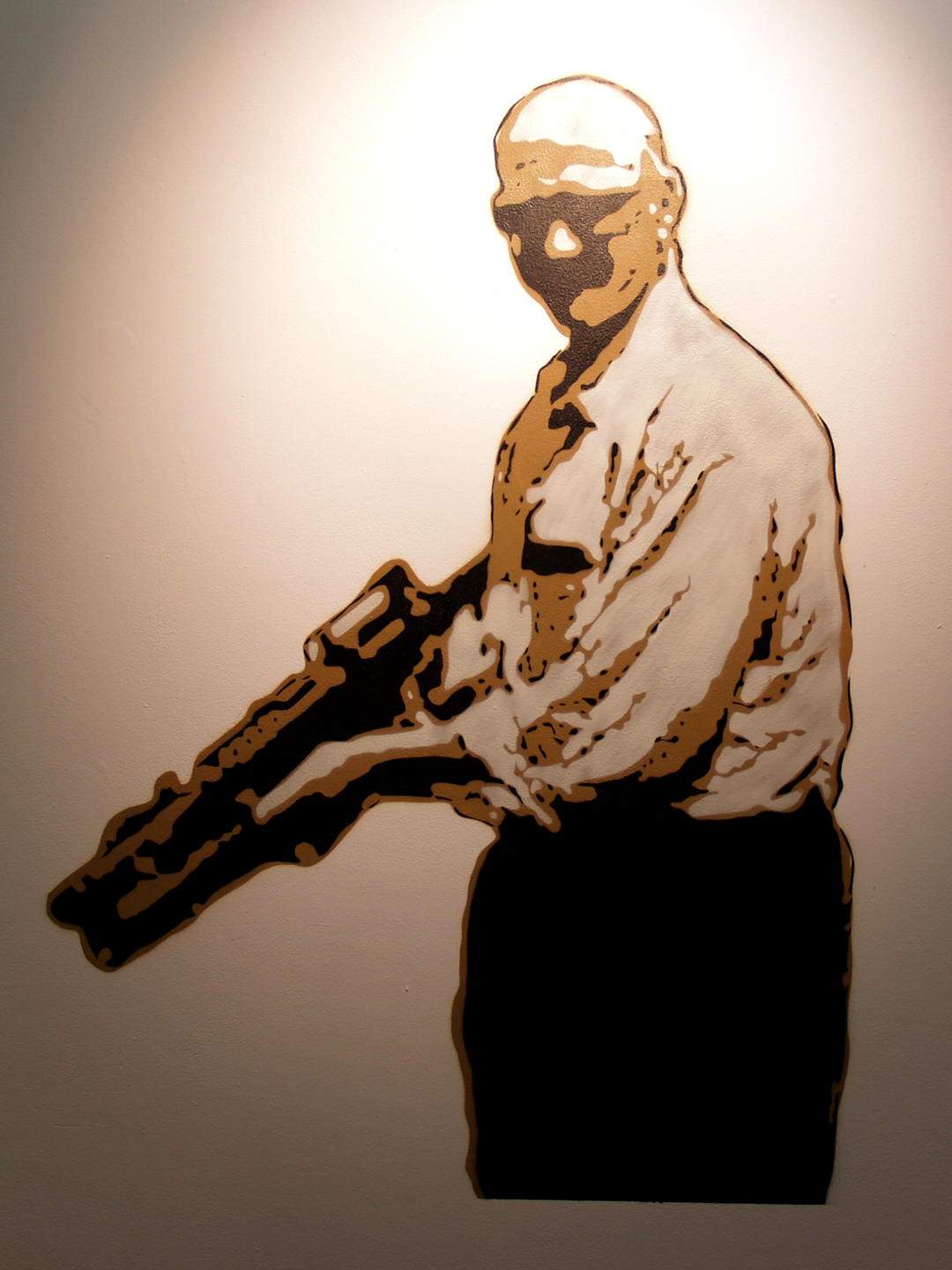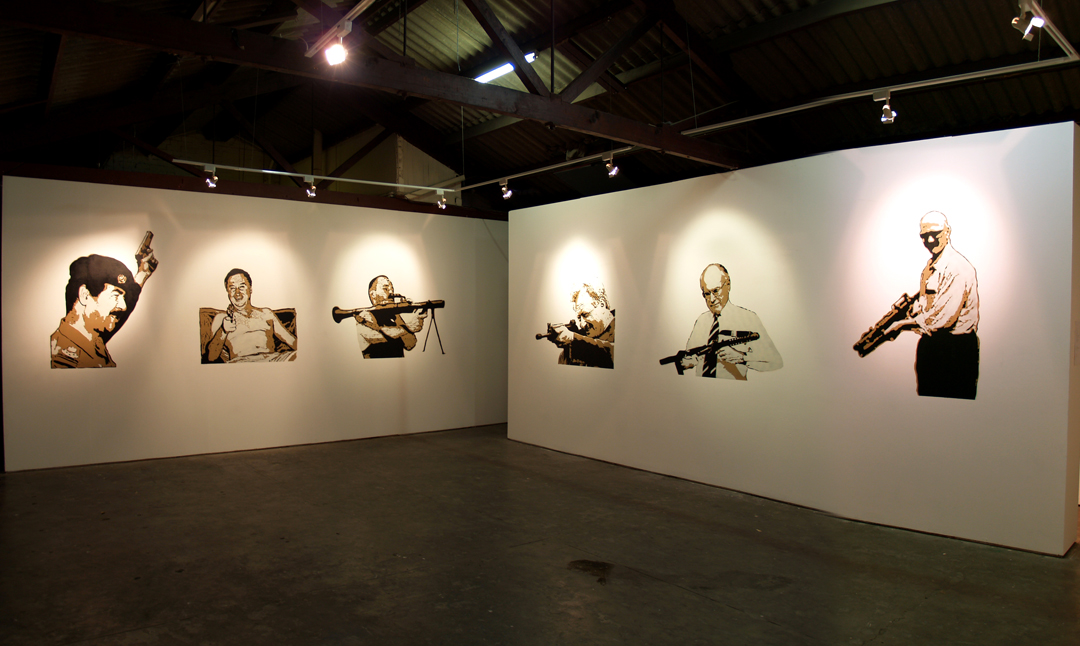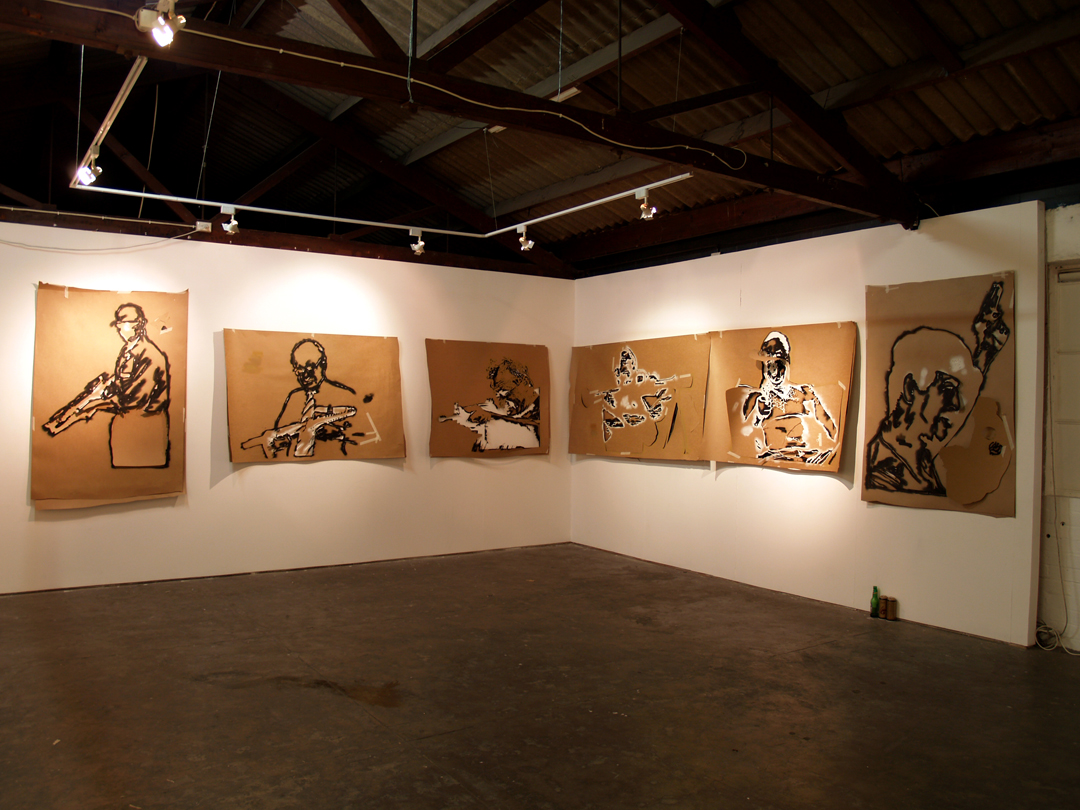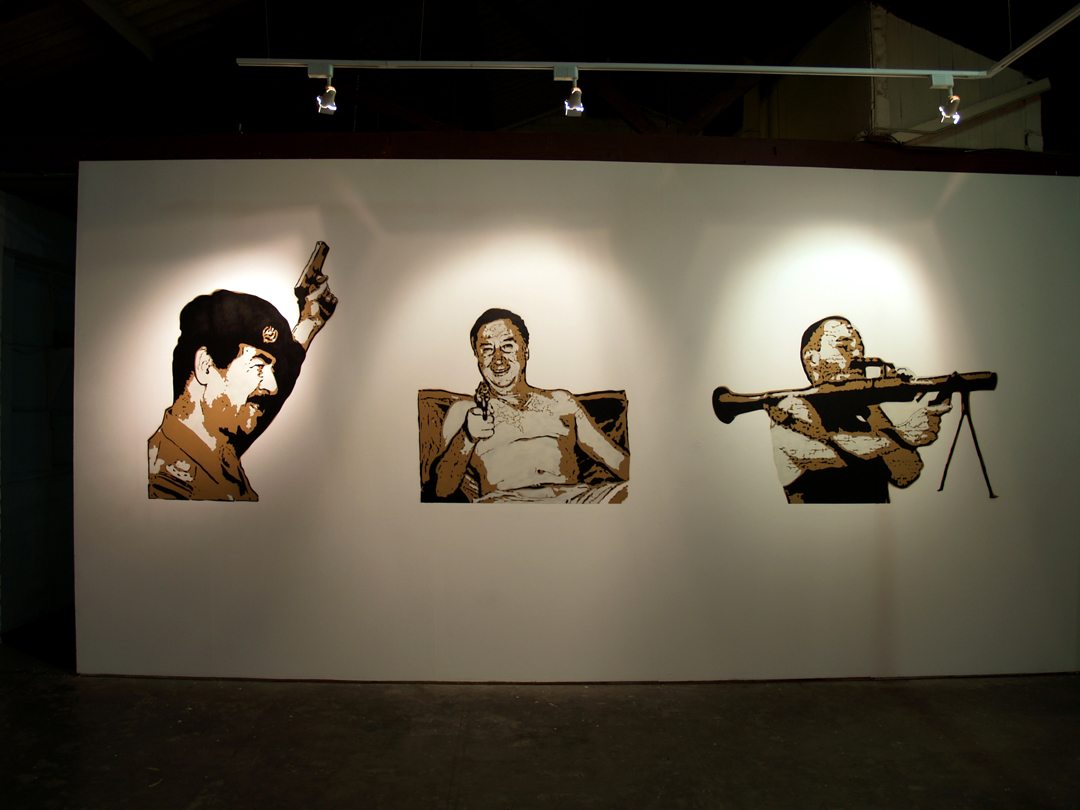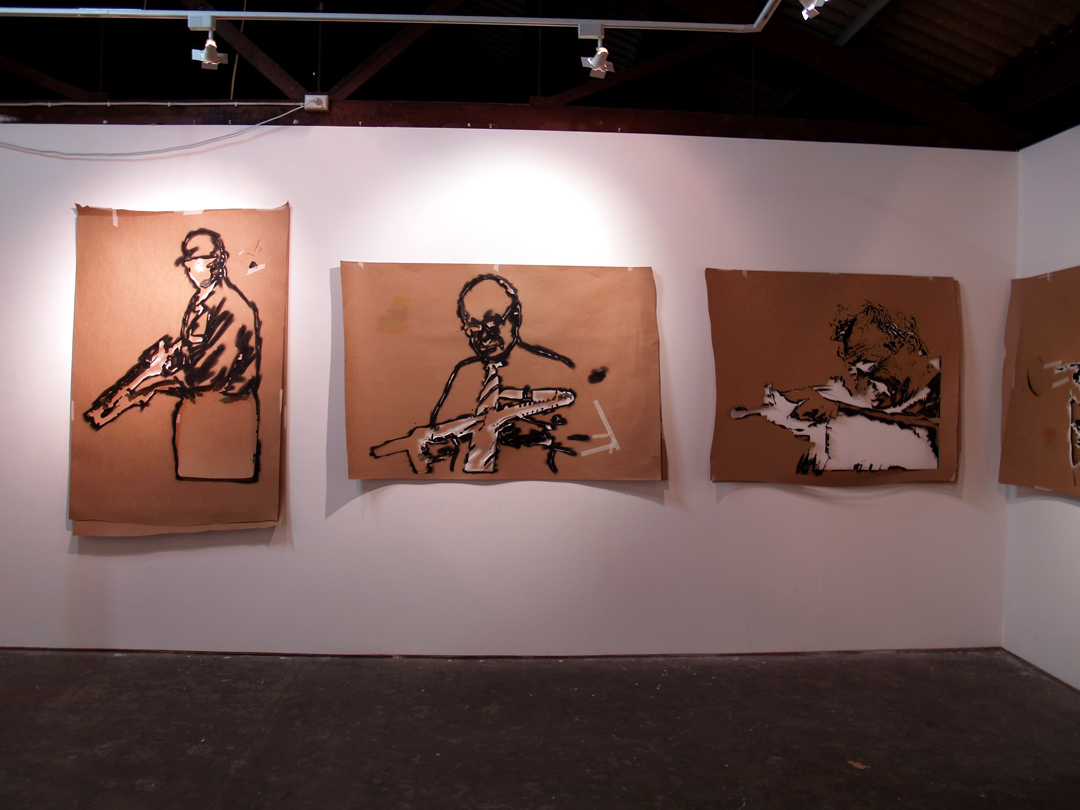Fugitive identity | 2019
an abstraction of persona through the mask, camouflage and material assemblage
PhD EXAMINATION EXHIBITION, PLIMSOLL GALLERY, University of Tasmania
KINETIKA VII: UMWELT, Jamin, 2019, assemblage (wood, paper, LED), 2.4m x 5m x 5m
ABSTRACT
This research project explores, through a studio-based investigation, a condition of identity that is fugitive in nature – that of a persona – the experience of shifting and mutable roles and contexts framed as an array of literal and metaphorical masks. This condition is explored through a body of work that employs lenticular stencils, termed ‘masks’, to produce disruption patterns that encourage an active and dynamic interplay with the observer, resulting in a tension between the virtual, the real and the actual. An analysis of the mask and strategies of masking (covering, modulating, protecting, dissimulating etc.) are located and discussed within a range of art practices, where the mask is observed to be a material-semiotic actor in a network of relationships that enables the performance of camouflage. Camouflage is introduced and observed as the strategic relating (an active process) between an entity and the parts of the world to which it belongs or dissociates; a fluctuating of the senses between sharpening and blurring that produces an experience of the world that is particular and partial – an umwelt as defined by Jakob von Uexküll. This framework proposes that identity is not to be understood as a static, fixed entity but rather as the product of a series of events or performances that are constantly in flux, as defined by Giles Deleuze in The Logic of Sense (1993). The practical investigation moves through a series of experiments that explore dimensionality within a painting-based practice, employing strategies such as masking, stencilling, cutting, layering, reflecting and repeating; moving from a single picture plane through to multidimensional and assemblage-based works that employ heterogeneous materials and processes focused on the kinetic movement and proprioception of the observer. This investigation is contextualised through the environmental assemblages of Robert Rauschenberg, the lenticular optics of Victor Vasarely and Lincoln Austin, the persona of Andy Warhol, the technological assemblages of Ivan Navarro, and the camouflaging strategies of Lee Yong Baek, amongst others. It proposes a practical methodology of heterogeneous assemblage, as defined by Manuel DeLanda, in which simple interactions between limited components can produce an infinite array of complexity and potentialities. This has resulted in a body of work employing machine-cut layered stencils, described as lenticular masks, that interfere with human gestalt perception, producing a real and granular encounter with emergence; a becoming real through the interaction of systems, one territory opening onto another, moving from a representation of camouflage towards an active and dynamic performance of camouflage. The shifting apprehensions of pattern recognition in the final works allow for a new understanding of identity; one that is in a state of active camouflage, a fugitive in the mask of a persona.
FLOATING POINT | 23 APRIL - 11 MAY 2019
FLINDERS LANE GALLERY, 2019
Please contact Flinders Lane Gallery for all sales enquiries: info@flg.com.au
CATALOGUE ESSAY BY SCOT COTTERELL
Athanasius Kircher the German Jesuit scholar and polymath introduced the term tabula scalata or ladder pictures in 1646 after painter Jean François Niceron described the technique in his 1638 ground-breaking book La Perspective Curieuse. The technique, an early version of what we now call lenticular images, forms a suite of visual and scenographic effects along a continuing lineage from the ancient triangular periaktos theatre coulisse (used to rapidly change theatrical scenography and create depth illusions), to the tazo (a collectable lenticular minicard included in Australian chip packets circa late 90s). The stuttered, binary animation of the lenticular image and its attendant notions of part trick, part cheap novelty presuppose our now ubiquitous down up scrolling, gif heavy, video saturated social moment.
I have written on Jamin before. His work and he have both changed.
I know him as a friend. We are on divergent but oscillating paths – fellow travellers of some sort. He resonates and occupies space in diverse and divergent ways. He uses various types of disruptive pattern to dissect, constitute and redistribute images. Jamin has traversed several strata of imagery, all part of the mass mediated flow. I have watched the work flow through dense stark political portraits that betray a corrupt underbelly, to hyper glitz collage mashes of reference-heavy pop decay, to a studied excavation of the optical. A logical evolution of his work is to focus in, isolate and derive information from, this act of looking (visual flux) – you in relation to a thing, perceived by organs; the thresholds of these interactions.
Within the production of effects Jamin explores, image has gone now. At least in these works, the meaning carrier is removed. Now we witness the optic barrier with no penny drop of the visual reference – no untangling of the intertwined visual samples. Things are unanchored, set adrift from the time/place referent implicit in all image sampling. These works are composed in software and then executed by machine and hand – a code. They morph from object to image to decor to concept. They may be portals. They may also protrude into your space.
There is the sensation of travelling and moving data around.
A child sits in the passenger seat of a moving vehicle, alternately testing the wind with a right angled elbow and cupped hand and defocusing his eyes to create a peripheral parallaxing.
Repetition and difference. Animation and fracture. Seeing things.
These works resonate as your retina moves across them. Your gaze; their gaze. A silent geometry acting against you and in concert with your ability to see, to perceive pattern, to compose images, and to infer or impose meaning – ground control receiving transmission optics, locked mid glance, and mid movement. There is a toleration of ambiguity, not by any means a resignation but a denial of the image, instead choosing to focus in on the perceptual moment. These works capture the novel, the epiphanic and elongate it. Jamin exerts and authors control over this visual effect, testing variations on us, with us.
Floating in deep space, cut off from oxygen.
Erasure of identity. Cellular regeneration. Breath.
Scot Cotterell 2019
VECTOR / VOID | 2018
BoAA (Biennale of Australian Art), Ballarat, 2018
This series of work is titled KINETIKA V and was exhibited at the Biennale of Australian Art (BoAA) in Ballarat, from July to November, 2018.
In Jamin’s KINETIKA series he employs a Deleuzian approach towards art-making, each iteration of work within the series (which has its beginnings in 2014 with a work titled Entity) adding or subtracting components, cannibalising previous generations, or adapting new materials. The simple interactions of the layers, and the viewers proximity, give rise to more complex phenomena in a fluid visual language of emergence and potential.
BLACK PRISM | 2017
DESPARD GALLERY, HOBART
STATEMENT:
BLACK PRISM is the title of this exhibition. It is also the name of a metal band from Los Angeles that I have never heard. It is the name of a fantasy book that I have read. And it is the name of an album I am producing as Vibrant Matters. Vibrant Matter: A Political Ecology of Things is a philosophical book that I have read, and it is the name of a series of paintings that I made in 2015. Both Black Prism and Vibrant Matter are seeming oxymorons. They suggest a reality in which there are some very fuzzy edges, where the intensive differences that drive flows, are actually as interesting (maybe more so) than the outcomes and neat manifestations of what we consider to be the rational and correct reality.
As a graphic designer in the print industry in the mid 90’s I spent many hours removing moiré patterns (undesirable artefacts) from rescanned photos. This was achieved by changing the angle of the photo on the scanner bed, or by drastically increasing or decreasing the resolution, or by some other arcane trick. However undesirable these artefacts were, I was continuously struck by their beauty and their seemingly magical appearance in the otherwise mundane imagery from which they were removed – such as the self congratulatory photos of national Lions Club members disbursed to their regional newsletters, or the butchering of one Mitre 10 catalogue to feed another.
These moiré, or interference, patterns spoke of another reality, a more subtle and occulted space of frequencies and multiple perspectives. I would view an analogue TV through the lens of a handy-cam to experience the strobing moiré of the screen. As a guitar player during those years, I also experienced interference patterns as I tuned my guitar, the subtle beating of two notes of similar frequencies coming together as they found unison in pitch. What was this strange world? What were these strange visible and audible patterns that lurked at the edges of things? Why, during my four and a half year apprenticeship, did I write so many songs and lyrics to the regular and irregular clacking and whirring of the print machines? Did their drone like hum and monotonous beating, alongside the endless retyping of banal advertising copy, create moiré patterns inside of my head?
Probably not. But the moiré stuck, as did a general attraction to industrial materials and processes. Aluminium printing plates have here been replaced by ACP and the offset printers replaced by stencils, spray paints and CNC machines. The technology, and the materials it produces and that produce it, continuously create moments of unevenness and irregularity that occasionally come together as a note heard in unison, or else as a discombobulating pattern that slides in and out of perception as the medium changes – or as we change our position in relation to the medium.
The medium is the message, yet we settled for a massage.
Jamin 2017
ONE THING BEGETS ANOTHER | 2013
Despard Gallery, Hobart
16 Aug - 9 Sep 2013
Statement:
This exhibition is a series of work concerned with camouflage - in the sense of how one thing relates to another, rather than how one thing hides from another. Specifically, they mark a continuation of my ongoing interest in media processes, knowledge systems and power structures. The works evolve through an engagement with materiality: the plexiglass substrate mediates the subject and the ground whilst continuously occupying the territory of object just as the application of spray paint oscillates between transparency and impenetrability across areas of the screen. Masks have been employed in the creation of the work to continuously reveal and conceal areas of the substrate, an additive and subtractive force at play. These masks, or stencils, are matrices, semi-random in their creation and deployment. The framework for these matrices is one thing begets another, each cut line informing where the next occurs, and each layer arranging and colouring the next. These matrices operate individually and collectively, often intersecting to create new arrays of arbitrary quantities. Enmeshed within the matrices are elements of form and colour which occasionally coalesce into figures or symbols. These areas have been treated with paint in much the same manner as has the rest of the matrix.
The video work, Entropic-Extropic, mimics the methodology employed in the painted works via a different set of processes. Fine particles of paint, dust and detritus have been manipulated to coalesce and fragment according to my level of interest and surveillance.
The Death of David Walsh is a painting that has been created using a wire brush attached to a power drill. The areas of image have been subtracted from layers of flat paint by vigorously applying the abrasive tool to the reverse surface of the plexiglass. Each successive layer of paint concealed the previous layer in such a way that the forming image was continuously hidden from view - resulting in a painting that was painted, or un-painted, before it was seen in the manner that you are seeing it.
Jamin, 2013
SHIELDS AGAINST THE ENEMY | 2011
CRITERION GALLERY, Hobart
12 May - 11 June 2011
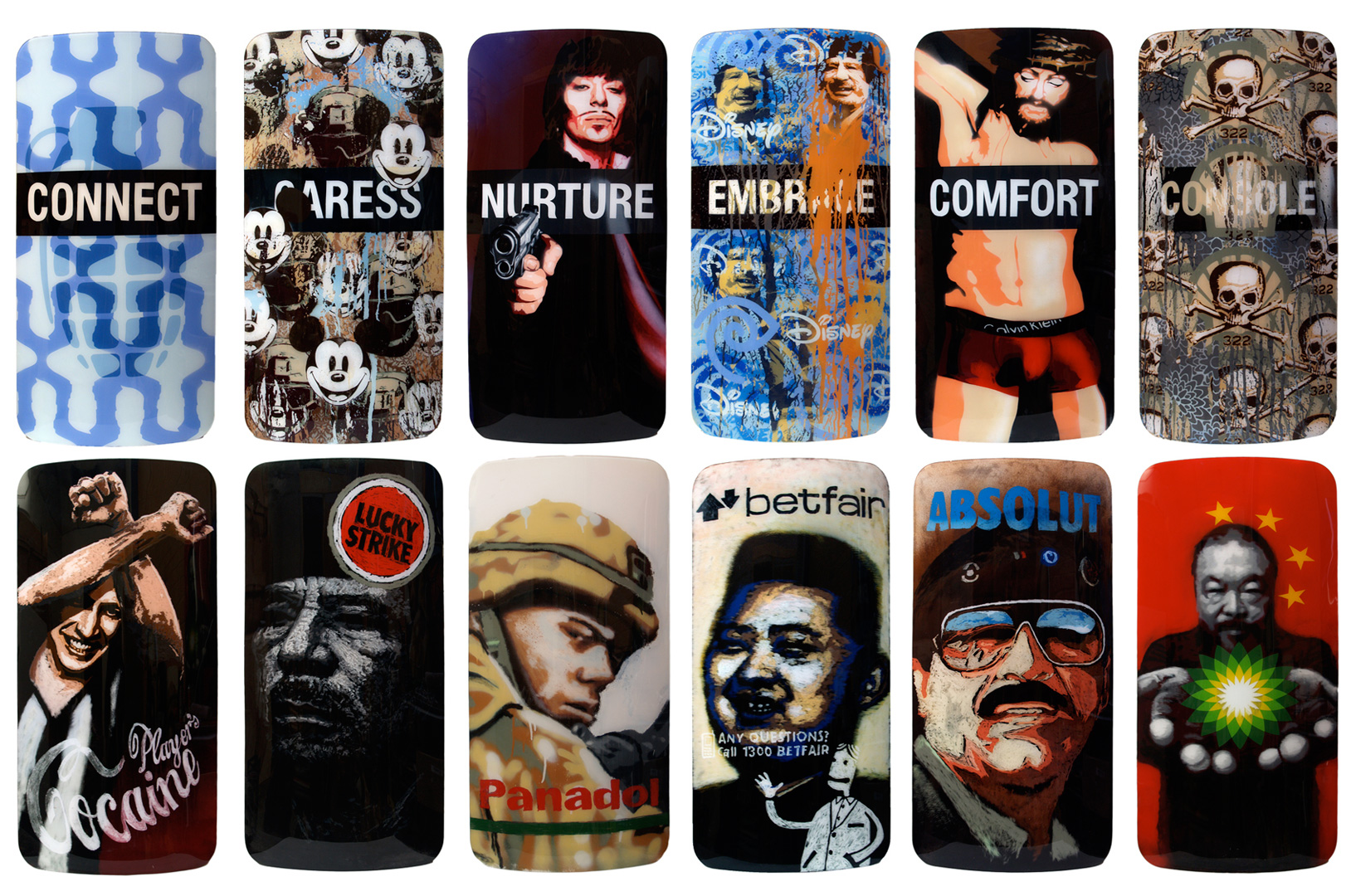
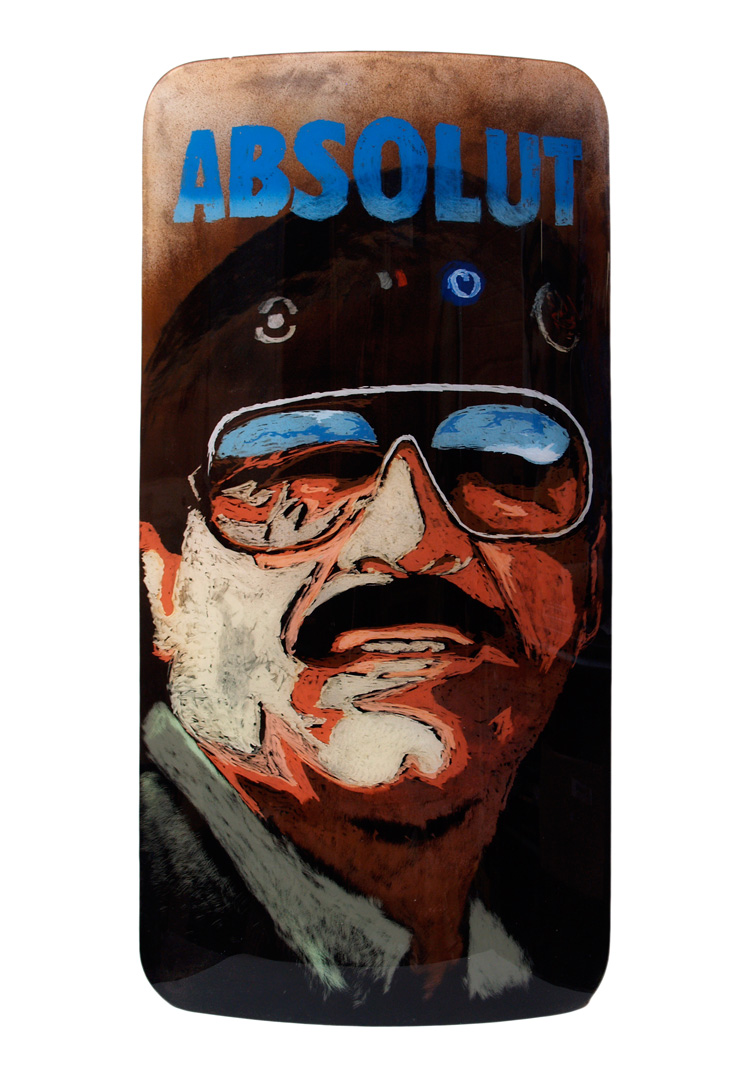

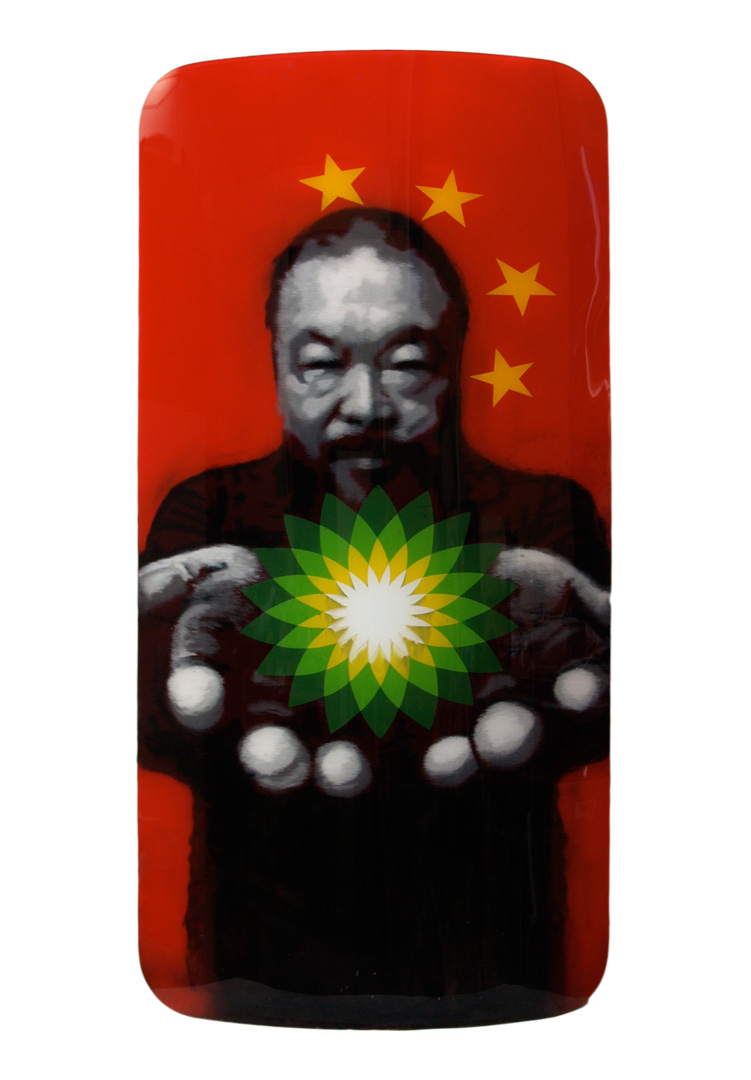
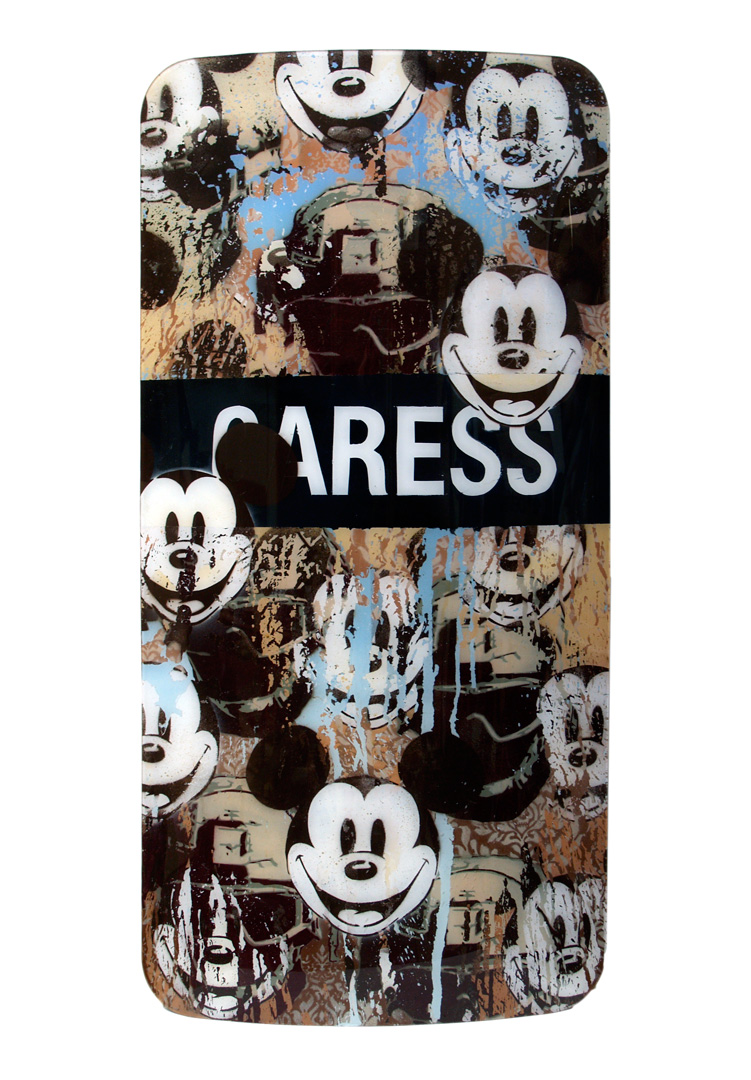
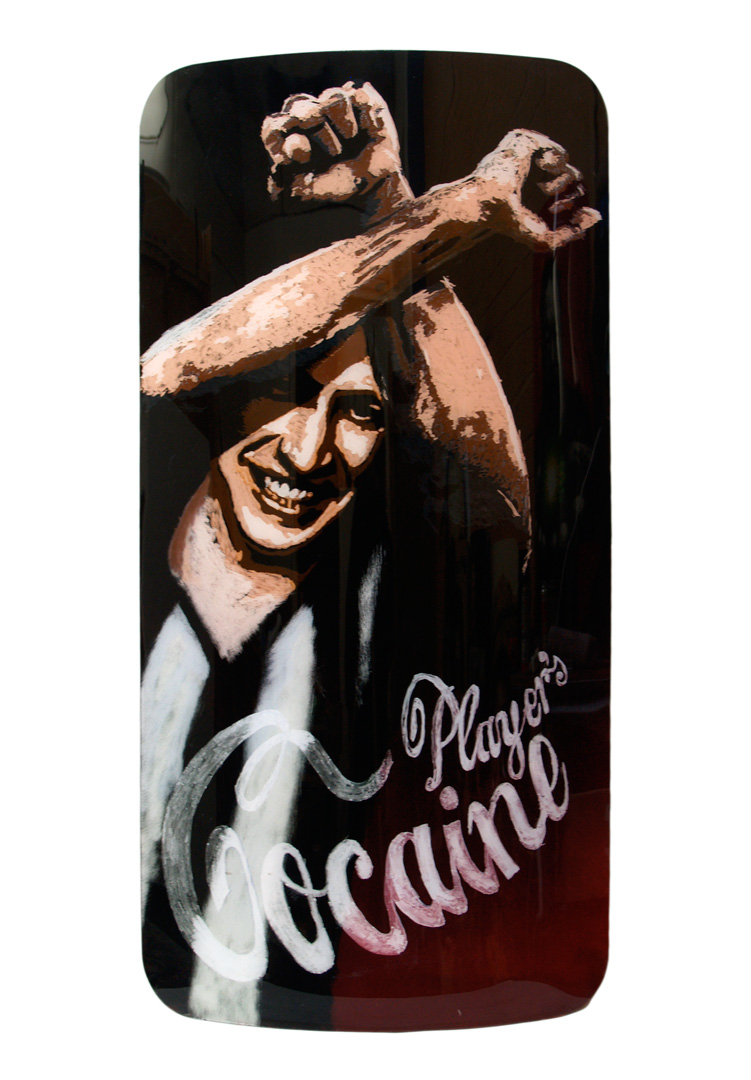
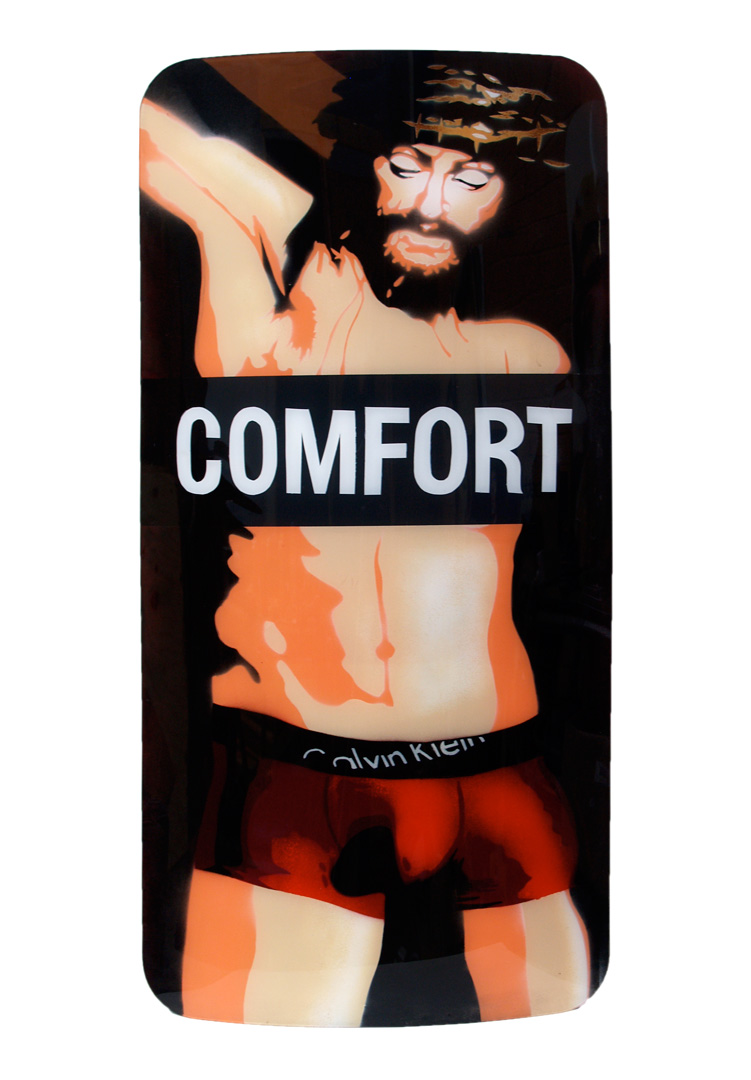
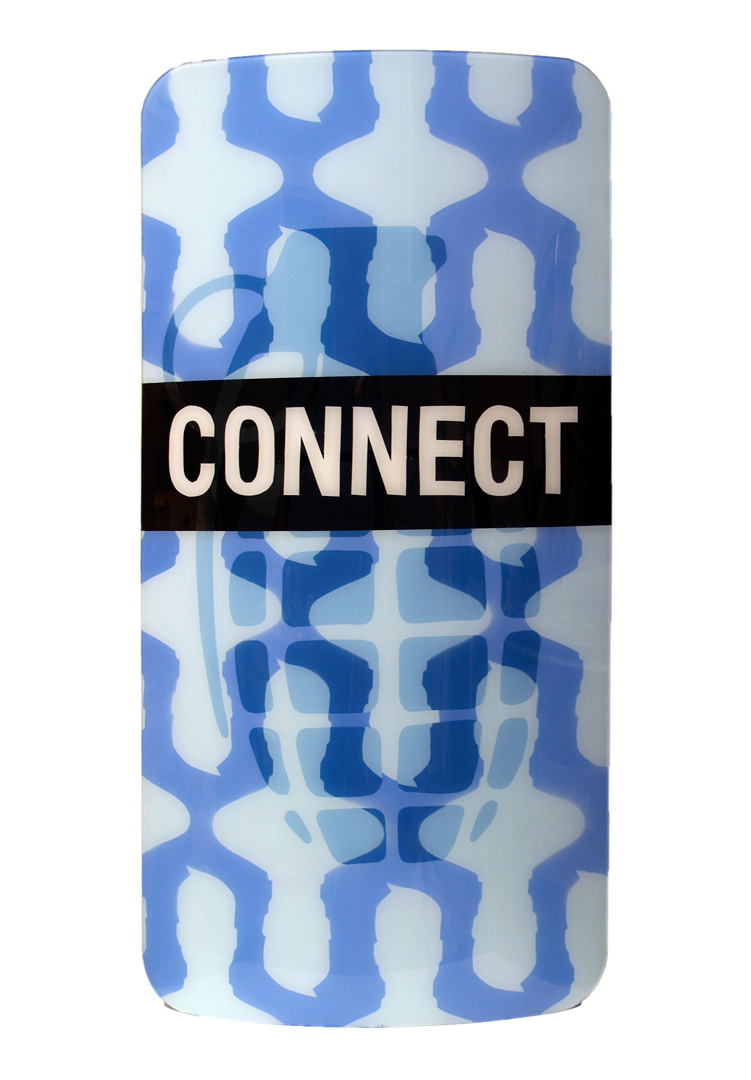
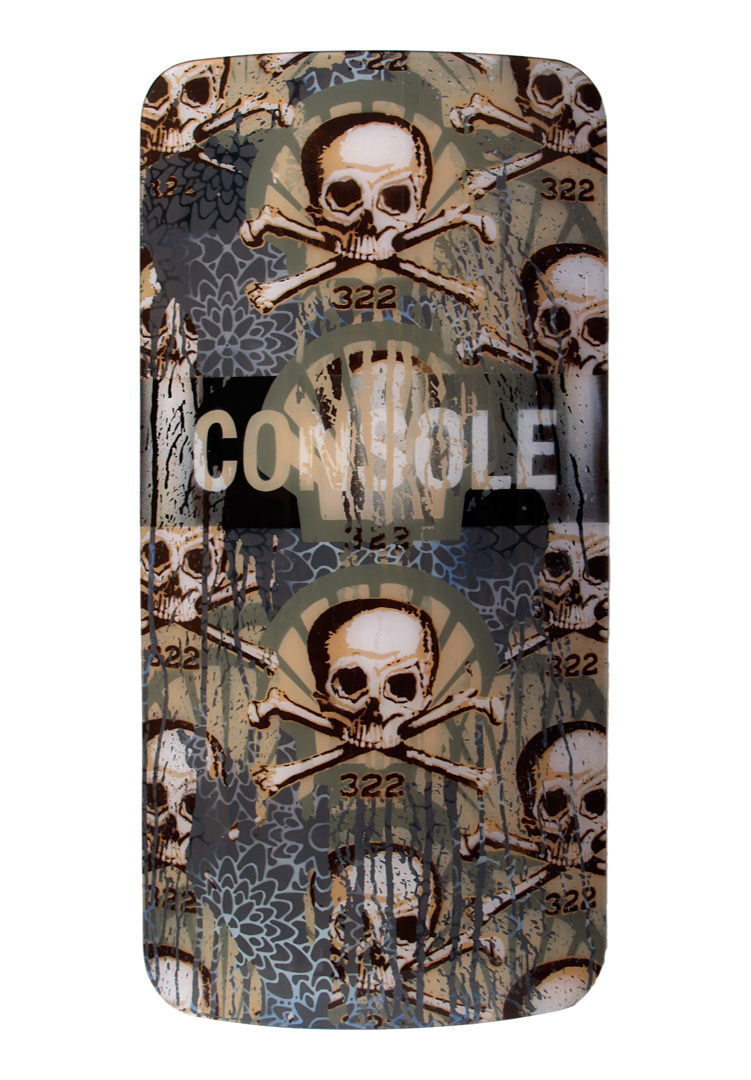
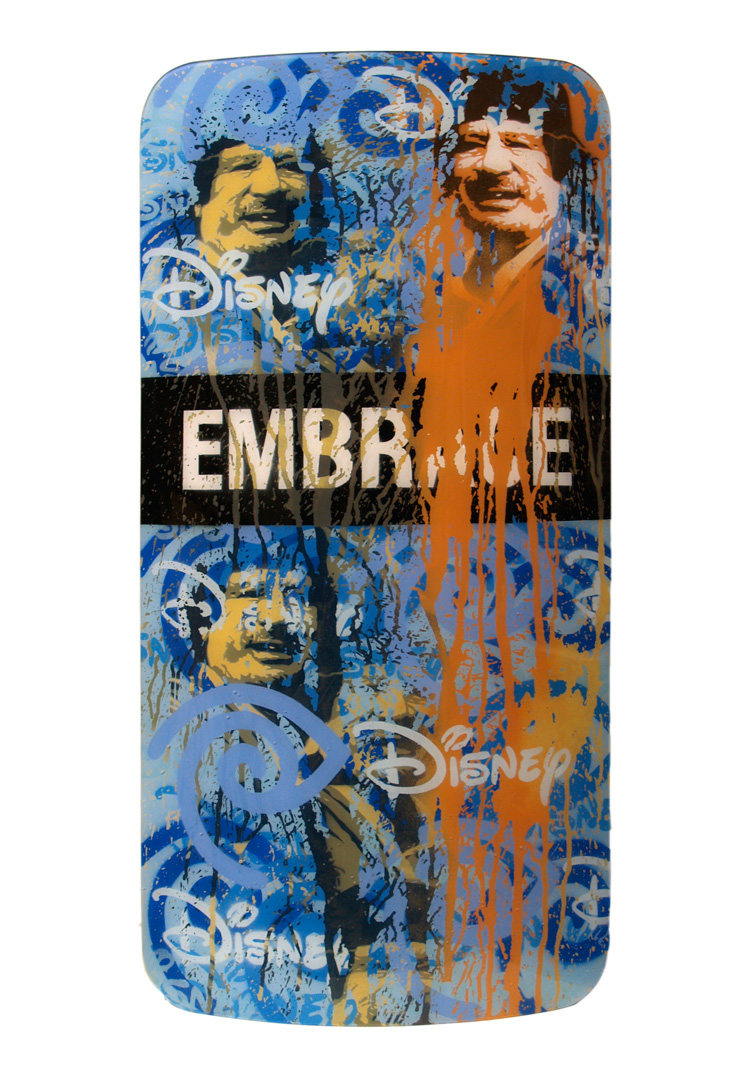

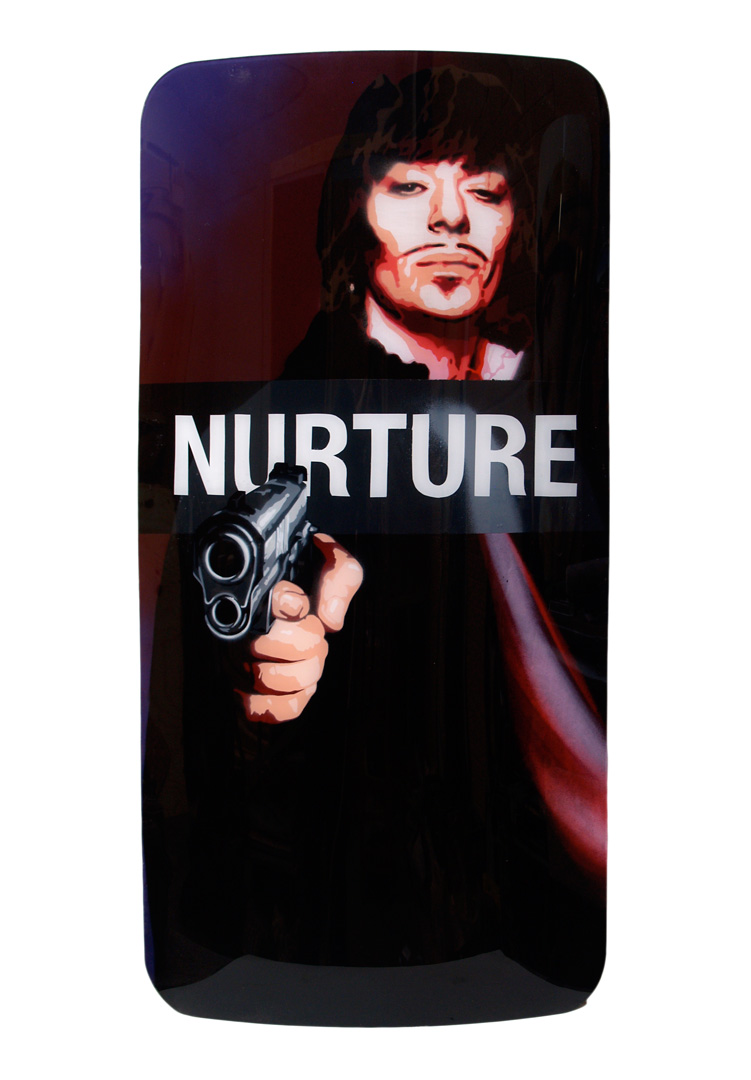
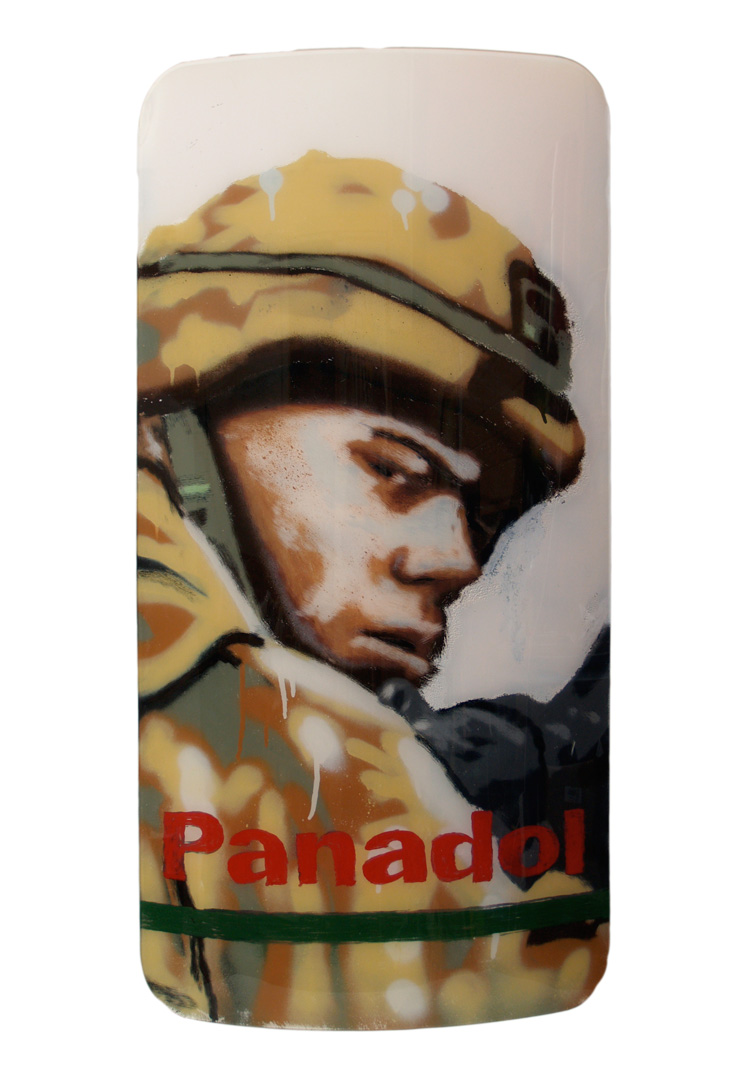
Statement:
Information pours upon us, instantaneously and continuously. As soon as information is acquired, it is very rapidly replaced by still newer information. Our electrically-configured world has forced us to move from the habit of data classification to the mode of pattern recognition. We can no longer build serially, block-by-block, step-by-step, because instant communication insures that all factors of the environment and of experience co-exist in a state of active interplay. 1
We live in a relationship with the world that is mediated by competitive forces. It is a marriage of lust and violence, woven into a mythic narrative about ourselves in which we figure as hero, saviour and inheritor of a blessed heritage. We are possessed of a most potent salve of self-forgiveness and a scathing tongue of recrimination. We are the adepti at the Church of Lesser Evils.
I see in the near future a crisis approaching that unnerves me and causes me to tremble for the safety of my country. As a result of the war, corporations have been enthroned and an era of corruption in high places will follow, and the money power of the country will endeavor to prolong its reign by working upon the prejudices of the people until all wealth is aggregated in a few hands and the Republic is destroyed. 2
Throughout history we have sublimated our transgressions against the other. In turn, we have accreted in vast storehouses the memory of transgressions committed against us. We hold the potential energy of these forces in check with the feathery weight of our self-restraint.
All gods are homemade, and it is we who pull their strings, and so, give them the power to pull ours. 3
We promote that which we despise and cast down that which we hold dear.
Soon I discovered that this rock thing was true… Jerry Lee Lewis was the devil and Jesus was an architect previous to his career as a prophet. 4
We are the chosen elite, the custodians and overlords of planet Earth. We are the self appointed arbiters of morality and profanity, and we enforce our dictates through elaborate and pervasive systems of technology. We are the architects of poverty, the engineers of exclusion. Billions stand behind us.
We are the enemy, and we are on drugs. 5
Jamin, 2011
1. Marshall McLuhan, The Medium is the Massage (1967, p. 63).
2. Abraham Lincoln in a letter to (Col.) William F. Elkins, Nov. 21, 1864.
3. Aldous Huxley
4. Jesus Built My Hotrod, Ministry, 1991
5. Enemy, Scars on Broadway, 2008
INERTIA / FORCE / CHANGE / INERTIA
CRITERION GALLERY, Hobart
7 August – 6 September 2008
NOTE: The last three paintings in this series were produced in 2009 and 2012 as private commissions. They relate directly to the series, which is why they are included here.
Statement:
Political personas come and go in a ceaseless procession; their time spent in office marked by contributions made towards solving or exacerbating political problems, for better or for worse. These personas are like a veneer, a thin patina that covers the substrate beneath. This substrate is constructed from the political parties to which these identities pledge allegiance, the economic and business interests of the day and the deals cut by predecessors, forming a complex web of relationships that span an array of bodies, institutions and entities. Enmeshed within the patina of these personas are their words, actions and beliefs as presented to the public, offset by the perceptions of others, whether it is a commentator’s opinion, a private conversation between friends or a boardroom discussion. This substrate and its patina sit upon the ground of history, of wars, feuds and alliances, of environmental catastrophes, of past misdeeds and valour.
Our relationship to these personas is mediated. Through daily occurrences in newspapers, television and the Internet these personas become like old friends (or enemies) in much the same way as do pop stars and newsreaders. A bond develops whether of affection or disapproval and these personas become ‘known’ to us through their image, their gestures, their manner of speech and their professed sentiments. In some cases these personas can become as familiar to us as those of family members. However, this is only the visible patina, the surface skin, that conceals an underbelly of staged press releases, choreographed photo shoots, scripted speeches, spin doctors and image makeovers. Somewhere amongst this contrivance is the real identity behind the persona.
In Jamin’s new works the only physical marks made by his hand are via the knife-cut lines that dissect the work, a process of ‘reading between the lines’. The rest of the painted surface is applied from a distance, ejected from a spray can, through a voluminous haze of solvents and paint particles. Real and definitive gesture exists in the work, though hidden within the process. These deliberate slippages create a tension between form and content, between the process of painting and the nature of persona. Sourcing imagery from the mass media and quotes from historical texts, Jamin collapses these elements into a homogenous array of muted tones and speckled surfaces, representing a shift away from the bold and saturated colours of assertion and protest. These works are an exploration of mottled and diffused surfaces, of possibility and uncertainty, locked into the rigid lines and angles of stencils. They are a comment on the hopes and concerns that we, the voting public, place in changes of government; the hopes we place in the patina of persona.
Jamin, 2008
dissent and critical opinion: a visual language | 2008
Research Masters thesis EXAMINATION EXHIBITION, University of Tasmania.
ABSTRACT
In this project I have visually explored ideas of duplicity and obfuscation as being indicative of both contemporary politics and the mass media, and of their mutually parasitic/symbiotic relationship to each other. The main vehicle for this investigation is the found image, specifically that of the political figure, and of the figure's relationship to the representational methodologies of the mass media. These figures are employed in various configurations to construct 'political landscape'. The work is about how politics and the development of political meaning occur within the mass media, and in turn how political figures manipulate their public image through, or are manipulated by, the mass media. This process indicates complicity by the mass audience (the public) in the perpetuation of these contrivances. Politicians candidly describe this duplicitous operation as the 'public perception' of issues and personas. The larger significance of this manipulation of 'public perception' is that we overlook, forgive and forget of our own (western culture's) criminal transgressions and punish the transgressions of the 'other', in often brutal and over-zealous ways.I construct 'political landscape' tied to a particular time, place, and/or issue, employing the political figure as a signifier of this landscape. These 'landscapes' are generated through the use of images and methodologies sourced from the mass media.
FIRST WE TAKE PARIS, THEN WE TAKE THE WORLD
Devonport Regional Gallery Solo Commission 2007
September 7 – October 7, 2007
Devonport Regional Gallery, Devonport, Tasmania.
"Blown up to mega proportions and saturated in colours from a can, Jamin’s work is more billboard than wall hanging. The paintings speak in the language of pop culture, with the big, loud and shiny images we’re so used to... In First We Take Paris Then We Take The World, Jamin is reversing the spin, taking the mixed messages back to their source and having more than a bit of fun along the way."
Jennifer Hopper, J ARTS CREW, The Program, September 10, 2007 www.theprogram.net.au
"In a fusion of front-page juxtapositions spawned by the ‘news of the day’ during the development of these new works, Paris Hilton has become the hero, the enemy, the metaphor and the motivation. In the sinister Get the Girl, Kill the Baddies and Save the Entire Planet Paris appears brainwashed. Empty and vacant, a container for meaning. John Howard appears intrinsically aware of both Paris’s awesome power as a vehicle for any message imposed upon her, and his own control over the Australian people and relative invulnerability. Howard cackles menacingly skyward, neck muscles taught and constricted with the power and testosterone of patriarchy. Paris, or perhaps popular culture, has become Howard’s secret weapon."
Excerpt from catalogue essay "One Night In Paris" by Scot Cotterell
TASMANIA, EXPLORE THE POSSIBILITES
INFLIGHT ARI, March 2 – 24, 2007
An Exhibition of Alternative Parliamentary Portraits by Jamin
March 2 – 24, 2007
Opening 6pm Friday March 2, 2007
INFLIGHT Gallery, Elizabeth Street, North Hobart (Behind Kaos).
‘Tasmania: Explore the Possibilities’ is an exhibition of alternative Parliamentary portraits by Hobart artist Jamin. The work explores the bizarre and often disturbing links between politics and business in Tasmania, and questions whether or not the arts have a role to play in these issues. In a state where the Premier makes jokes like: “Tasmania: the Conspiracy State”, and business leaders like John Gay would like it noted that “it was Mr. Lennon had who rushed to see him… and not the other way around” - it is appropriate to be alert and alarmed.
In these alternative Parliamentary portraits, Jamin has broken from his stencil-based practice to create free-hand aerosol works, continuing to appropriate and re-present images sourced from the mass media.
COMMON GROUND
BUS Gallery, Melbourne, April 2006
This exhibition and research project came about as a result of an opportunity through INFLIGHT Artist Run Initiative, which was for 3 artists to exhibit at BUS Gallery in Melbourne. I was selected as one of those artists and was given the main space to work with. The combined exhibition was called FOLIE Á TROIS and displayed the work of Sally Rees, Scot Cotterell and myself in the three diffferent rooms of BUS Gallery, in essence three discreet solo exhibitions. The physical work of my exhibition was completed over three days at the studio of HAHA in Melbourne, as well as in the gallery.
The AWB (Australian Wheat Board) kickbacks scandal was coming to light at the time these works were produced, so I was very interested in working with this material. The scandal, was that the AWB was paying kickbacks via trucking companies, to Saddam Hussein’s regime, effectively bypassing UN sanctions on Iraq. Being a government owned organisation, this activity was clearly at odds with Australia’s involvement in the War on Iraq; that is, actively supporting the regime that they were condemning and later waging a war against.
One thing that was very noticeable in the images that were being presented by the media at that time was that several of the AWB Board Members had had their photographs taken in Iraq whilst posing with guns; namely, Trevor Flugge (then director of AWB) and Michael Long (then Board Member). I had previously collected several images in my ‘media scrapbook’ of other notaries posing with guns, including: Robin Gray (ex-Tasmanian Premier, then Gunns Ltd. Board Member); David Hicks (then alleged Australian terrorist); Saddam Hussein (deposed, now deceased, President of Iraq); and John Howard (then Australian Prime Minister). All of these figures, I am sure, had different reasons for being photographed with a gun; nonetheless, their representation here makes no distinction between those motivations. Their images are each treated equally, with the same rendering, line, colour and attention to detail; placed, as it were, on a common ground.
Technically, the work is an installation of wall paintings, employing the method of stencilling – essentially transposing the ‘street’ into the gallery. What is different from previous wall works is that traces of the process have been included in the space; that is, the cardboard stencils themselves. They are arranged in a configuration that mirrors the painted works, and in turn mirror each image from negative to positive (the sprayed stencil being an inversion of the cut stencil). This was intended as being indicative of evidence, and also as counterpoint in a media sense; by this I mean an alternative view, medium, way of seeing (hence way of picturing) and an inversion of what is known.
These wall paintings were my first deliberate, and possibly blunt, attempt to enfold the formal elements of the work within the that of the content – in a kind of McLuhanian "the medium is the message" sense. The formal device (signifier) employed to indicate this is a degenerative line in the cutting, a line moving away from the typically clean and sharp stencil edge, into a worming, crawling line - a space of dots and dashes - seemingly in a process of breaking down.
This corruption of the line was intended to indicate the inherent corruption of the political figure, as well as the corruption of information by way of its retelling in the mass media. There is also the corruption of the physical source material, which is primarily derived from low quality internet images and grainy newsprint images, which has been embellished so that there is a sense of the work being about media rather than attempting to deny or gloss over it (as with a more polished or smoothly lined work). A drawing of attention to the material artefacts of print and video media.
In this body of work I have explored a spatial method of orchestration; which stands in contrast to previous work, where images were juxtaposed and orchestrated within the picture frame. Here, the images are arranged across the gallery space, so that the gallery becomes the frame itself. In part, the reasoning behind this was to achieve an alternative mode of engagement for the viewer, where instead of clearly being on the ‘outside’ of a painting ‘looking in’, the viewer is on the inside of the artworks ‘looking out’, as it were, on these figures. These are techniques synonymous with those employed by installation artists, where an artwork can become an environment.
This method of creating an environment marked my first investigation into the idea of the political landscape through the employment of groups of political figures. Martin Warnke, author of the book The Political Landscape, discusses the ‘landscape’ as a construct employed to indicate ownership and subjugation over nature. In an art sense, this relates to 'landscape' painting as a traditional method of representing the domain of 'landholders'. With the exception of David Hicks, we can place all of the figures of Common Ground into the category of ‘landholders’, whether it is by virtue of their political position or their business position in relation to companies that derive their main livelihood from property ownership or control (such as the forestry of Gunns Ltd. and the agricultural resource management of the AWB). In this sense, Hicks is the only non-landholder, therefore the only representation of the subjected or subservient other – and predictably the one who suffered the worst fate (that of being held in indefinite solitary detention for 4 years). In the context of this grouping of figures, Hicks is offered as ‘a way out’. This work highlights the tendency of a culture to forgive its own transgressions (such as with the AWB scandal) and a tendency to zealously punish the other (such as in the case of Hicks).
So what is the political landscape that is depicted here in Common Ground? There is an element of what could be described, in an art historical context, of the picturing of the ‘noble hunt’; that is, the posing of noble, heroic and authoritarian landholders as they prepare to maim, torture and kill animals – as they prepare to kill the other. Indeed the willingness pose, to be pictured, with a weapon is to acknowledge its potential to inflict harm and death - to acknowledge its power. It is the re-presentation of a Pathos Formula, as proposed by Eisenman, which is essentially a stereotypical type of image that has recurred throughout the history of Western pictorial tradition (from churches to the cinema) that has caused a moral short-sightedness and a tendency to remember and replicate with ease, images of torture, subordination, shame and degradation. Eisenman claims that these “bodily expressions of power and subordination are so well internalised that new pictorial articulations, such as the Abu Ghraib photographs, can be produced at will, [even by non-artists] without dependance on particular visual prototypes [we already know what these images look like]. But it is precisely the long Western history of the representation of torture that has helped inscribe an oppressive ideology of master and slave on our bodies and brains, enabling (especially at times of fear) a moral forgetfulness or even paralysis to set in – an ‘Abu Ghraib Effect’. For to inscribe or represent... is also to move and behave in the world." (Eisenman, 2007, p.101). These images of a Pathos Formula are often presented or viewed as being in good fun, a joke, or that the victims somehow deserved their treatment through virtue of their otherness.
In this case, it is the viewer who becomes the animal, the other, in Common Ground, locked into the sights of Trevor Flugge, Robin Gray and David Hicks alike. Johny fumbles with his gun. As Eisenman puts it, the viewer is placed in a situation of “…complete subordination of the body to doctrine, and the willing surrender of the autonomous, critical subject to the dictates of state authority and power.”
In the case of Common Ground, the viewer/victim is placed in a position of subordination and surrender to the technology of media itself.

















































